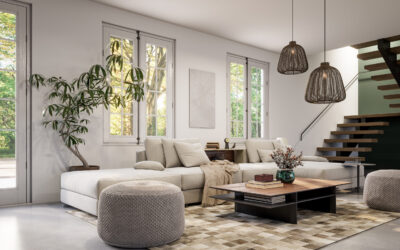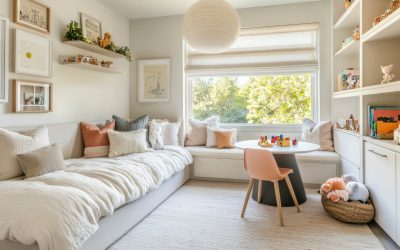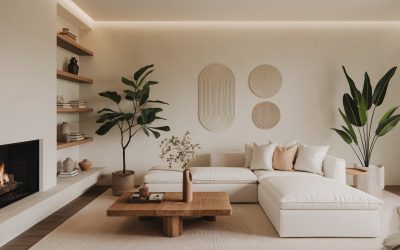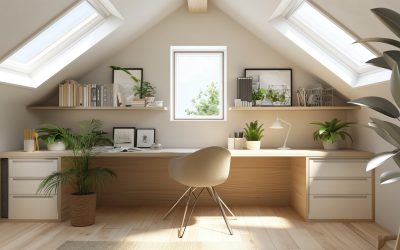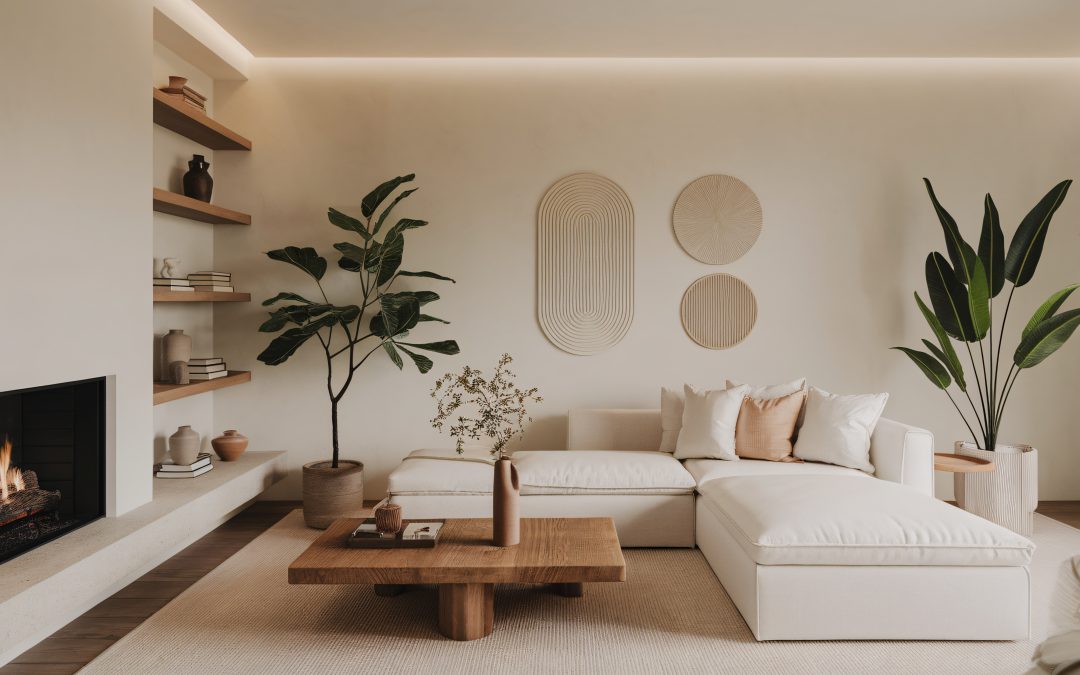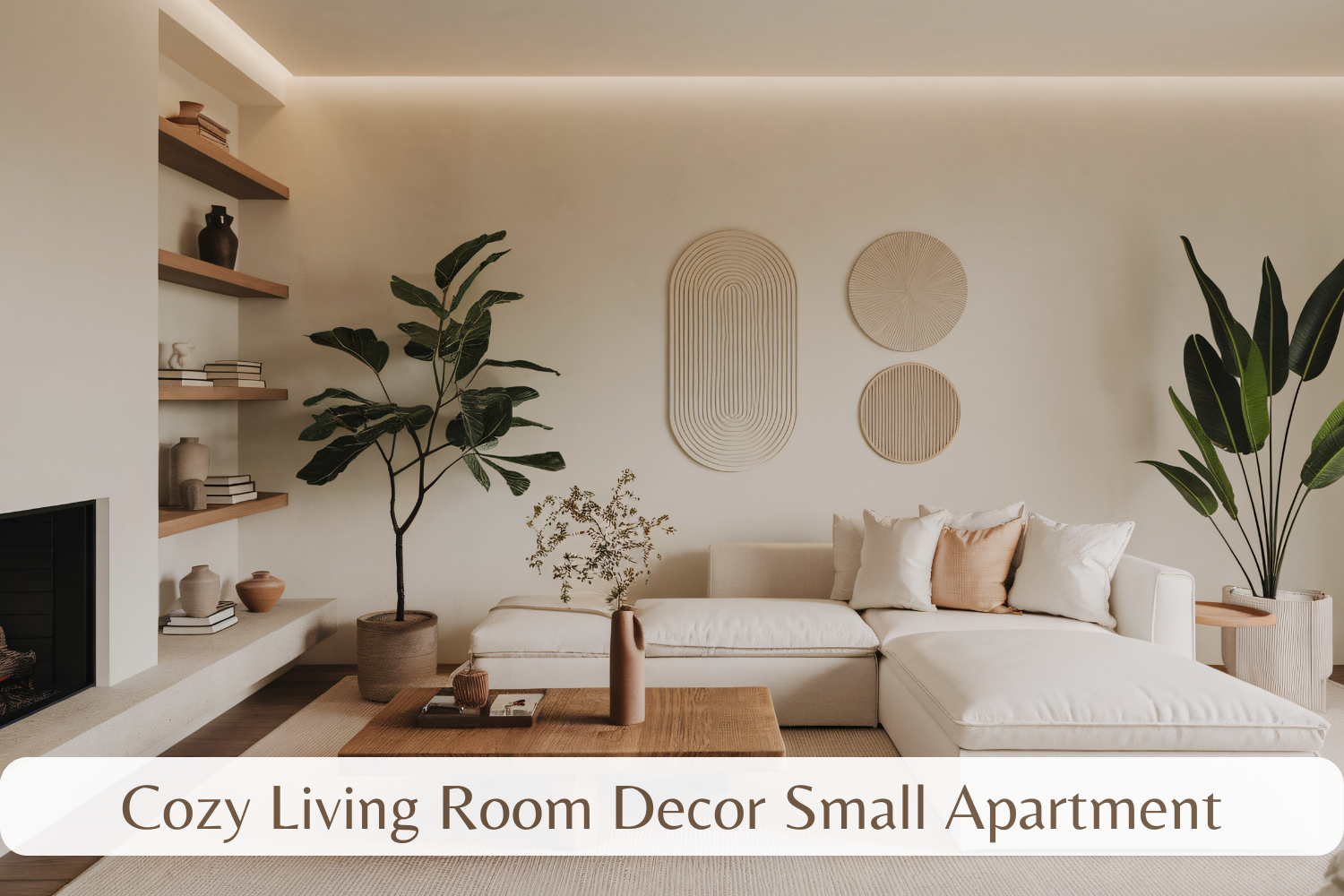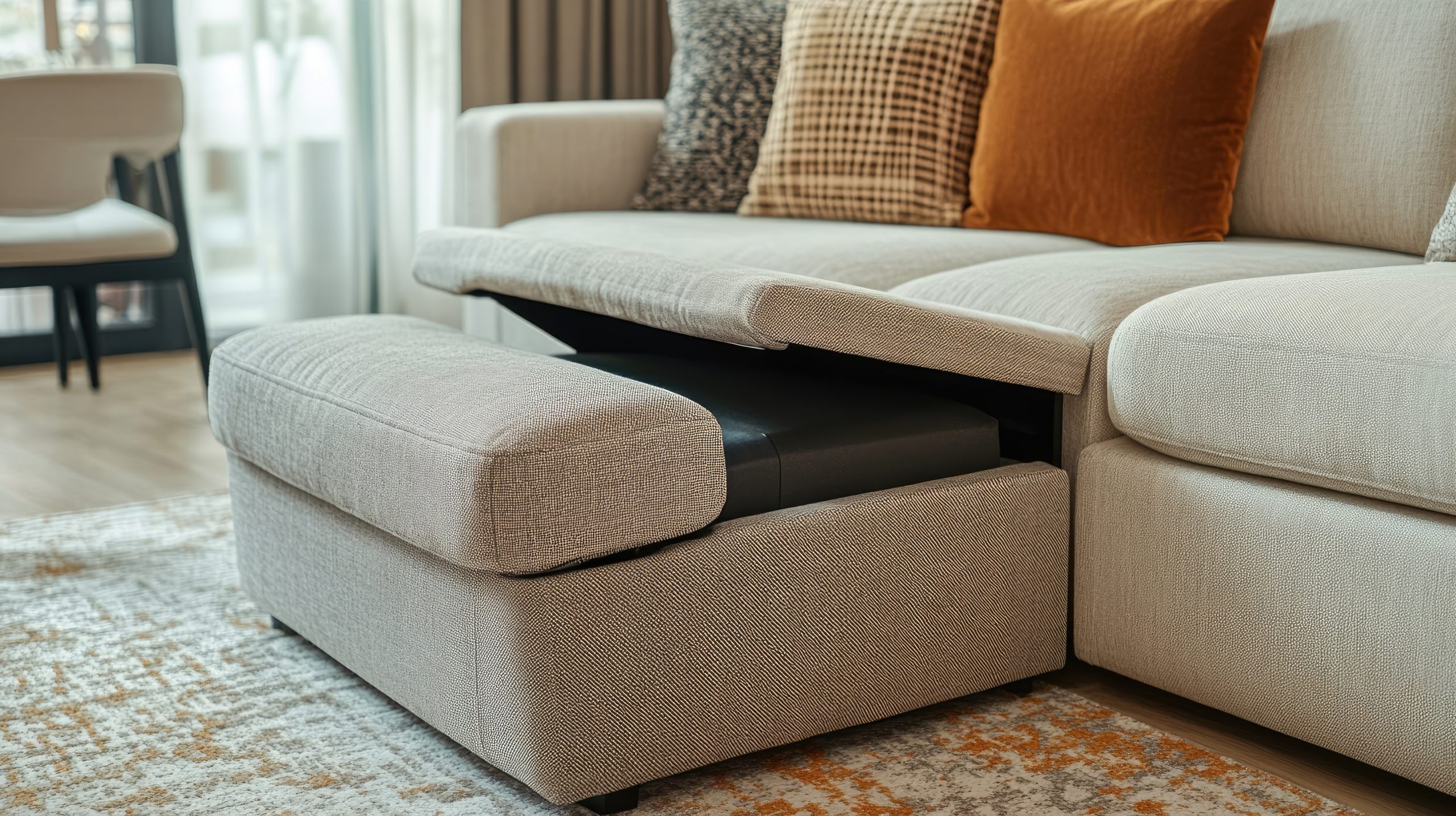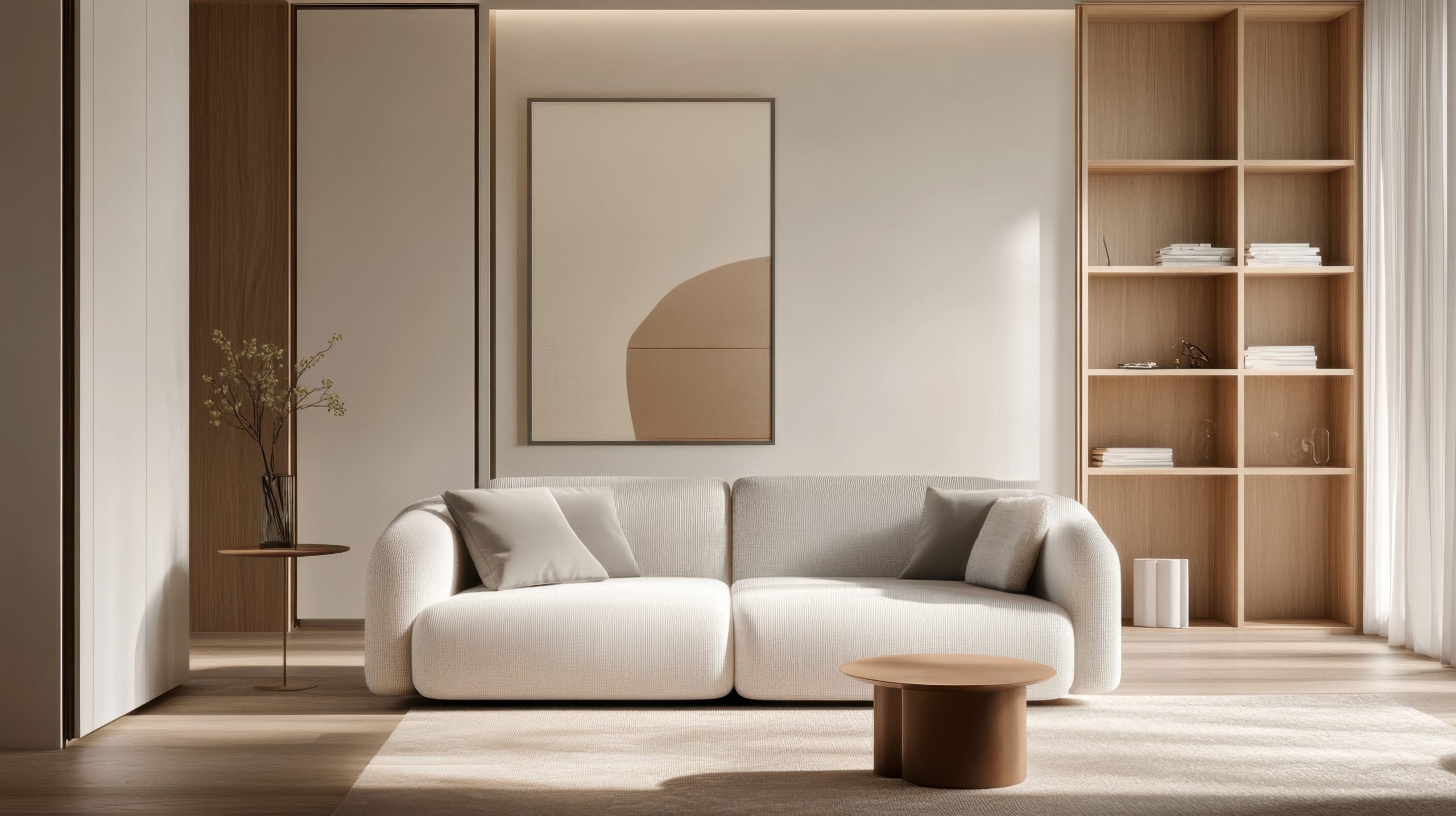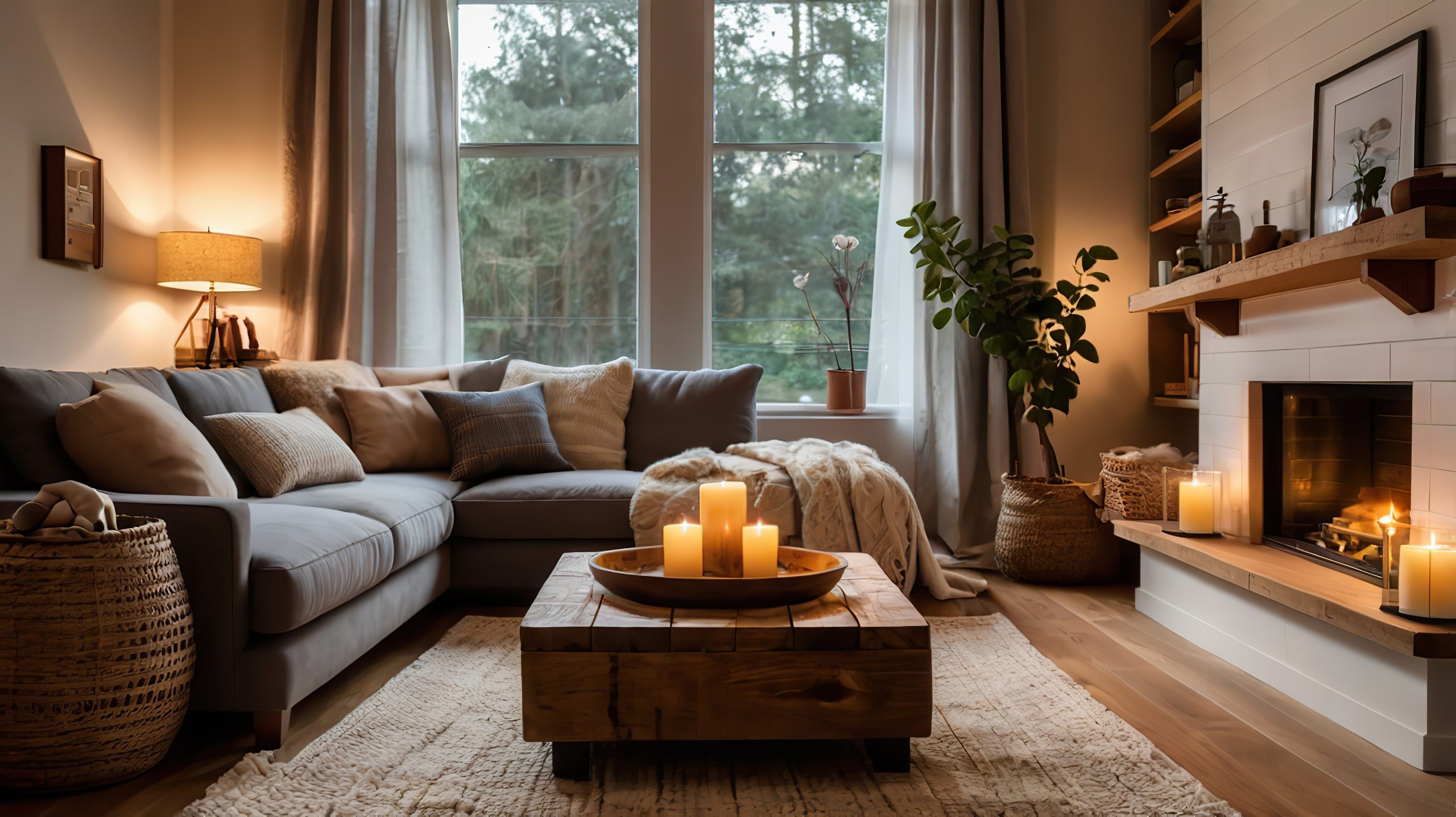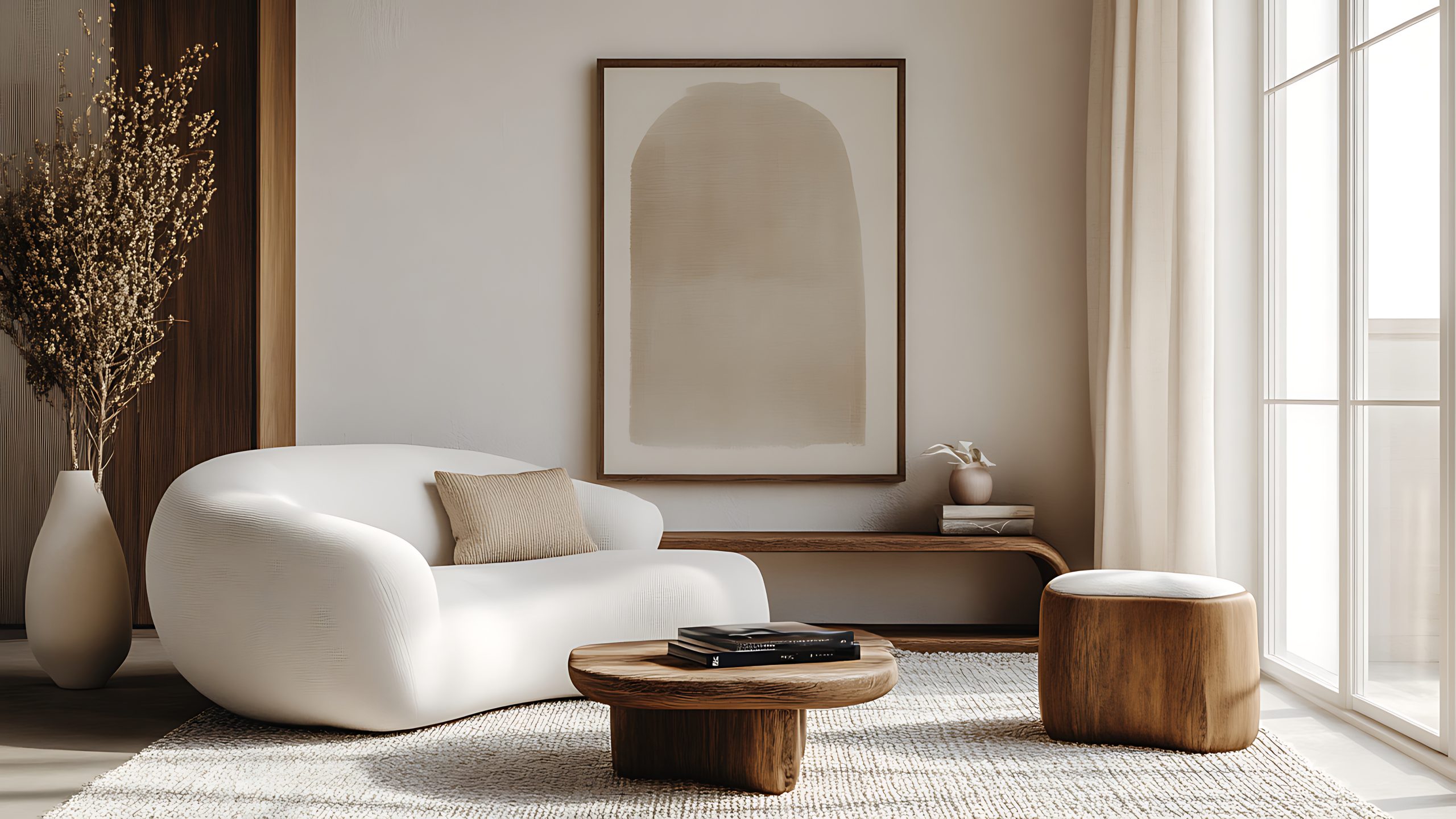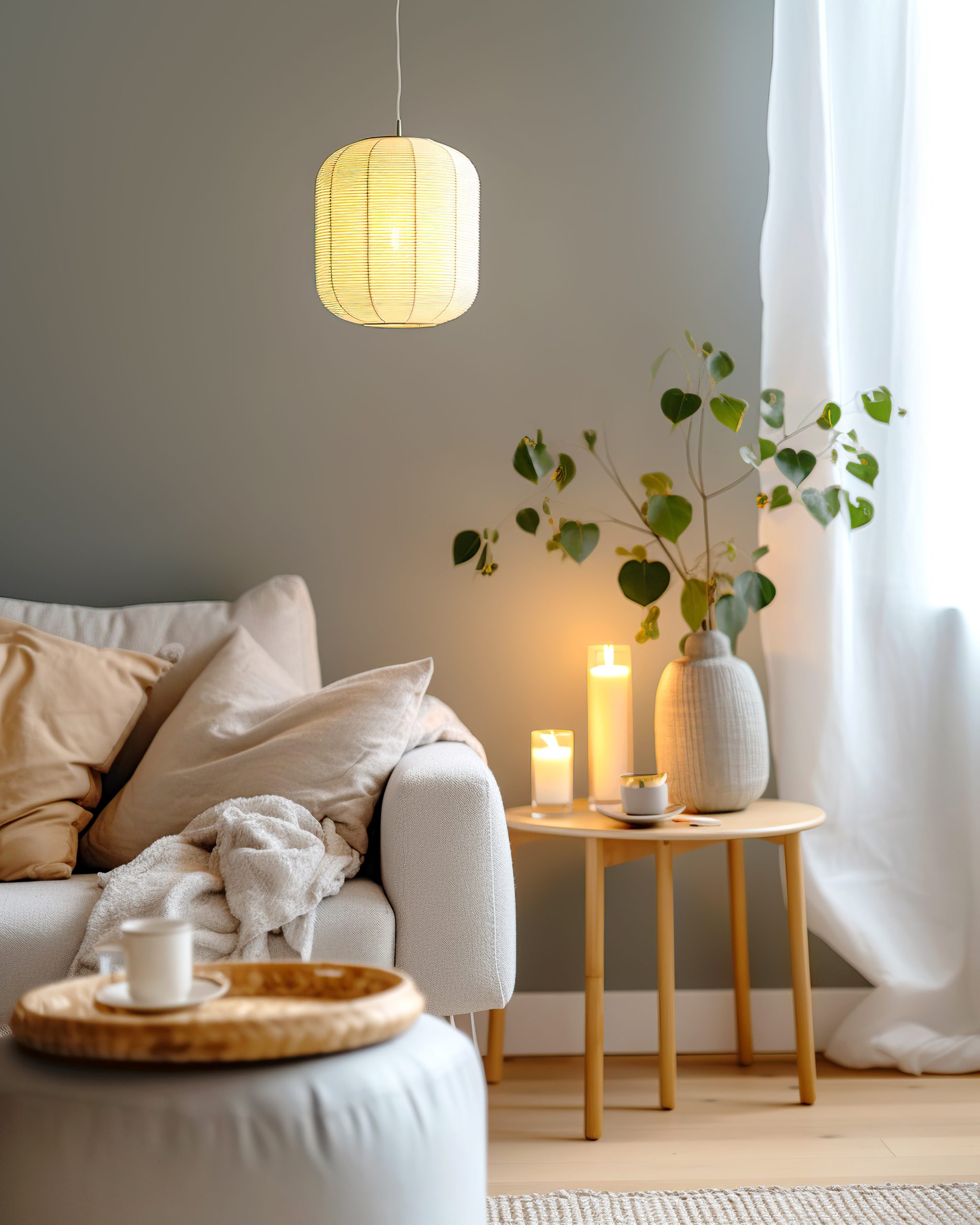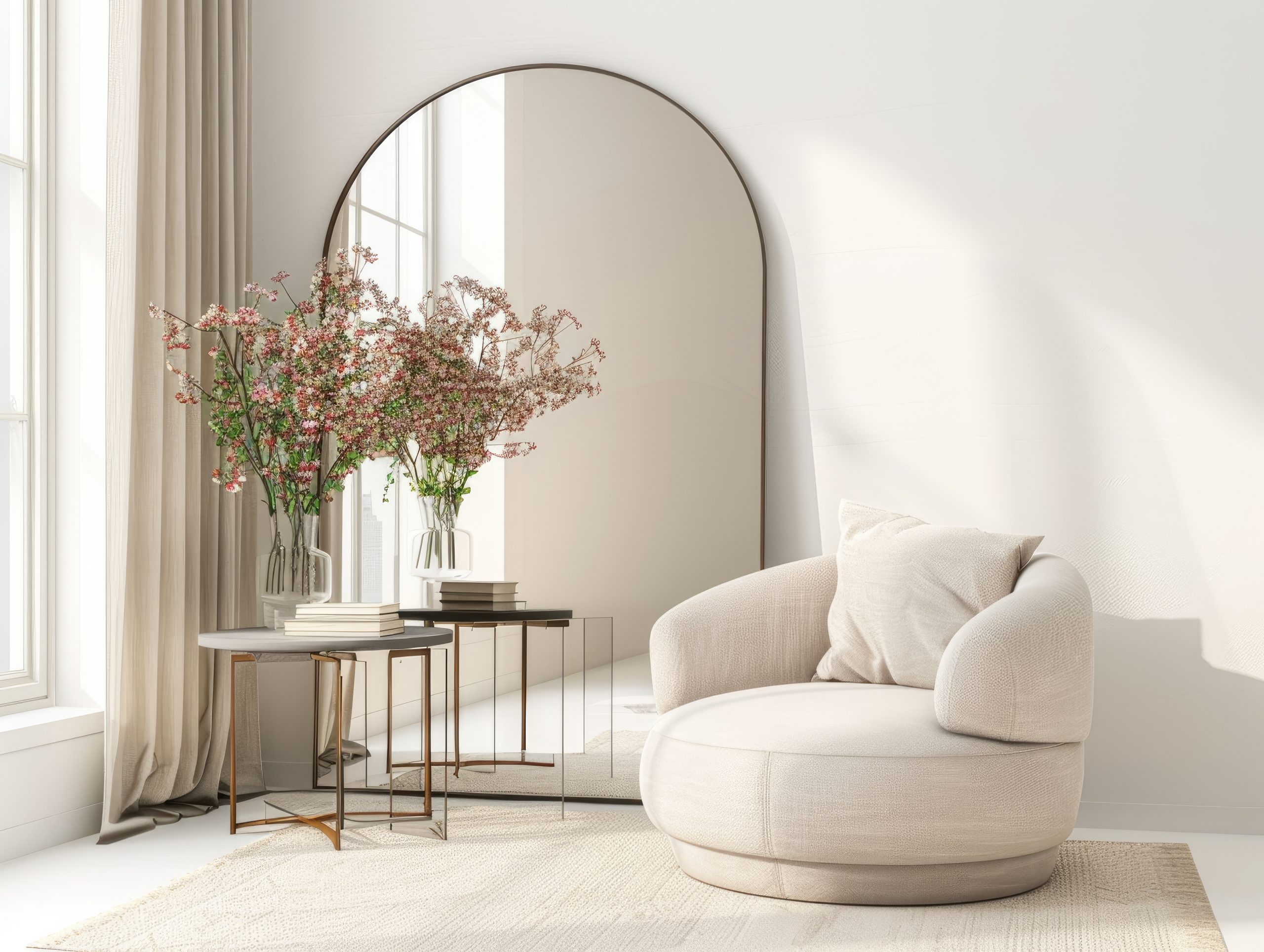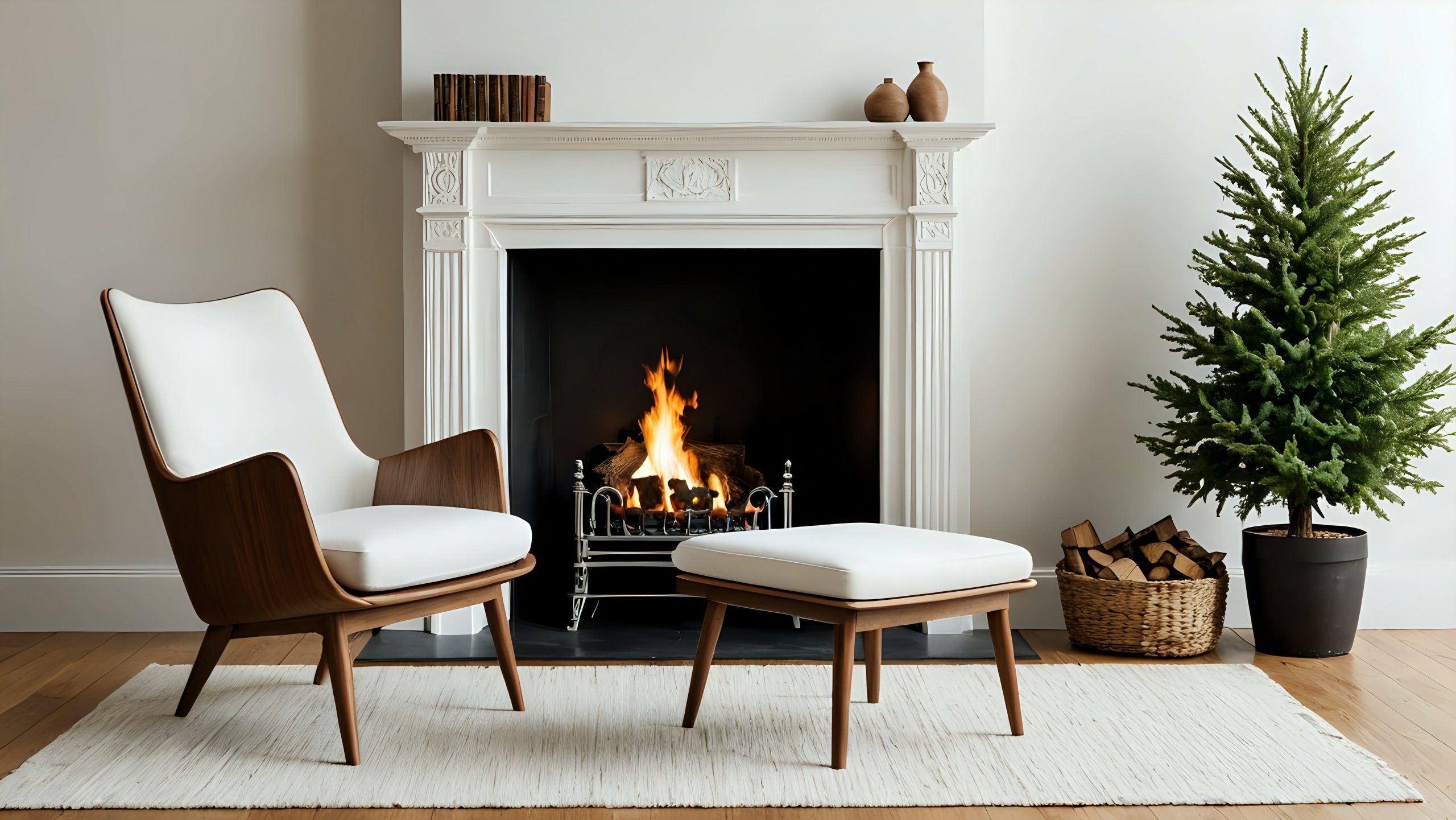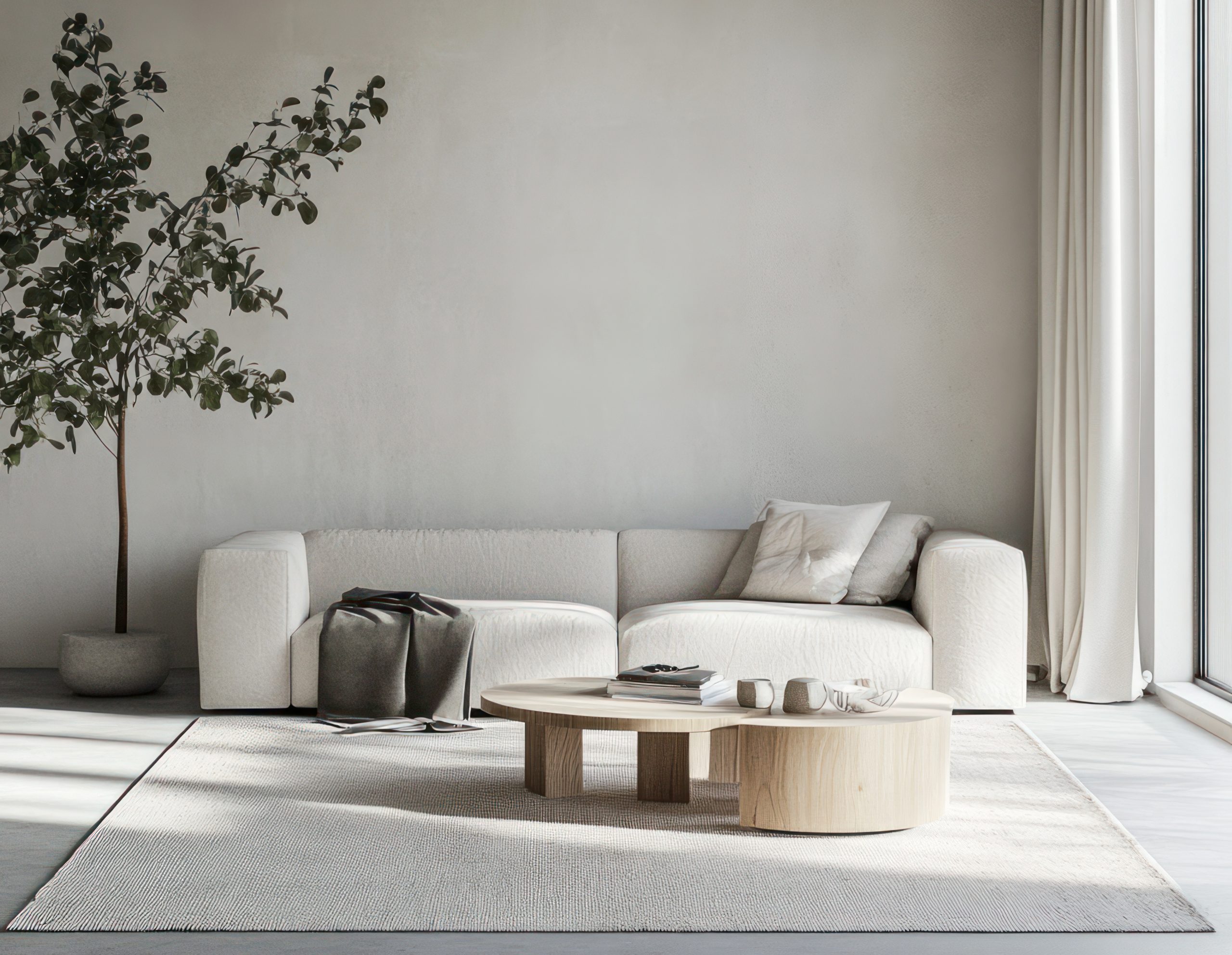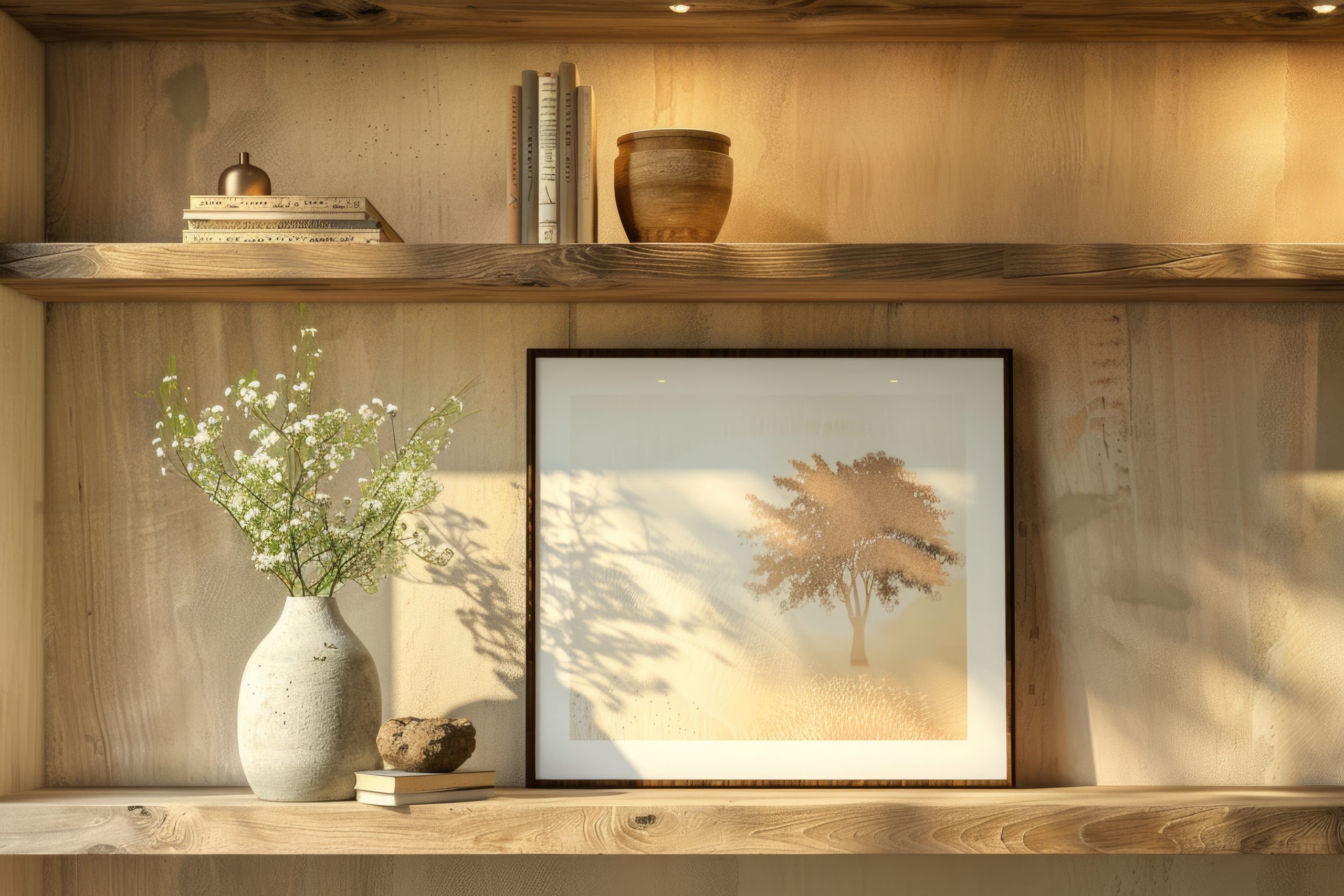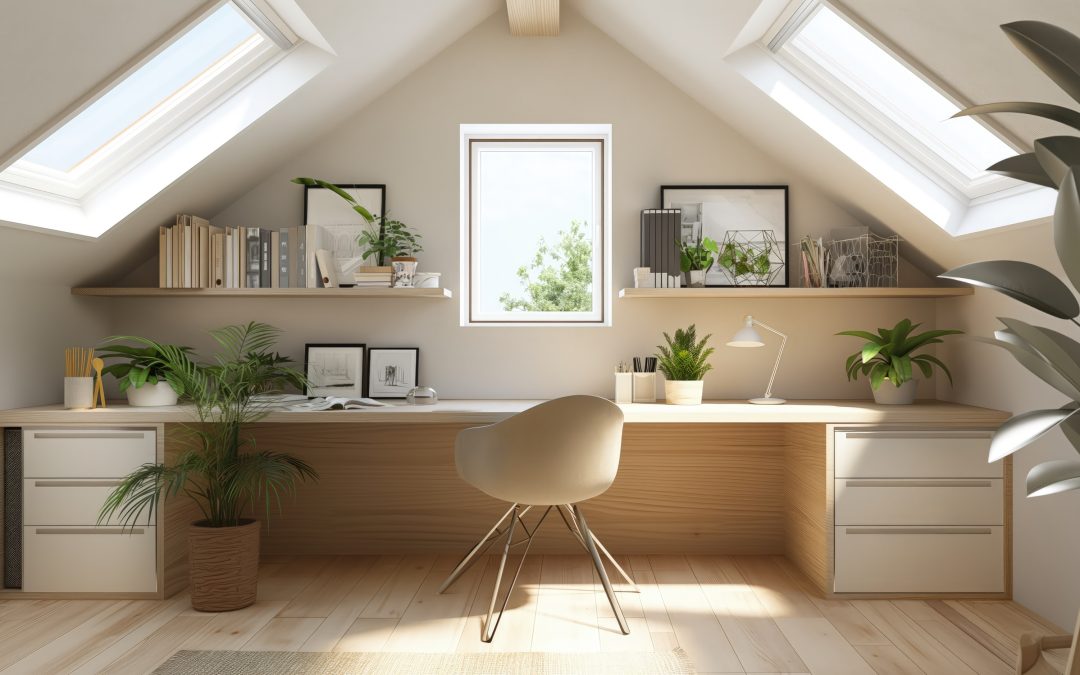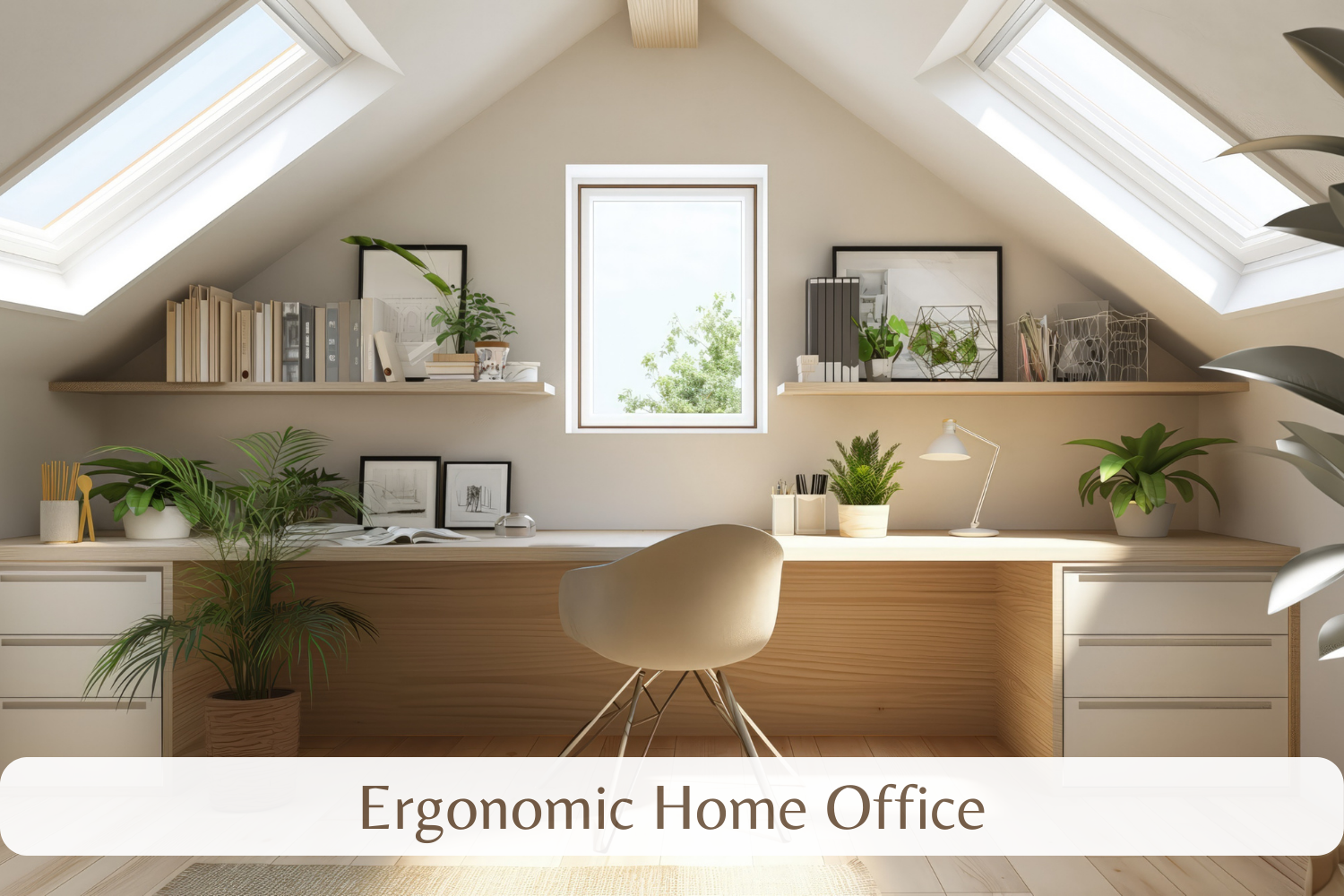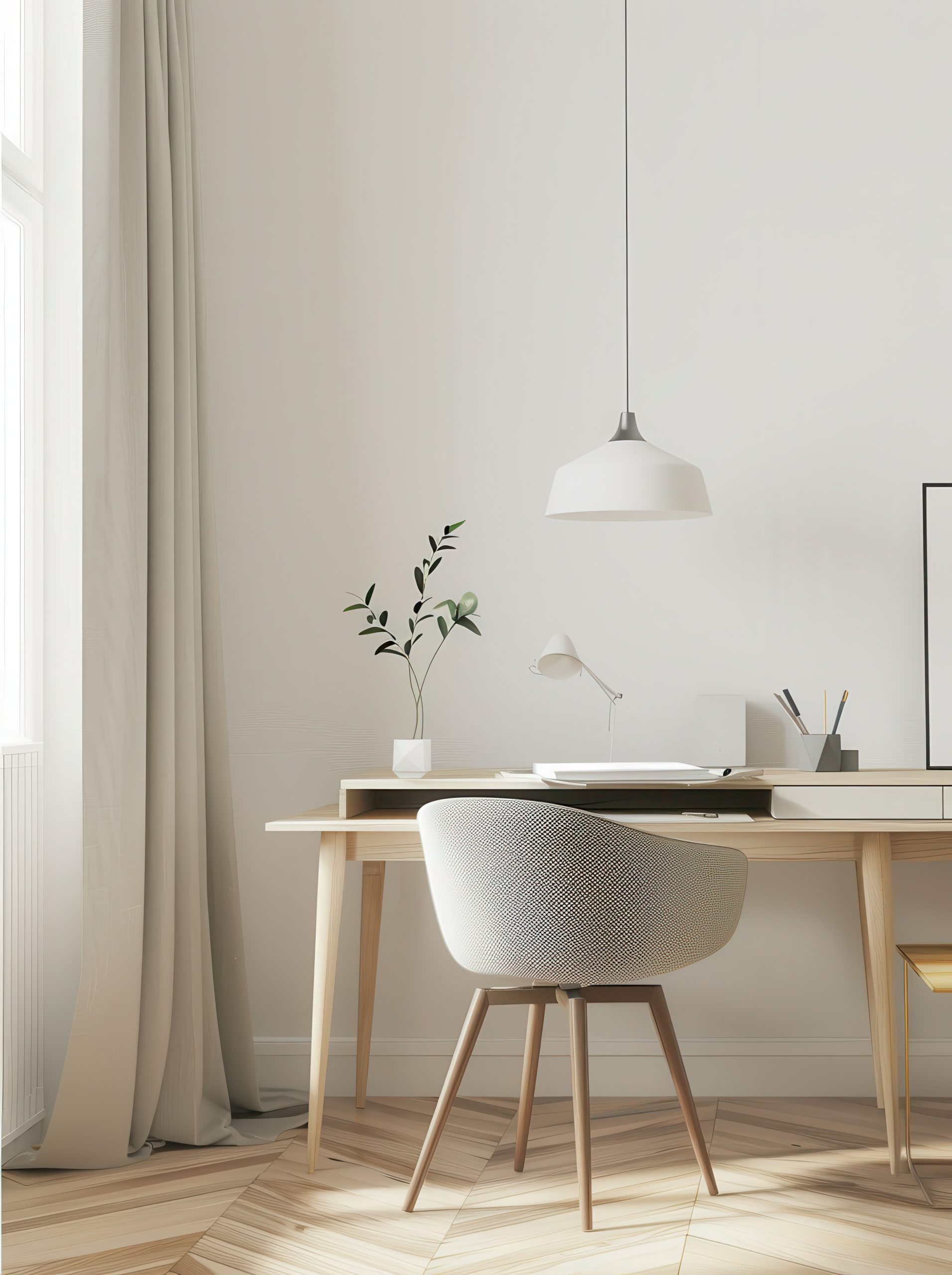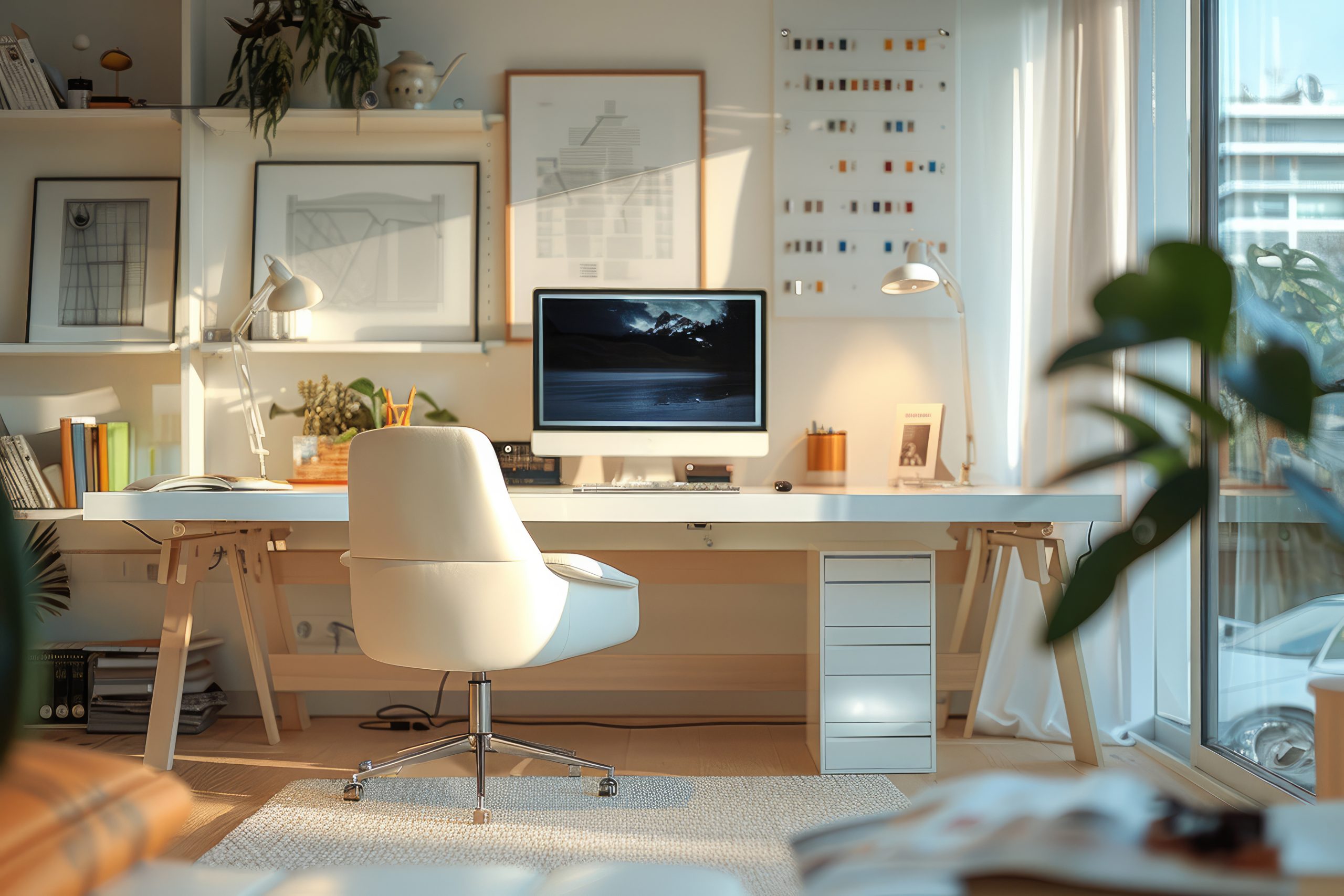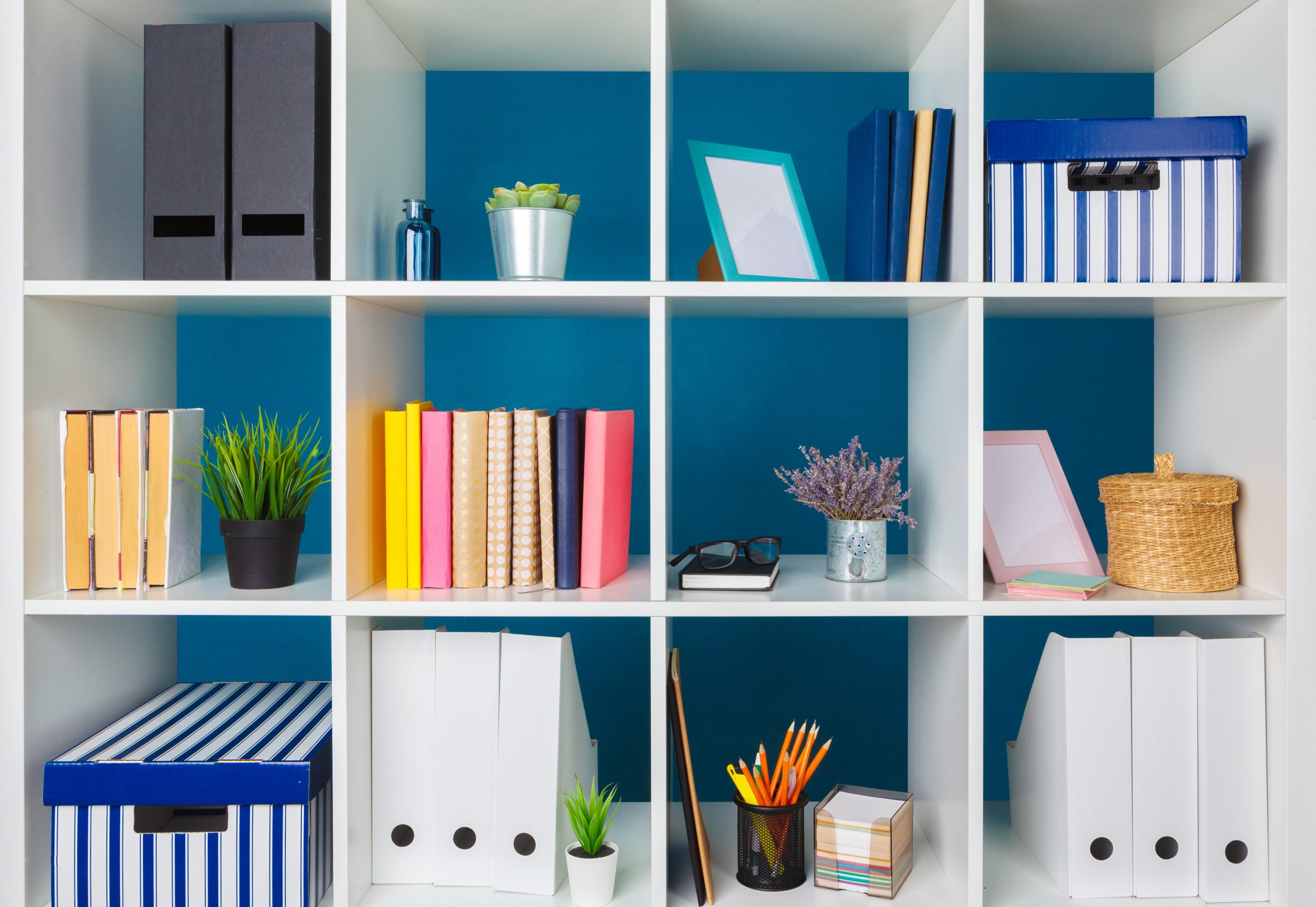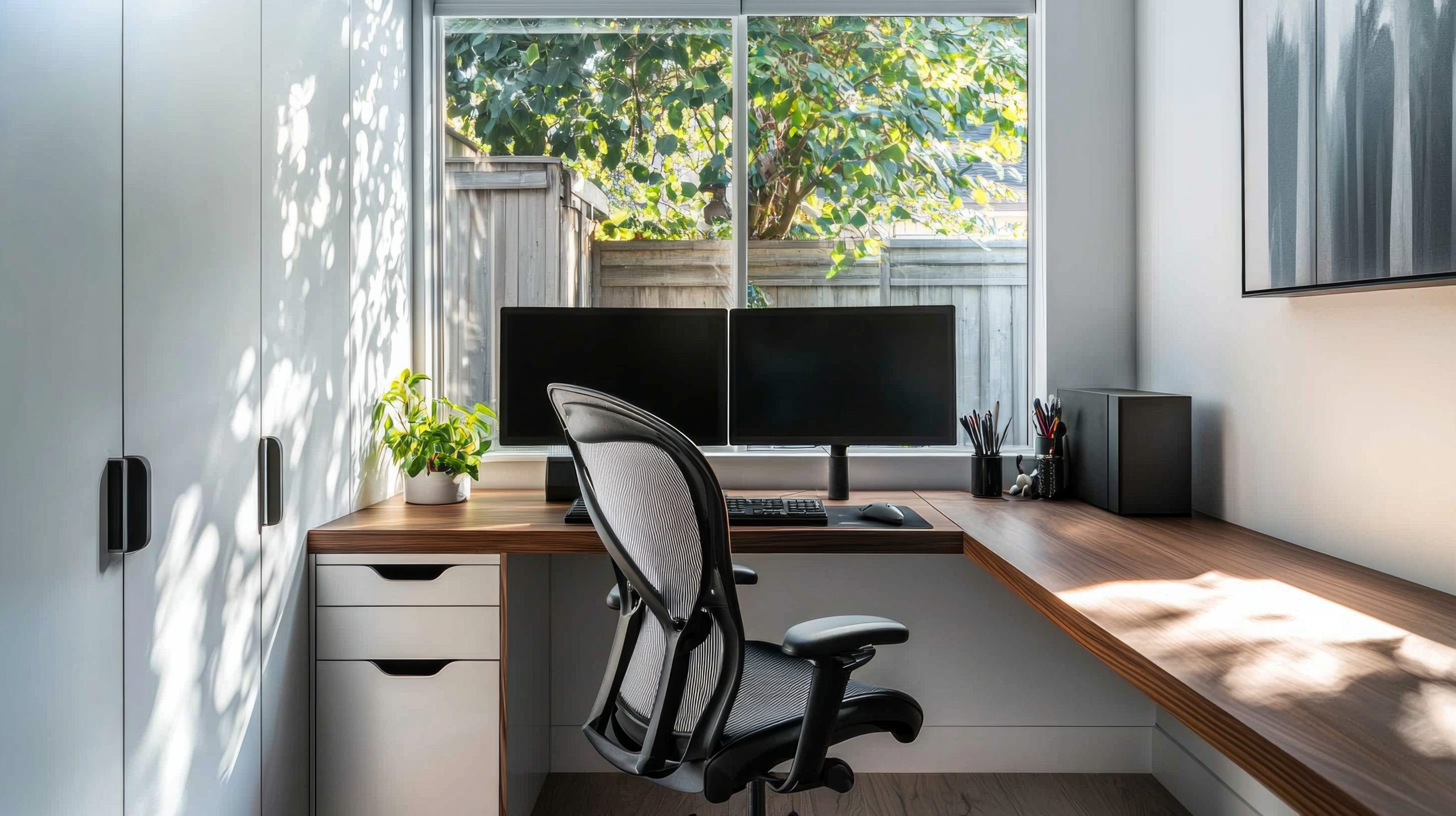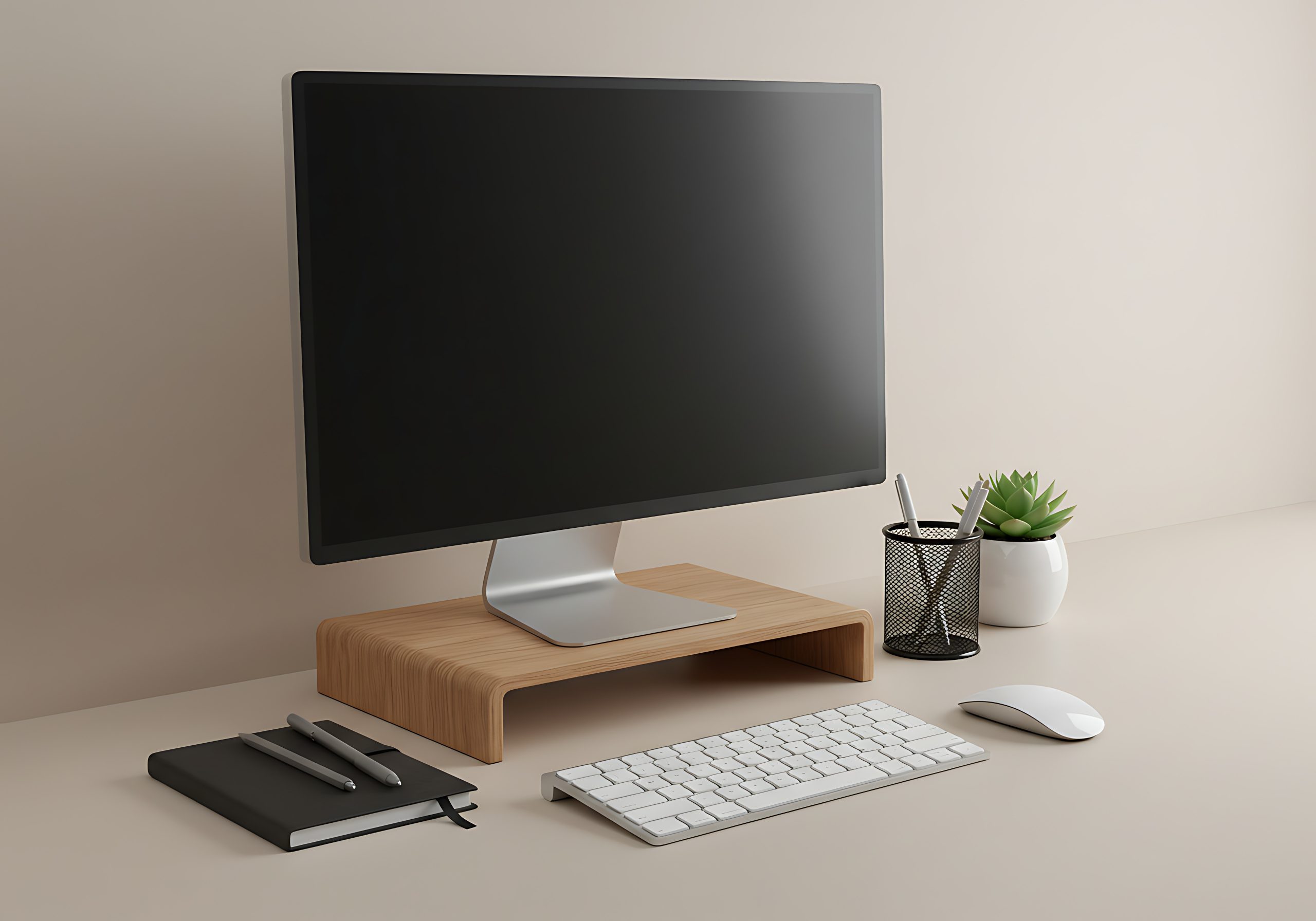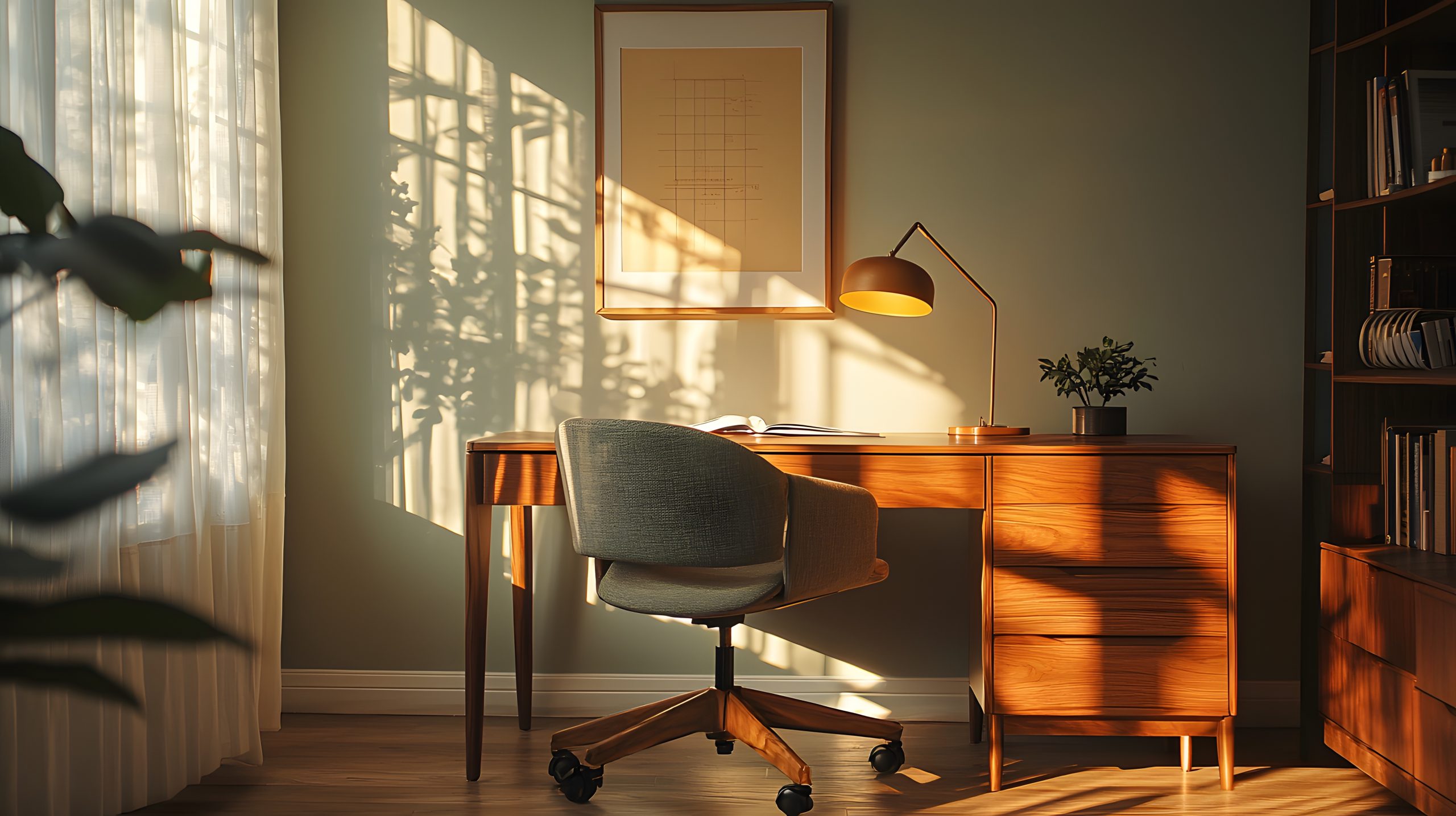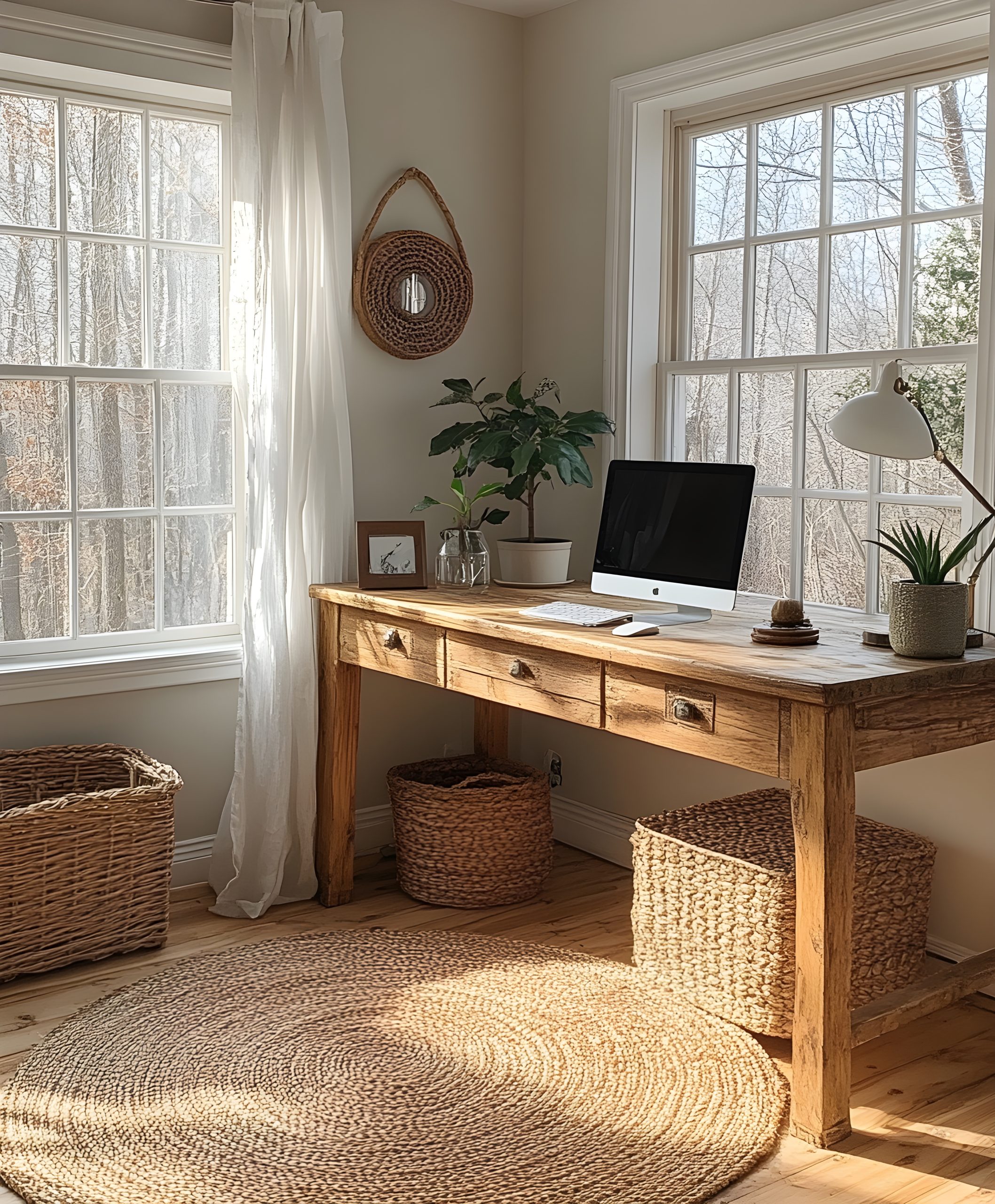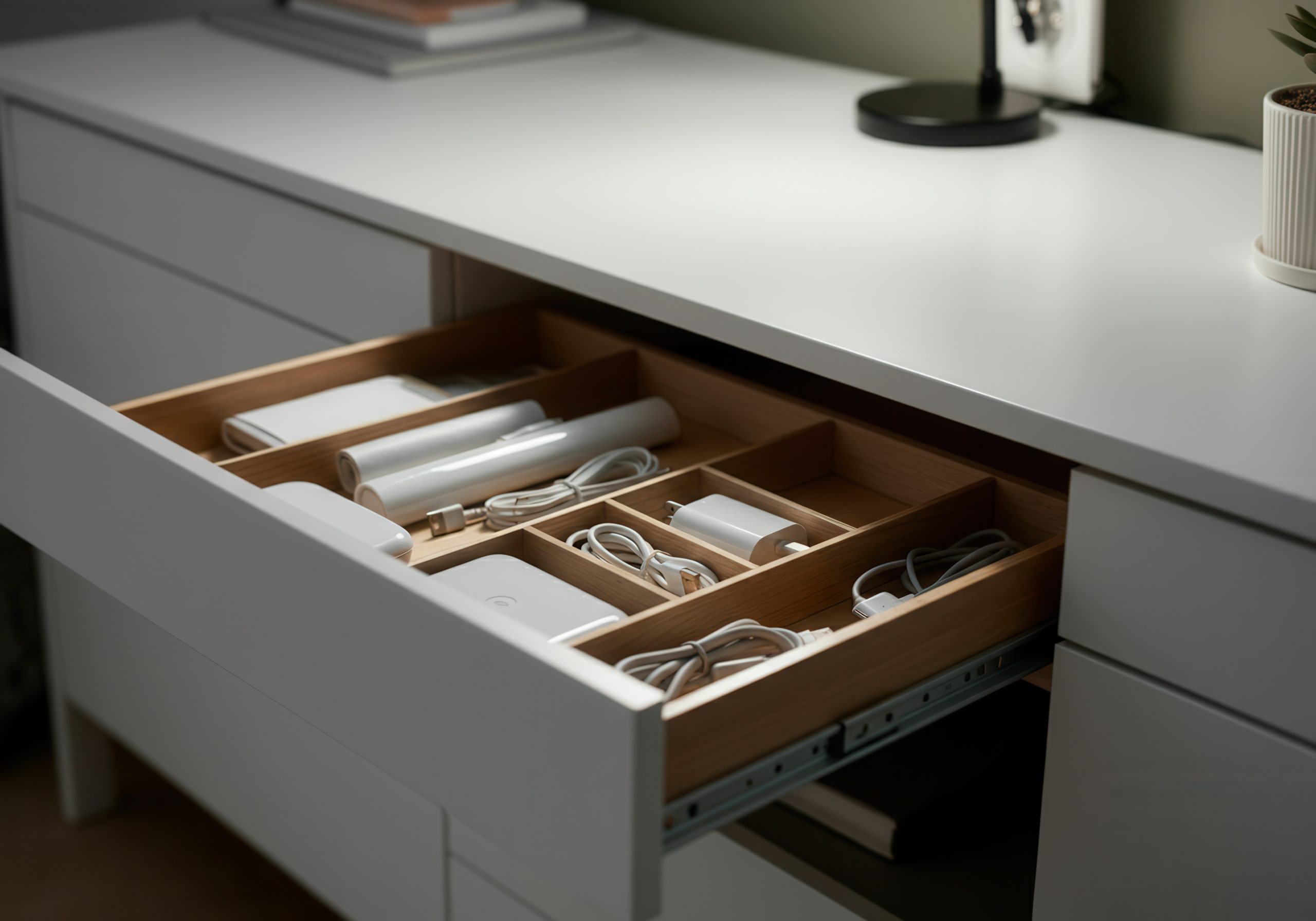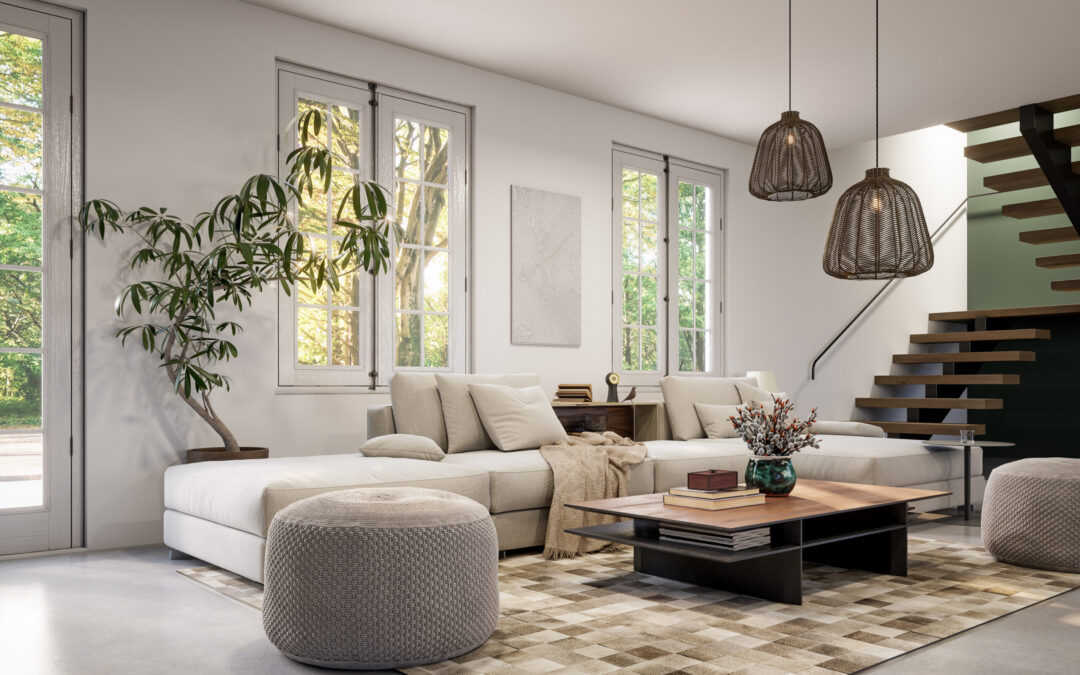
by Kesaa Interiors | Beginner Design Guides, DESIGN GUIDES, Furniture & Layout Guides, Living Room, Room-by-Room Guides, ROOMS
This post is all about How to decorate a living room step by step.
The living room is where life happens. It’s where we unwind after long days, gather with friends, and create countless memories. Yet for many homeowners, decorating this central space feels overwhelming. I’ve spent over a decade helping people transform their living rooms. I’ve learned that the key isn’t having an unlimited budget or innate design talent—it’s following a clear, systematic approach.
Learning how to decorate a living room step by step removes the guesswork and helps you make confident decisions. Instead of randomly buying pieces that might not work together, you’ll develop a cohesive plan that reflects your lifestyle and personality. This guide breaks down the entire process into manageable phases, from initial planning to those final styling touches that pull everything together.
Whether you’re starting with an empty room or refreshing an existing space, these steps will help you create a living room that’s both beautiful and functional. No design degree required—just a willingness to follow the process and trust your instincts along the way.
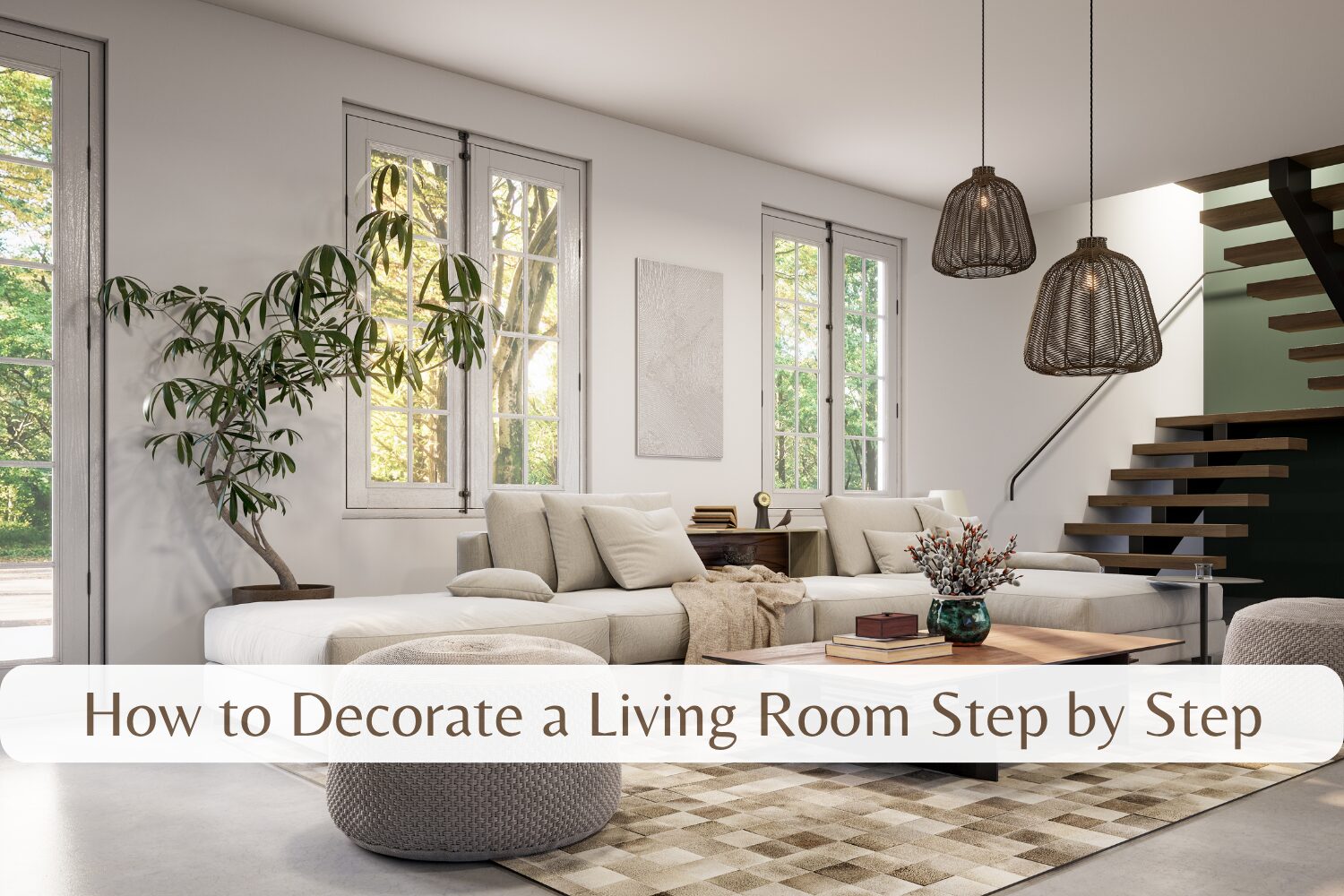
Step 1: Assess Your Space and Set Clear Goals
Before choosing a single paint colour or furniture piece, you need to understand what you’re working with. This foundational step often gets skipped, but it’s crucial for decorating a living room that actually works for your life.
Taking Stock of Your Space
Start by grabbing a measuring tape and a notebook. Document every dimension—wall lengths, ceiling height, window and door placements—and note where your electrical outlets and cable connections are located. These practical details will guide every decision you make later.
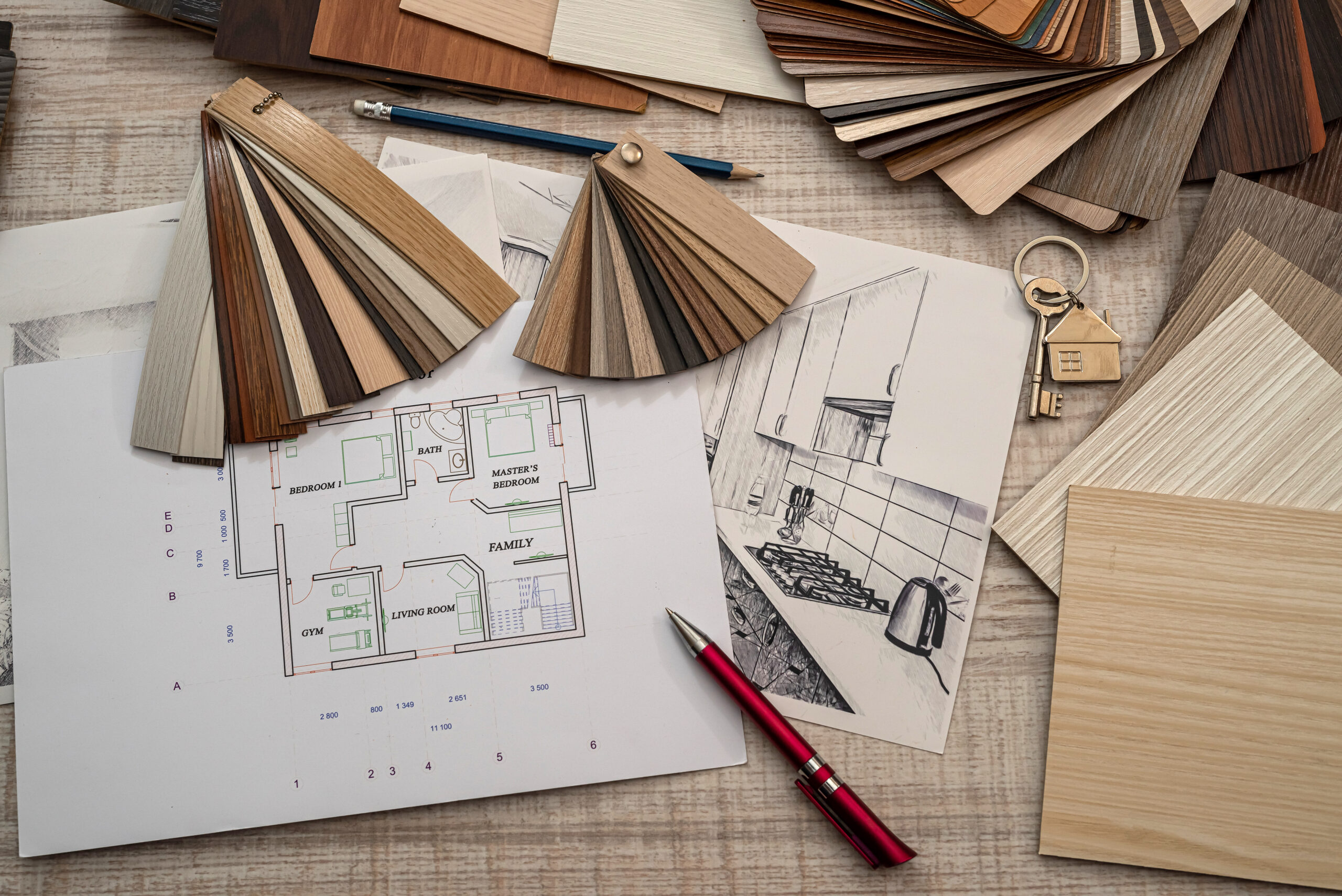
Pay attention to architectural features too. That awkward corner or structural column might seem like a challenge now, but it could become a design opportunity. Maybe it’s the perfect spot for a reading chair or a place to showcase tall plants. Understanding your room’s quirks helps you work with them rather than against them.
Understanding How You’ll Actually Use the Room
Here’s where many people get tripped up—they design for a fantasy lifestyle instead of their real one. If you have young kids, that pristine white sofa might not be your best choice. Love hosting game nights? You’ll need flexible seating arrangements and good lighting. Work from home occasionally? Consider incorporating a small desk area that doesn’t dominate the space.
Think about your daily routines. Do you watch TV every evening? The layout should support comfortable viewing angles. Prefer reading? Plan for task lighting and a cosy corner. When you understand how to decorate a living room step by step based on actual use, you create a space that enhances your life rather than complicating it.
Analysing Natural Light Patterns
Spend a day observing how light moves through your room. Where does the morning sun hit? Which areas stay dim in the afternoon? This information shapes everything from paint colour choices to furniture placement. North-facing rooms need warmer colours to counteract cool light, while south-facing spaces can handle cooler tones.

Setting a Realistic Budget
Money talk isn’t glamorous, but it’s essential. Determine your total budget, then break it down: roughly 30% for major furniture, 20% for lighting, 15% for window treatments, 15% for accessories and art, and keep 20% as a buffer. This framework keeps you from blowing everything on a gorgeous sofa while forgetting you need lamps and curtains.
Remember, you don’t need to buy everything at once. Prioritise the essentials—seating, lighting, and window treatments—then layer in accessories over time. Quality basics with budget-friendly accents often look better than trying to furnish everything cheaply at once.
Creating Your Project Timeline
Decorating doesn’t happen overnight, especially if you’re doing it right. Map out a realistic timeline. Furniture delivery alone can take 8-12 weeks for custom pieces. Paint needs proper drying time between coats. If you’re planning any electrical work for new lighting, that needs to happen before painting.

By thoroughly assessing your space and setting clear goals, you’ve laid the groundwork for every decision ahead. This might feel like a lot of prep work, but trust me—spending time on this foundation saves countless headaches later. Now you’re ready to move into the fun part: defining your style and making design choices that bring your vision to life.
Step 2: Define Your Design Style and Create a Vision
Now that you understand your space and needs, it’s time to figure out what you actually want your living room to look and feel like. This step is where many people freeze up, worried about making the “wrong” choice. Here’s the thing—there’s no wrong choice if it reflects who you are and how you live.
Discovering Your Personal Style
Start by collecting images of living rooms that make you stop scrolling. Pinterest, design magazines, even screenshots from your favourite shows—gather them all. After collecting 20-30 images, patterns will emerge. Maybe you’re drawn to rooms with lots of natural wood and cosy textiles. Or perhaps sleek lines and minimal colour palettes keep catching your eye.
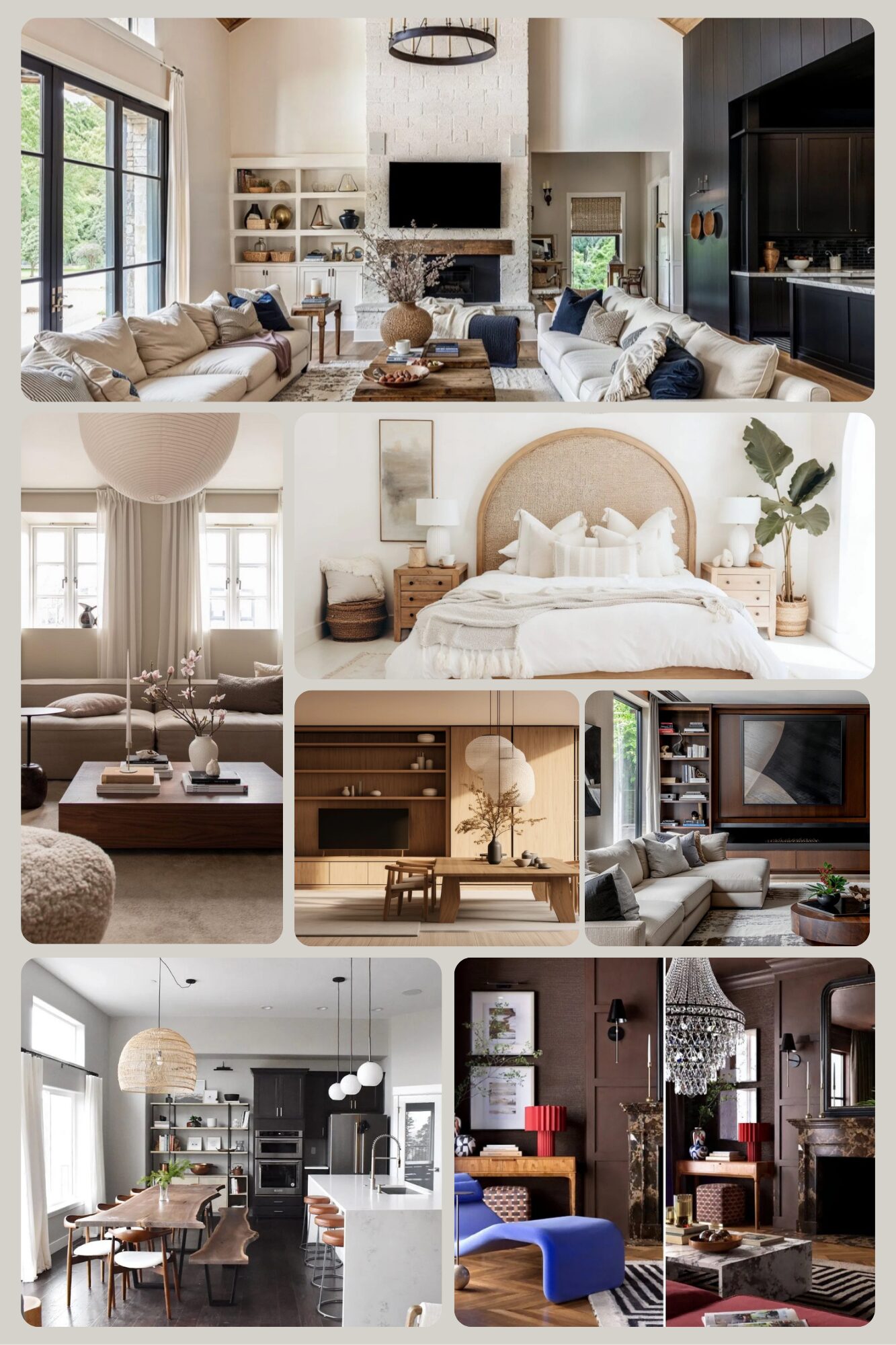
Don’t worry about naming your style yet. Focus on identifying what elements consistently appeal to you:
- Colour preferences (bright and bold vs. neutral and subtle)
- Material choices (warm woods vs. cool metals)
- Overall feeling (cosy and layered vs. clean and minimal)
- Pattern tolerance (mix of prints vs. solid colours)
Understanding Major Design Styles
While you don’t need to follow any style rigidly, knowing the basics helps you communicate what you want and shop more effectively. Here are the styles I see requested most often:
Modern/Contemporary: Clean lines, neutral colours, minimal accessories. The furniture has simple silhouettes, and the overall feel is uncluttered. Great for those who find peace in simplicity.
Traditional: Classic furniture shapes, rich colours, balanced symmetry. Think rolled-arm sofas, matching table lamps, and formal arrangements. Perfect if you love timeless elegance.
Transitional: The sweet spot between traditional and contemporary. You get the comfort of classic pieces with cleaner lines and updated colours. This style is incredibly livable and never looks dated.
Scandinavian: Light woods, white walls, cosy textures, and functional beauty. If you want a bright, airy space that still feels warm, this might be your direction.
Industrial: Raw materials, exposed elements, darker colours. Metal and wood combinations, vintage pieces, and an urban edge define this look.
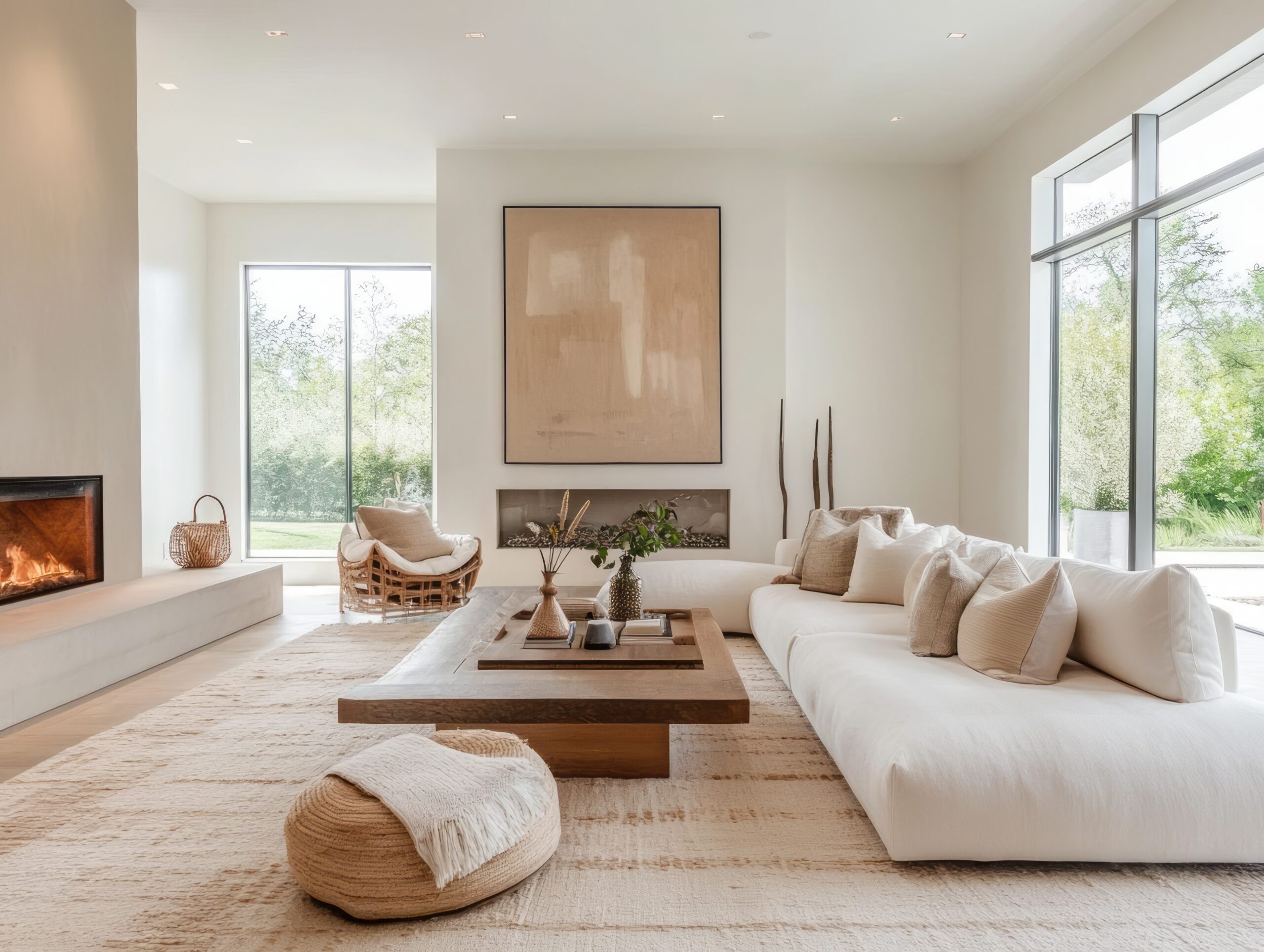
Creating Your Vision Board
Once you’ve identified your preferences, create a focused vision board for your specific living room. This isn’t just pretty pictures—it’s your roadmap for how to decorate a living room step by step. Include:
- 3-5 full-room images that capture your desired vibe
- Close-ups of textures and materials you love
- Your colour palette (we’ll refine this in the next step)
- Furniture styles that appeal to you
- Lighting fixtures that fit your aesthetic
Digital tools like Canva or even a simple Pinterest board work great. The goal is to have a visual reference you can check when making decisions. That gorgeous velvet chair might be on sale, but does it fit your vision?
Avoiding Common Style Pitfalls
The biggest mistake I see? Trying to incorporate too many styles because you like elements of each. Your living room isn’t a design museum—it needs cohesion. Follow the 80/20 rule: 80% of your room should reflect your primary style, with 20% for accent pieces that add personality.
Another trap is choosing a style that doesn’t match your lifestyle. That all-white, minimalist living room looks stunning in photos, but if you have three dogs and love surrounding yourself with books and plants, you’re setting yourself up for frustration.
Considering Your Home’s Architecture
Your living room doesn’t exist in isolation. Consider your home’s architectural style and the flow from adjacent spaces. An ultra-modern living room might feel jarring in a 1920s bungalow with original mouldings. This doesn’t mean you can’t have contemporary furniture, but you’ll want to choose pieces that respect the home’s character.
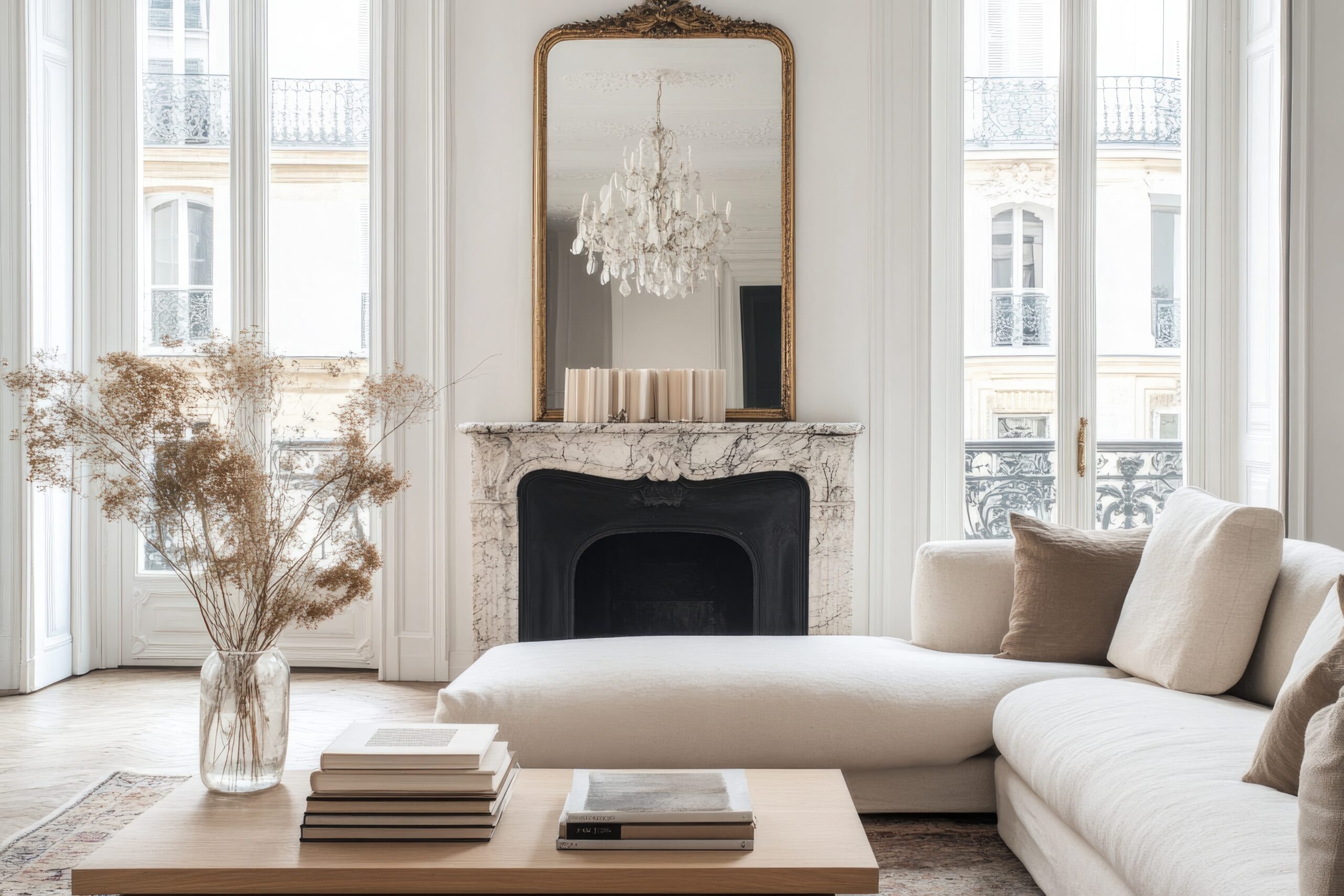
Making It Personal
Whatever style direction you choose, remember that the best living rooms tell a story about the people who live there. Your style foundation should leave room for:
- Travel souvenirs and meaningful objects
- Family photos and personal artwork
- Collections and hobbies
- Books, plants, and things that bring you joy
These personal touches are what transform a styled space into a home. They’re not afterthoughts—plan for them from the beginning.
By the end of this step, you should have a clear vision of your living room’s style direction. This vision will guide every choice from here on, making the process of learning how to decorate a living room step by step much more straightforward. Next, we’ll translate this vision into a functional floor plan that brings your style to life.
Step 3: Plan Your Layout and Traffic Flow
With your style vision clear, it’s time to tackle one of the most crucial aspects of living room design—the layout. Even the most beautiful furniture and decor won’t save a room with poor flow. Getting this right transforms how your space functions daily.
Finding Your Focal Point
Every well-designed living room needs a focal point—that one element that naturally draws the eye and anchors the entire space. Sometimes it’s obvious: a fireplace, a wall of windows with a stunning view, or built-in shelving. Other times, you’ll need to create one.
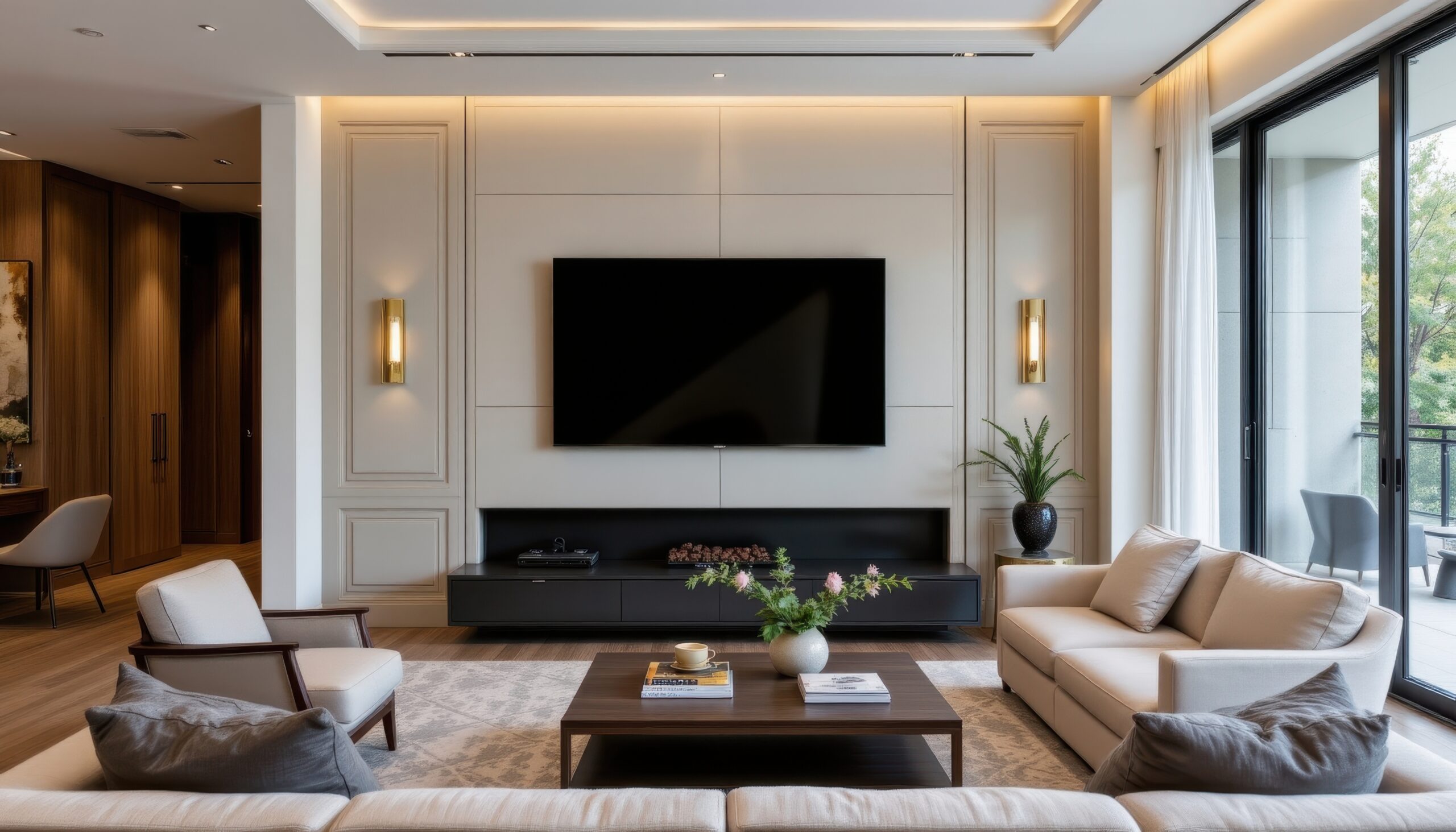
If your room lacks a natural focal point, consider these options:
- A large piece of artwork or a gallery wall
- An entertainment centre or a mounted TV
- A statement furniture piece
- An accent wall with bold colours or wallpaper
Once identified, your furniture arrangement should acknowledge and enhance this focal point, not compete with it. That doesn’t mean everything faces one direction like a waiting room—it means creating a layout that feels balanced around this anchor.
Understanding Conversation Flow
The best living rooms encourage easy conversation. When figuring out how to decorate a living room step by step, remember that seating arrangements make or break the room’s social function. Keep these guidelines in mind:
- Place seating 8-10 feet apart for comfortable conversation
- Avoid forcing people to shout across the room or crane their necks
- Create multiple seating groups in larger rooms
- Ensure every seat has a surface nearby for drinks or books
Think about how conversations naturally happen. People need to see each other without straining, but also want the option to break eye contact naturally. Angled chairs, L-shaped sectionals, and mixed seating types all help create this dynamic.
Mapping Traffic Patterns
Before placing a single piece of furniture, trace the natural paths through your room. How do you enter? Where do you go from there? Are there doorways to other rooms? These invisible pathways need to stay clear, at least 3 feet wide for main routes, and 2 feet for secondary paths.
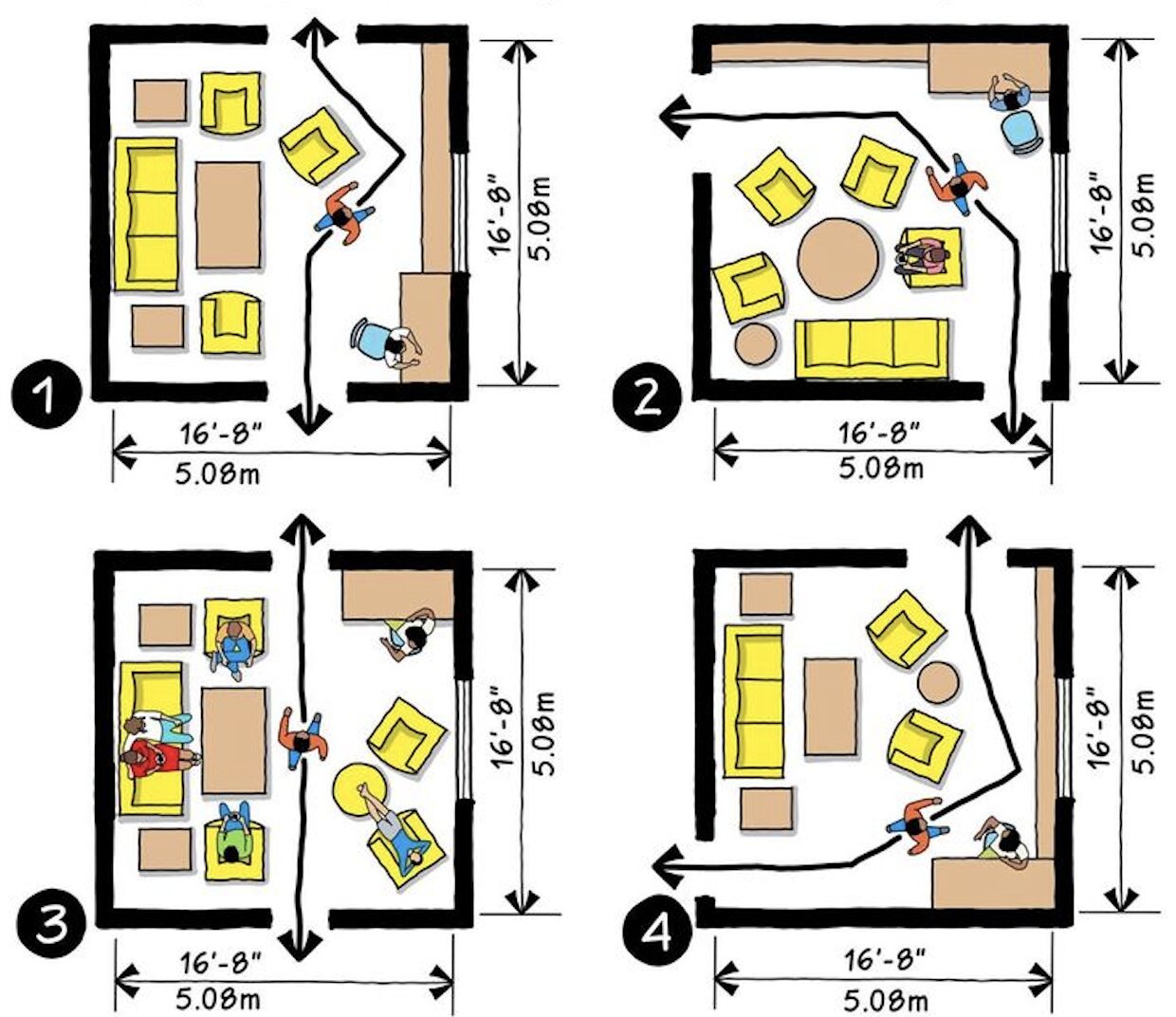
Common traffic flow mistakes include:
- Blocking the natural path from entry to seating
- Creating obstacle courses around coffee tables
- Forcing people to squeeze between furniture
- Ignoring the path to frequently used areas (like built-ins or windows)
The Power of Floating Furniture
Here’s where I see the biggest transformation in rooms—pulling furniture away from walls. Yes, even in small spaces. Floating your sofa even 12 inches from the wall creates depth and improves flow. It also gives you space for a console table, better lamp placement, or simply easier cleaning.
In larger rooms, floating furniture becomes essential. Create intimate zones rather than lining everything against the perimeter. A sofa floating in the centre with a console table behind it can define the living area while maintaining flow to other parts of the room.
Using Rugs to Define Spaces
Area rugs are your secret weapon for layout success. They ground furniture groupings and define zones within larger spaces. The key is sizing—too small, and your room looks disjointed. Follow these rules:
- The front legs of all major seating should sit on the rug
- Leave 8-24 inches of bare floor around the rug’s perimeter
- In small rooms, a large rug can make the space feel bigger
- Multiple rugs can define different zones in open-plan spaces
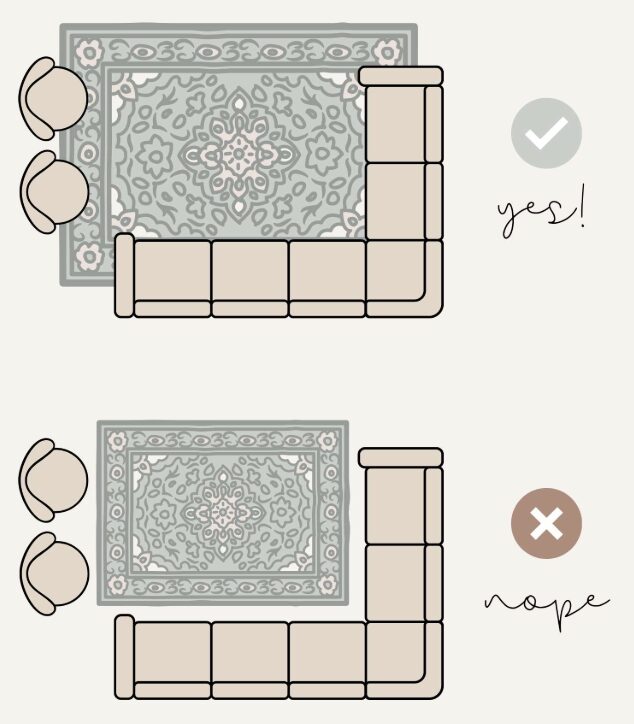
Testing Your Layout
Before moving heavy furniture, test your layout plan. Use painter’s tape to mark furniture footprints on the floor. Live with it for a day. Walk through your normal routines. Sit in the taped “chairs” and check sightlines. This simple step saves backaches and prevents costly mistakes.
For tech-savvy planners, free apps like Floorplanner or even graph paper work well. Draw your room to scale (1/4 inch = 1 foot is standard), then cut out scaled furniture pieces to arrange and rearrange.
Accommodating Different Activities
Modern living rooms multitask. Your layout needs to support various activities without requiring furniture reshuffling. Consider:
For TV watching: Ensure comfortable viewing angles from the main seating. The TV centre should be at seated eye level, typically 42-48 inches from the floor.
For reading: Position a chair near natural light with a side table for books and drinks. Add a floor lamp for evening reading.
For games or homework: An ottoman with a tray or nesting tables provides surfaces that can disappear when not needed.
For entertaining: Create seating clusters that can merge for larger gatherings. Lightweight accent chairs or poufs offer flexible extra seating.
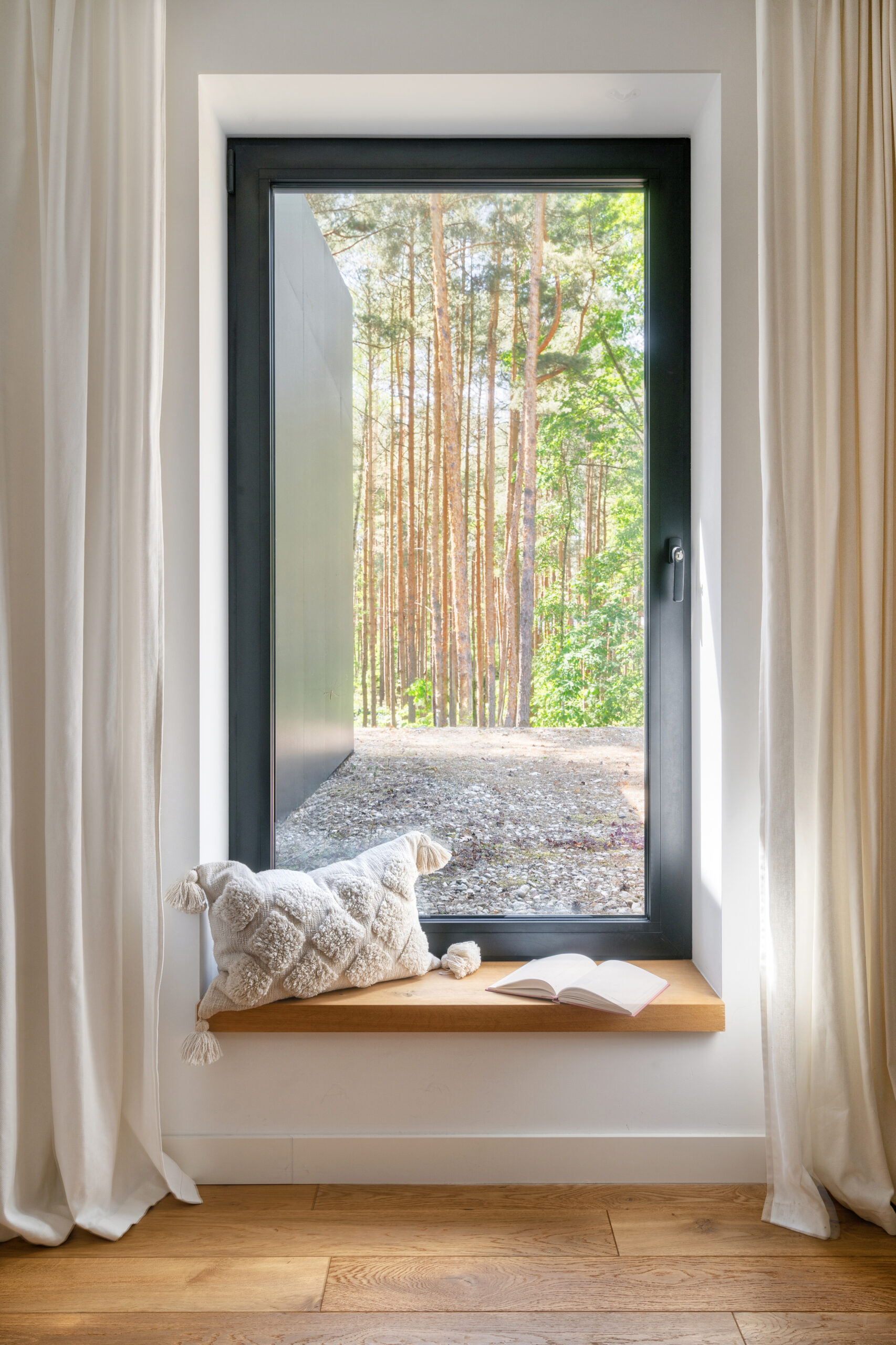
Small Room Strategies
Decorating a small living room step by step requires extra attention to the layout. Every inch counts, but that doesn’t mean cramming in undersized furniture. Instead:
- Choose one normal-sized sofa over multiple small chairs
- Use vertical space with tall bookcases or floating shelves
- Select furniture with exposed legs to maintain sight lines
- Consider dual-purpose pieces like storage ottomans
The goal is to make your small room feel as spacious as possible while meeting all your needs.
With your layout planned, you’ve created the bones of a functional living room. This foundation ensures that no matter how beautiful your colour choices or accessories, the room will work for daily life. Next, we’ll build on this practical layout with colour choices that bring your style vision to life.
Step 4: Choose Your Colour Palette
Colour sets the entire mood of your living room. It’s what people subconsciously react to first, even before they notice your furniture or layout. The right palette can make a small room feel spacious, a dark room feel bright, or a cold room feel cozy. Let’s break down how to decorate a living room step by step through strategic colour choices.
Understanding the 60-30-10 Rule
This classic design principle takes the guesswork out of colour distribution. Here’s how it works:
- 60% Dominant Colour: This is your room’s main colour, typically used on walls and large furniture pieces. Usually a neutral or muted tone that won’t overwhelm you.
- 30% Secondary Colour: Found in upholstery, curtains, and larger accessories. This colour supports and complements your dominant shade.
- 10% Accent Colour: Your pop of personality through pillows, artwork, and small accessories. This can be bold since it’s used sparingly.
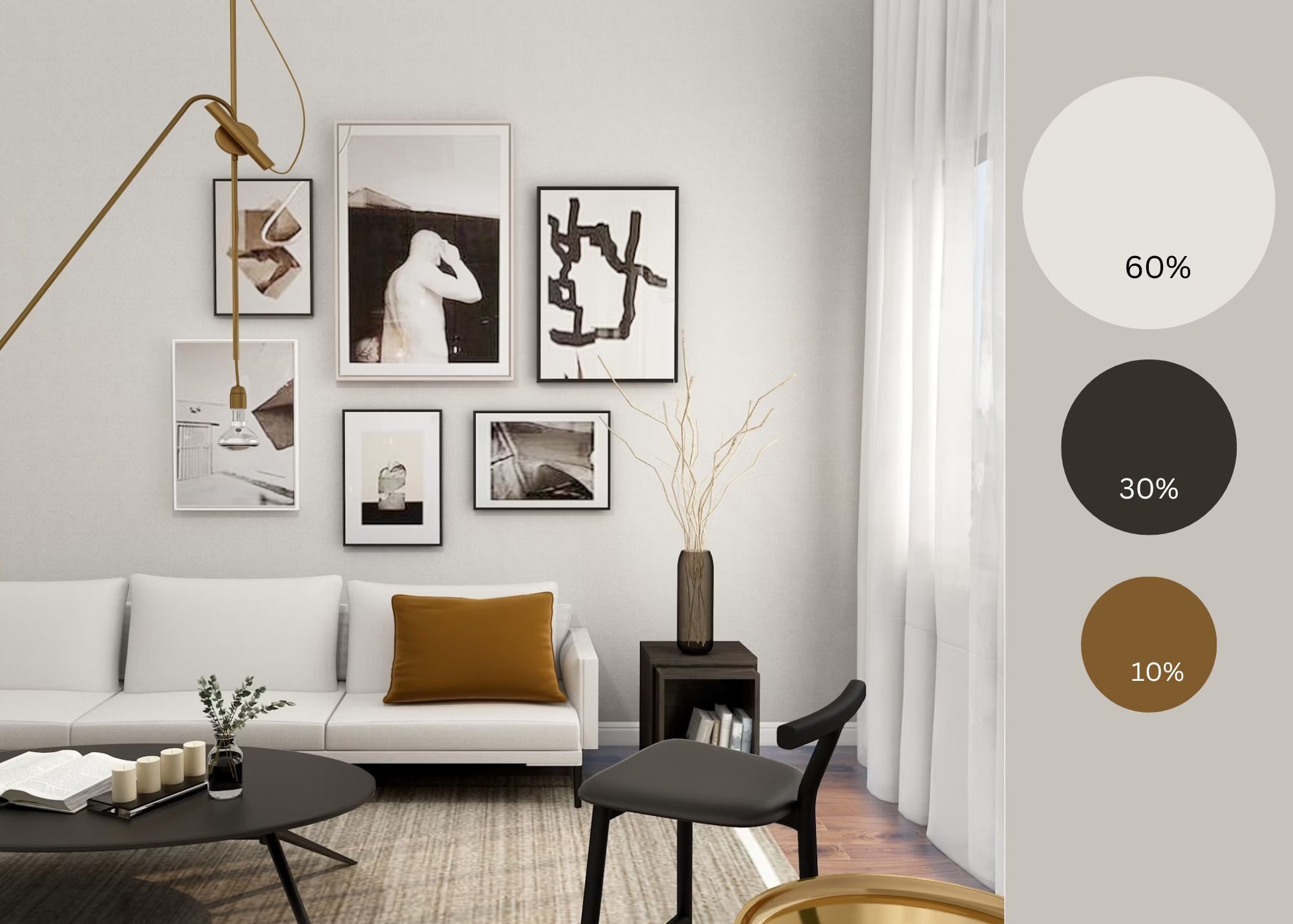
For example, you might have soft grey walls and a grey sofa (60%), navy curtains and a patterned rug incorporating navy (30%), and mustard yellow pillows with brass accents (10%). The proportions keep everything balanced while allowing personality to shine through.
Building Your Palette
Start with what you can’t change. Do you have wood floors? Their undertone (warm or cool) influences everything else. Keeping a favourite sofa? Its colour becomes part of your palette. Working around existing elements is part of learning how to decorate a living room step by step in real-world situations.
Consider these factors when selecting colours:
Natural Light: North-facing rooms get cool, indirect light that can make colours appear greyer. Warm these spaces with colours that have yellow or red undertones. South-facing rooms get warm, direct light and can handle cooler colours.
Room Size: Light colours reflect light and make spaces feel larger. Dark colours absorb light, creating intimacy but potentially making rooms feel smaller. That said, a small room painted in a rich, dark colour can feel incredibly sophisticated—it’s about intention.
Ceiling Height: Paint ceilings lighter than walls to add perceived height. In rooms with very high ceilings, a darker ceiling colour can make the space feel more intimate.
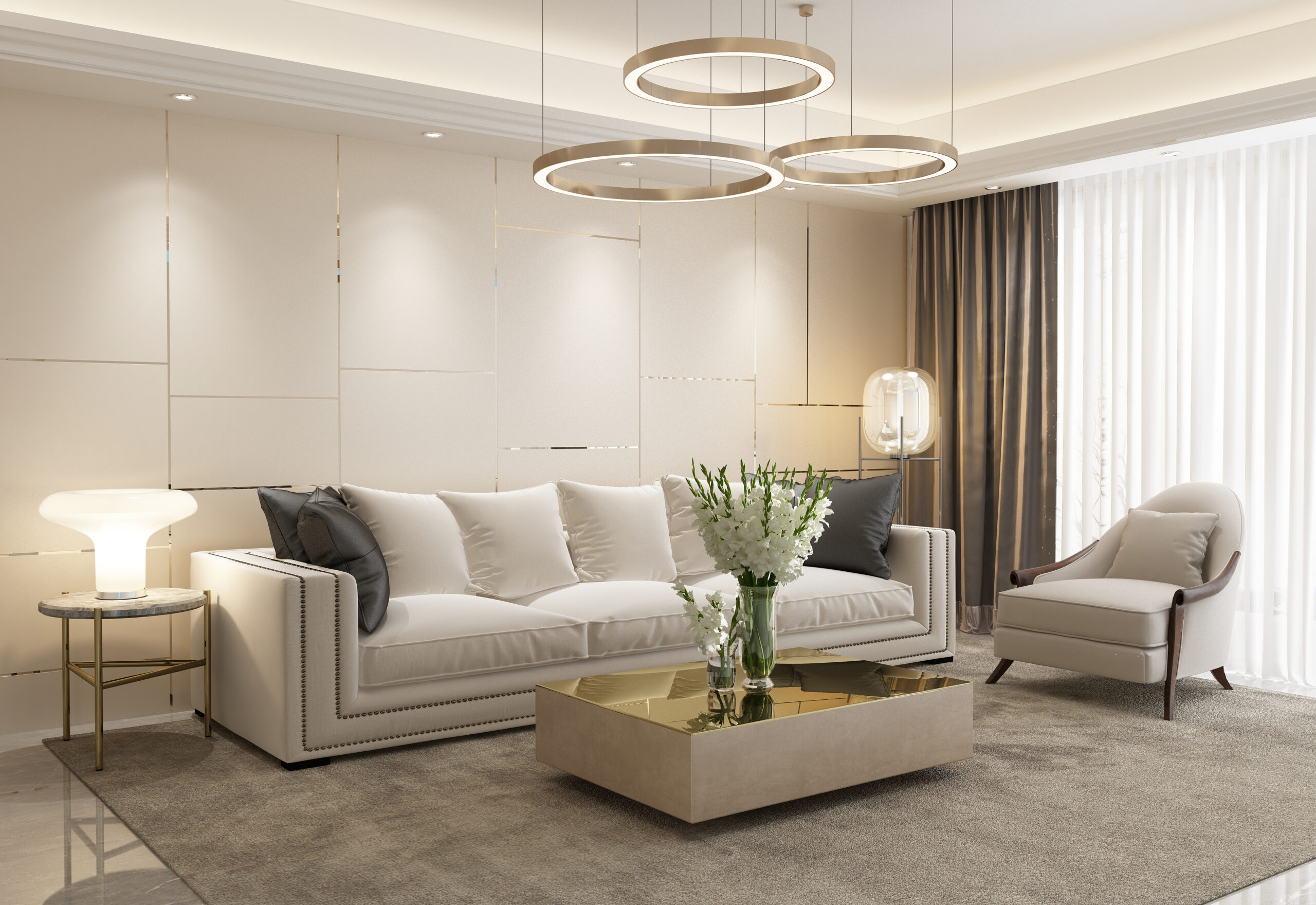
Testing Colours in Your Space
Never choose paint colours under store lighting. What looks perfect at the hardware store can be completely different in your living room. Here’s my tested process:
- Buy samples of your top 3-4 paint choices
- Paint large swatches (at least 2×2 feet) on different walls
- Observe them at different times of day
- Live with them for at least 48 hours
- Notice how they look with your lighting on
Pay attention to undertones—that “perfect grey” might look purple in your north-facing room or green next to your warm wood floors. This testing phase prevents expensive mistakes and disappointment.
Working with Neutrals
Neutrals get a bad reputation for being boring, but they’re actually complex and sophisticated. Today’s neutrals go far beyond beige:
- Warm Neutrals: Creams, taupes, warm greys, and greiges create cosy, inviting spaces
- Cool Neutrals: Pure whites, cool greys, and soft blacks offer a modern, crisp feel
- Natural Neutrals: Colours pulled from nature, like sage, clay, or sand, add subtle personality
The beauty of a neutral base? You can completely change your room’s personality by swapping accessories. That neutral sofa becomes bohemian with colourful pillows or sophisticated with monochromatic styling.
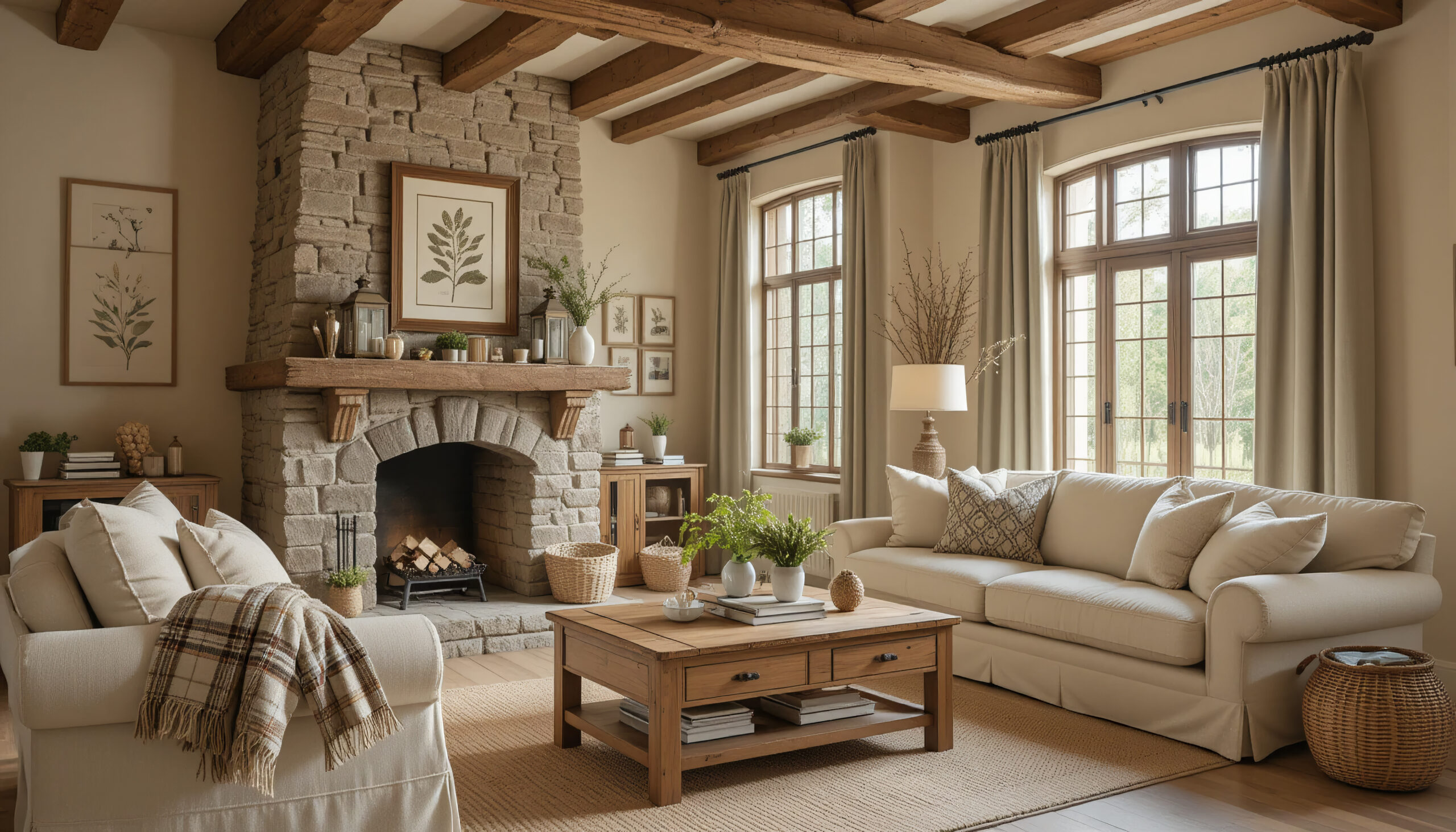
Adding Colour Strategically
If you love colour but feel nervous about commitment, start small. Ways to incorporate colour without it getting overwhelming:
- Accent Wall: One colourful wall creates impact without dominating
- Colourful Sofa: A statement piece that anchors the room
- Window Treatments: Curtains or Roman shades add softness and colour
- Area Rug: Brings multiple colours together at floor level
- Artwork: Large pieces or gallery walls introduce colour at eye level
Remember, colour doesn’t mean bright. Deep jewel tones, muted historical colours, or sophisticated earth tones all add richness without screaming for attention.
Creating Colour Flow
Your living room shouldn’t feel disconnected from the rest of your home. Create flow by:
- Repeating one colour from adjoining spaces
- Using varying intensities of the same colour family
- Carrying neutral base colours throughout
- Adding consistent accent colours in different rooms
This doesn’t mean every room matches—it means they have a conversation with each other.
The Psychology of Colour
Understanding how colours affect mood helps you create the right atmosphere:
Blues and Greens: Calming, peaceful, good for relaxation
Warm Neutrals: Comforting, versatile, broadly appealing
Rich Jewel Tones: Sophisticated, dramatic, creates intimacy
Bright Colours: Energising but potentially overwhelming in large doses
Monochromatic Schemes: Serene, sophisticated, easy to execute
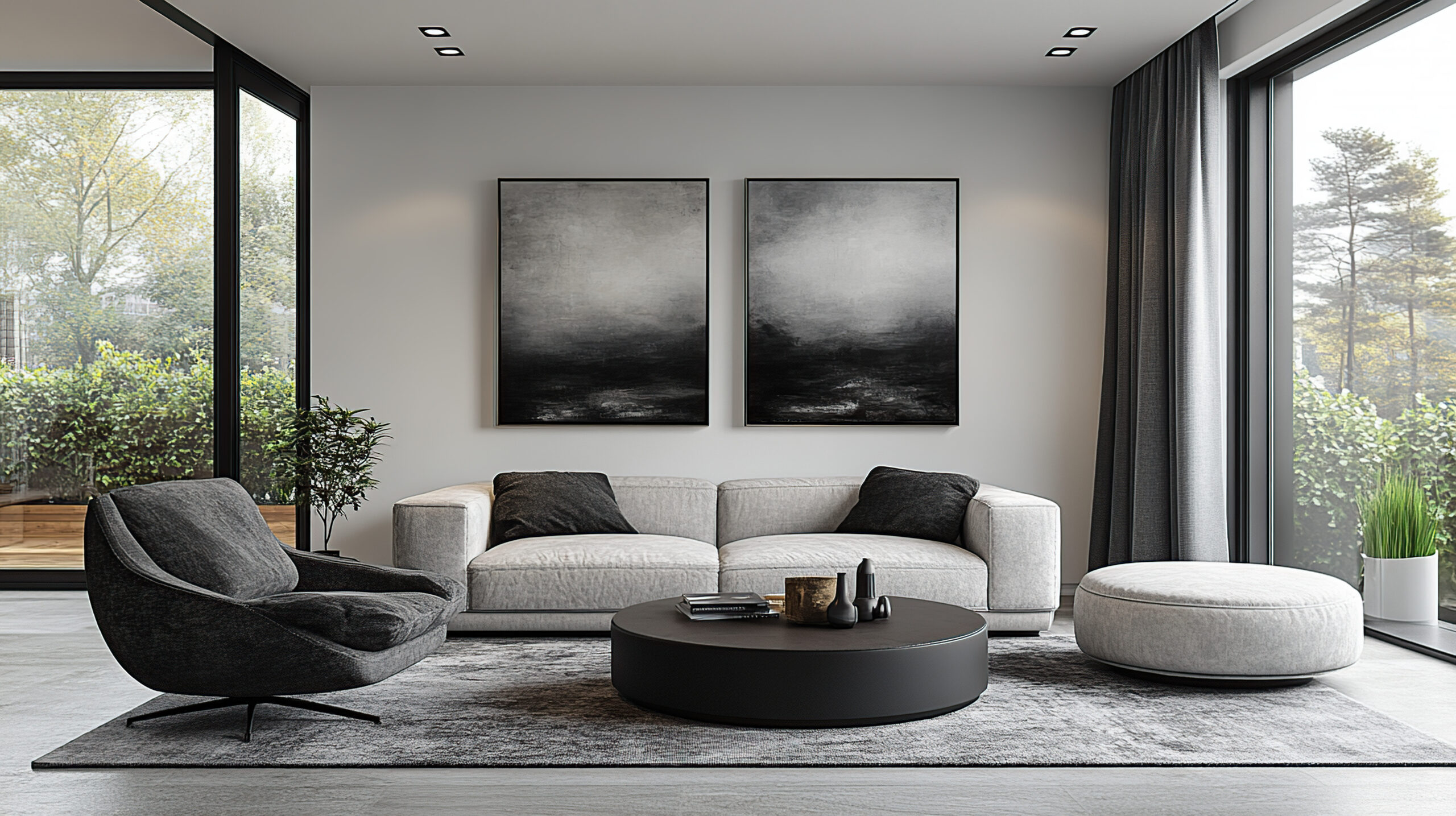
Common Colour Mistakes to Avoid
- Matching everything too perfectly (it looks flat)
- Ignoring undertones when mixing colours
- Choosing colours in isolation without considering the whole room
- Following trends that don’t suit your space or style
- Being too safe and ending up with a bland, personality-free room
Your colour palette is the thread that ties your entire living room together. With these colours established, you’re ready to select furniture that brings your vision to life while working within your carefully planned layout. The next step transforms your colour palette and floor plan into a fully furnished, functional space.
Step 5: Select and Purchase Furniture
This is where your planning pays off. With your layout mapped and colours chosen, furniture selection becomes strategic rather than overwhelming. The key to learning how to decorate a living room step by step is making each furniture decision build upon the last, creating a cohesive whole.
Starting with the Sofa
Your sofa is the living room’s anchor piece—get this right, and everything else falls into place. Consider these factors:
Size: Measure your doorways, hallways, and stairs before falling in love with anything. That perfect sectional won’t matter if it can’t make it into your room. For the room itself, your sofa should be proportional—not so large it dominates, not so small it looks lost.
Style: Your sofa should align with your chosen design direction but remain somewhat timeless. Trendy shapes date quickly, and sofas are expensive to replace. Classic silhouettes with updated fabric choices give you flexibility.
Comfort: Sit on it. Really sit on it—the way you actually lounge at home. Deep seats work for tall people, but can be uncomfortable for shorter folks. Firm cushions maintain their shape but might feel stiff to some. There’s no universal “comfortable” sofa.
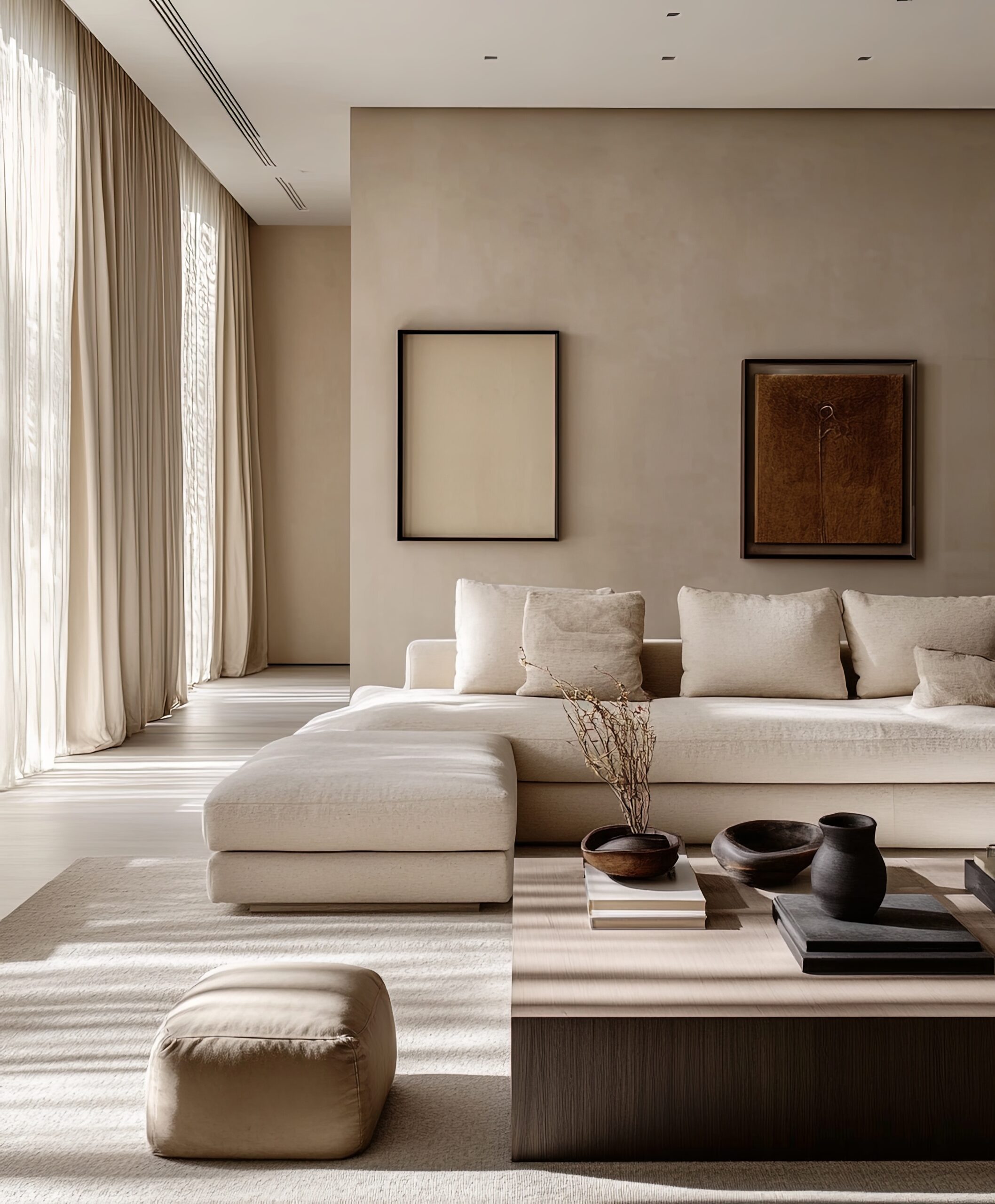
Fabric: Consider your real life. Performance fabrics have revolutionised upholstery—they look like linen or velvet but resist stains and wear. Leather develops character over time but requires specific care. Patterns hide wear but limit your accessory options.
Choosing Secondary Seating
Once your sofa is selected, add seating that complements without matching. Options include:
- Accent Chairs: Introduce pattern, colour, or texture. Swivel chairs add function.
- Ottoman: Provides extra seating, a footrest, or a coffee table alternative
- Bench: Great for narrow spaces or under windows
- Pouf: Lightweight, movable seating for flexible arrangements
Mix heights and shapes for visual interest. Two identical chairs flanking a fireplace create formal balance, while mismatched chairs feel more collected and casual.
Coffee Table Considerations
The coffee table often trips people up. Follow these guidelines:
Height: Should be within 2 inches of your sofa seat height (typically 16-18 inches)
Length: About 2/3 of your sofa’s length looks proportional
Distance: 14-18 inches from the sofa—close enough to reach, far enough to walk around
Shape: Round or oval tables improve flow in tight spaces. Rectangular works in most settings. Consider nesting tables for flexibility.
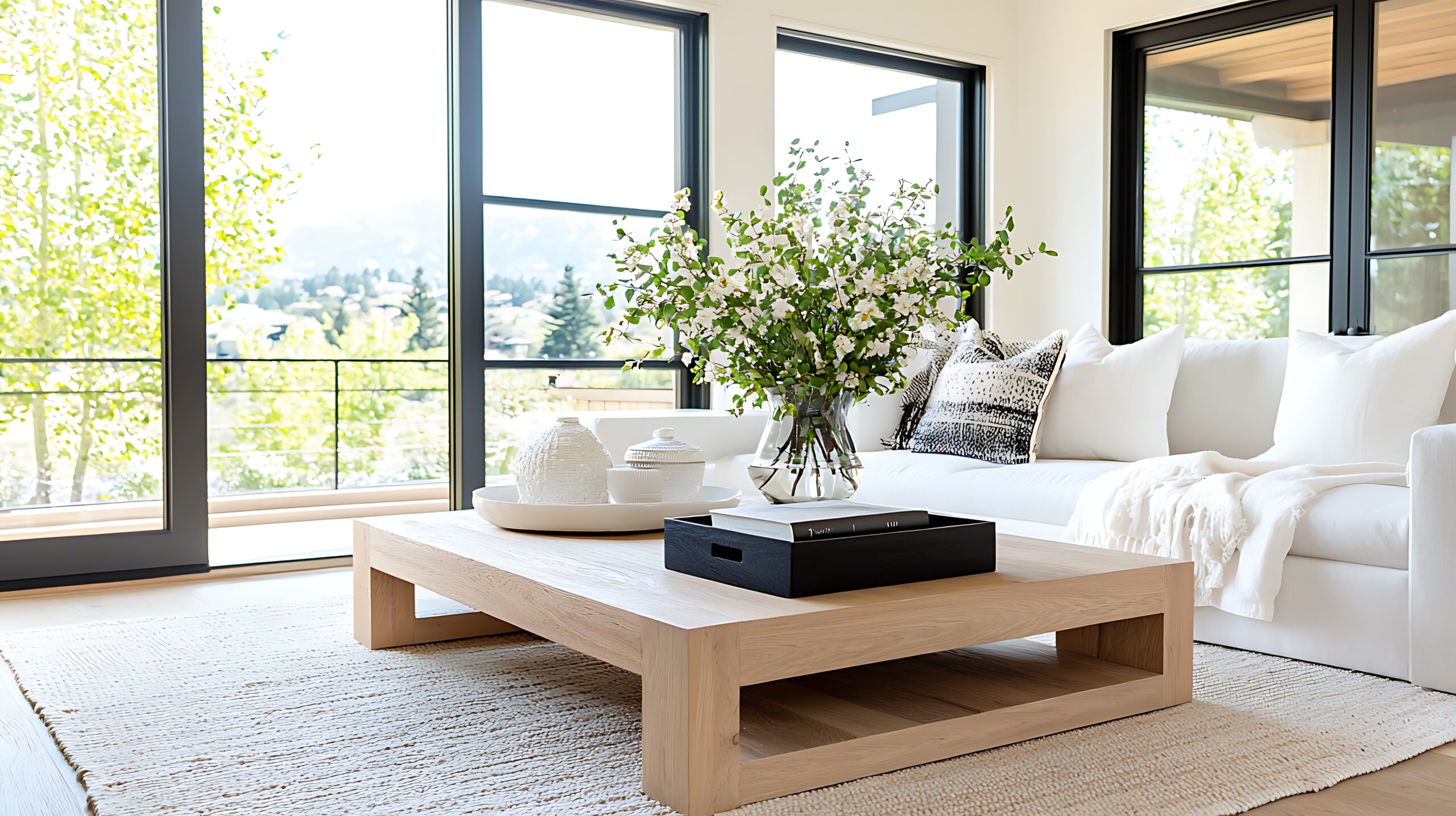
Material matters, too. Glass keeps sight lines open in small spaces. Wood adds warmth. Stone or metal brings sophisticated weight. Consider how the material relates to other elements in your room.
Storage Solutions
Living rooms need to be beautiful AND functional. Build in storage from the start:
Media Storage: Even in our streaming age, you need somewhere for remotes, game controllers, and that router you’re hiding. Media consoles with closed storage keep clutter invisible.
Display Storage: Open shelving, bookcases, or étagères showcase books and treasures while adding vertical interest. Mix displayed items with hidden storage boxes for practical balance.
Hidden Storage: Ottomans with lift tops, side tables with drawers, or console tables with baskets underneath. Every piece can work harder.
Quality Versus Budget
Here’s where I’ll be straight with you—furniture quality matters, but you need to be strategic about where to splurge. My priority list for how to decorate a living room step by step on any budget:
Splurge on:
- Sofa (you’ll use it daily for years)
- One quality accent chair (better than two cheap ones)
- Window treatments (custom often looks significantly better)
Save on:
- Accent tables (easily updated as styles change)
- Decorative accessories
- Throw pillows (buy covers, not whole pillows)
- Lamps (unless they’re statement pieces)
Consider vintage or secondhand for:
- Wood furniture (often better quality than new)
- Accent chairs (reupholstering costs less than buying quality new)
- Unique pieces that add character
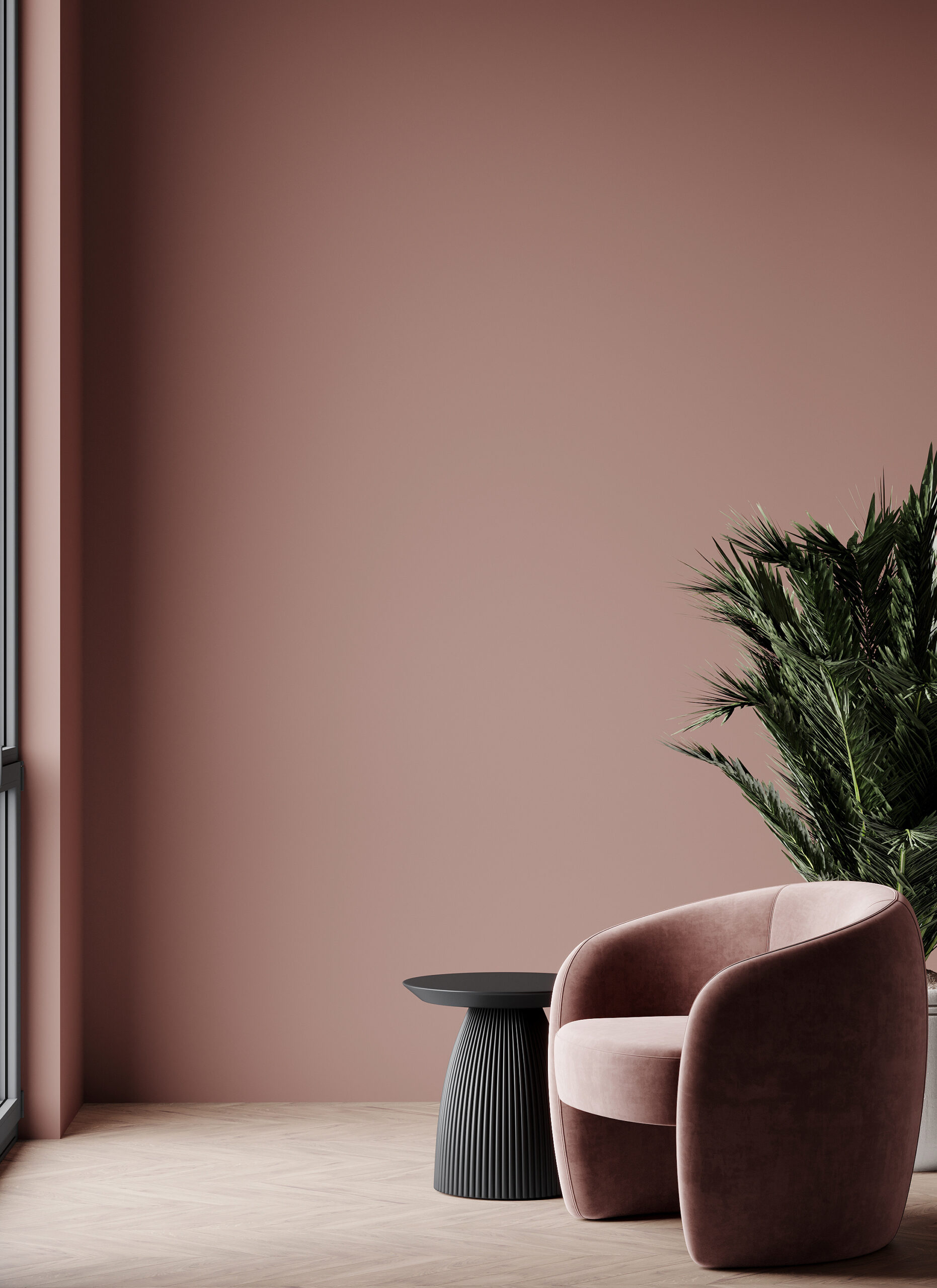
Online Versus In-Store Shopping
Both have advantages. Online offers endless options and often better prices, but you can’t assess comfort or true colour. In-store lets you experience pieces but limits selection. My approach:
- Visit stores to understand what styles and scales work for you
- Sit on sofas and chairs to know what feels comfortable
- Order fabric samples online before purchasing
- Read reviews focusing on comfort and durability
- Check return policies carefully
- Measure everything twice
Timing Your Purchases
Furniture shopping requires patience. Custom pieces take 8-16 weeks. Even in-stock items might need 2-4 weeks for delivery. Plan accordingly:
- Order your sofa first (longest lead time)
- Purchase a rug and window treatments
- Add tables and secondary seating
- Layer in lighting and accessories
This staged approach also helps your budget and lets you live in the space before making final decisions.
Making It All Work Together
As you select each piece, reference your vision board and colour palette. Every furniture item should feel like part of the same story. That doesn’t mean matching sets—it means intentional coordination. Mix wood tones but keep them in the same warmth family. Vary shapes but maintain similar visual weight. Combine different metals, but limit yourself to two finishes.
With your major furniture pieces selected and ordered, your room is taking shape. The bones are in place. Next, we’ll add the lighting layers that will truly bring your space to life, making it functional for every activity and beautiful at every time of day.
Step 6: Layer Your Lighting
Good lighting transforms a living room from flat and one-dimensional to warm and inviting. Yet it’s often treated as an afterthought. When learning how to decorate a living room step by step, lighting deserves as much attention as your sofa selection. Done right, it makes every other design choice look better.
Understanding the Three Layers
Professional designers think about lighting in layers, each serving a different purpose:
Ambient Lighting: This is your general illumination—the replacement for natural light when the sun goes down. Usually comes from overhead fixtures, recessed lights, or torcheres that bounce light off the ceiling. Without good ambient light, rooms feel cave-like.
Task Lighting: Focused light for specific activities. Reading lamps beside chairs, picture lights above artwork, or pendant lights over a console. Task lighting prevents eye strain and makes your room functional.
Accent Lighting: The jewellery of lighting—purely decorative elements that add sparkle and highlight special features. Think uplights behind plants, LED strips under floating shelves, or decorative sconces flanking artwork.
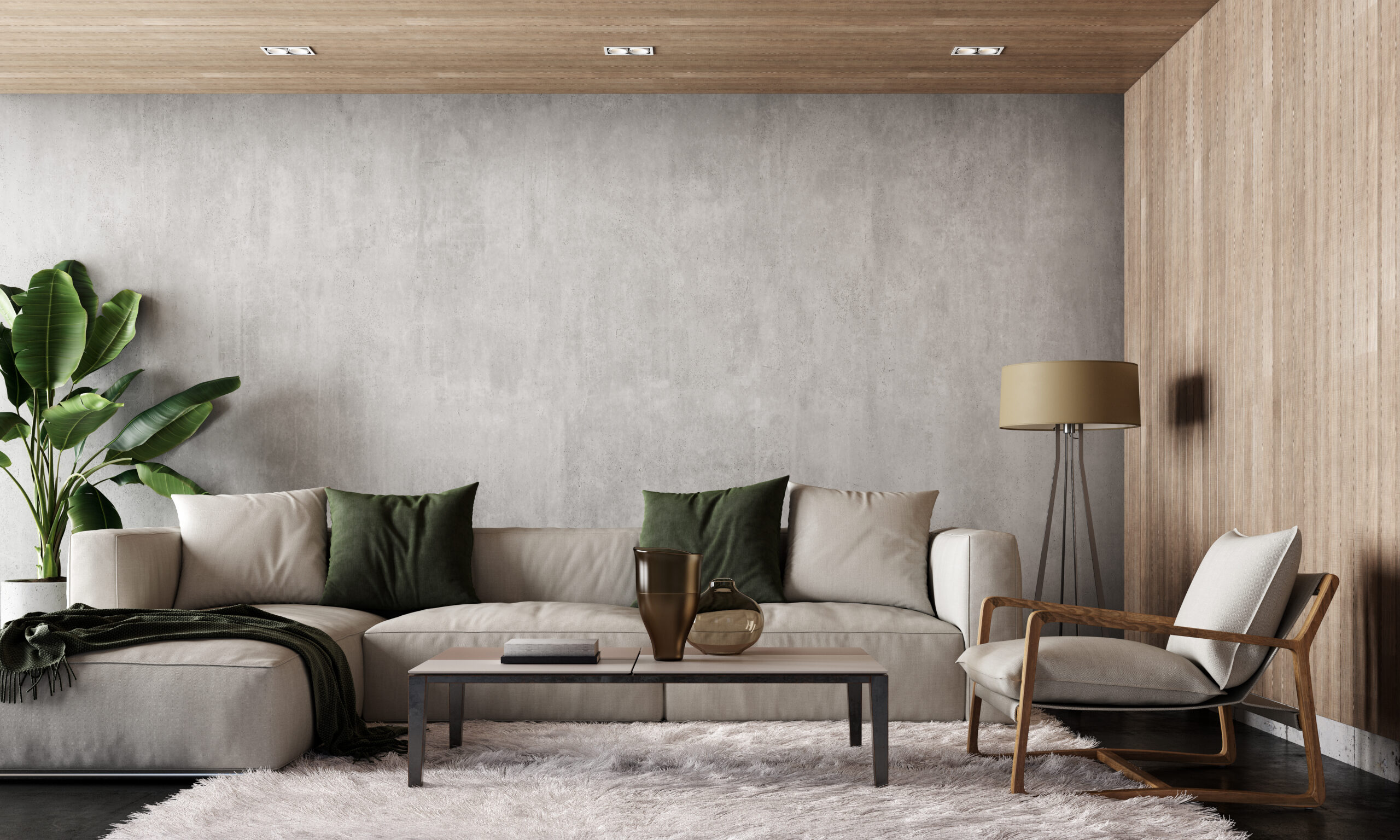
Planning Your Lighting Layout
Start by mapping activities in your room. Where will people read? Where do you need light for games or puzzles? Which architectural features deserve highlighting? This functional approach ensures beautiful lighting that actually works for daily life.
For most living rooms, aim for 5-7 light sources. That might sound excessive, but remember—you won’t use them all at once. Multiple sources give you the flexibility to create different moods. A typical layout might include:
- Overhead fixture or recessed lights (4-6 in larger rooms)
- Table lamps flanking the sofa
- Floor lamp by the reading chair
- Accent light for artwork or plants
- Console or buffet lamp for an ambient glow
Choosing the Right Fixtures
Overhead Lighting: If you’re stuck with a builder-grade ceiling fan or dated fixture, replacing it makes an immediate impact. Choose a size that relates to your room—too small looks skimpy, too large overwhelms. For 12-foot ceilings or higher, consider a fixture with adjustable height.
Table Lamps: Height matters more than style. When seated, the bottom of the shade should be at eye level. This prevents glare while providing good reading light. For sofa end tables, 26-30 inches tall usually works. Matching pairs create formal symmetry while coordinating but different lamps feel more collected.
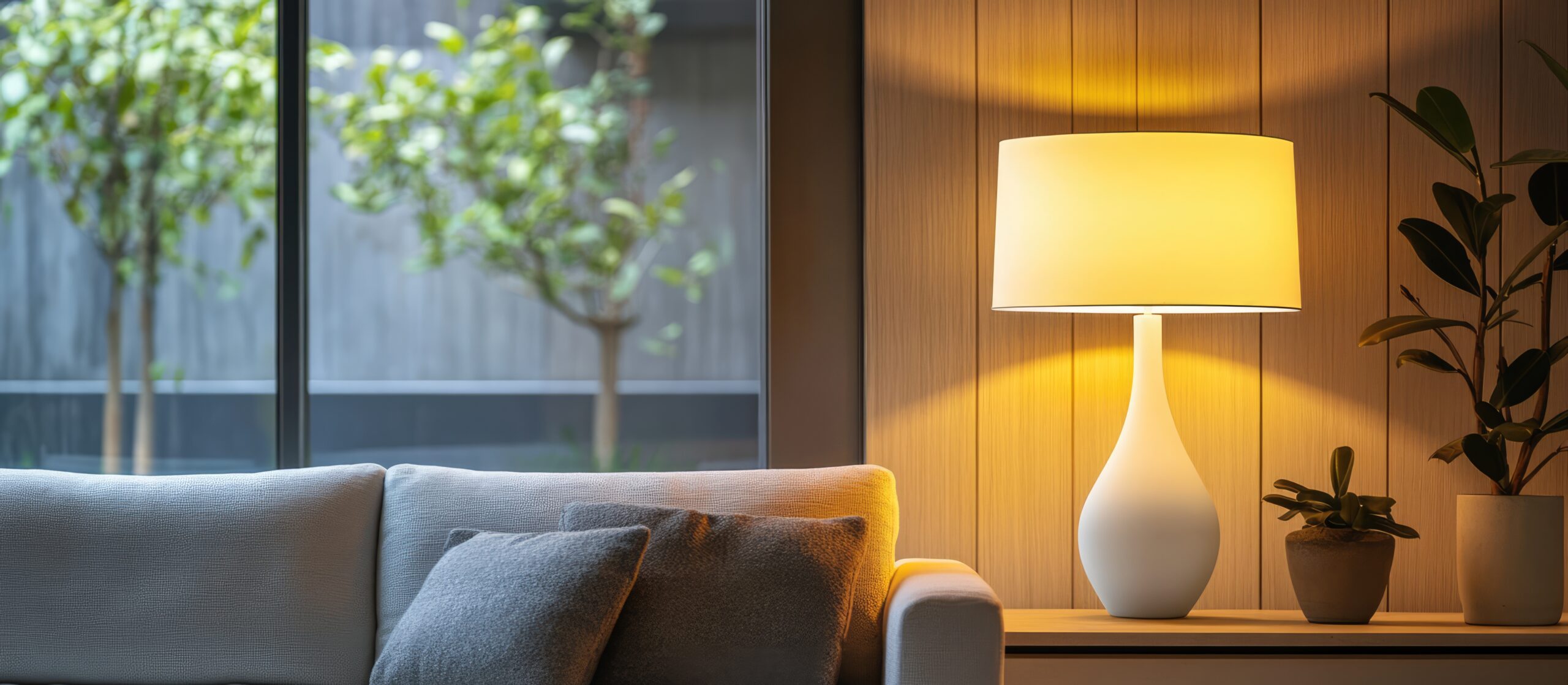
Floor Lamps: These add height and can illuminate dark corners. Arc floor lamps reach over seating without requiring a side table. Pharmacy-style lamps offer adjustable task lighting. Torcheres provide ambient light by washing walls and ceilings.
The Dimmer Difference
If you do one electrical upgrade, make it dimmers. They transform basic fixtures into mood lighting and extend bulb life. Every overhead light should be dimmable. For lamps, use three-way bulbs or smart bulbs you can control from your phone.
Speaking of smart bulbs—they’re game changers for renters or anyone who can’t rewire. Change the colour temperature from energizing daylight to cozy warm white. Set scenes for different activities. Some even sync with movies or music.
Getting Colour Temperature Right
Nothing ruins a carefully designed room faster than mismatched light colours. All bulbs in view together should be the same temperature:
- 2700 K- 3000 K (Warm White): Cozy, residential feel. Flatter’s warm colour palettes.
- 3500 K- 4000 K (Neutral White): Clean but not harsh. Works with any colour scheme.
- 5000K+ (Daylight): Energising but can feel commercial. Best for task lighting only.
Most living rooms look best in the 2700 K- 3000 K range, especially in the evening. If you need a brighter light for tasks, use adjustable fixtures rather than mixing temperatures.

Common Lighting Mistakes
Over-relying on overhead lights: One ceiling fixture creates harsh shadows and unflattering light. Layer multiple sources instead.
Ignoring scale: Tiny lamps on massive tables or huge fixtures in small rooms throw off proportions.
Placing lamps too low: Table lamps shorter than 24 inches rarely provide good light. Stack books underneath if needed.
Forgetting about outlets: Plan lamp placement around existing outlets or budget for adding more. Extension cords running everywhere ruin the look.
All matching fixtures: While coordinating finishes is good, identical fixtures everywhere feel like a hotel.
Natural Light Management
Don’t forget about controlling natural light. How to decorate a living room step by step includes managing daylight too:
- Sheer curtains filter harsh sun while maintaining brightness
- Blackout shades on windows that get direct sun to prevent glare and fading
- Mirrors positioned opposite windows amplify natural light
- Light-coloured walls and ceilings bounce daylight deeper into rooms
Creating Lighting Scenes
The magic happens when you combine different light sources for different moods:
Entertaining: All ambient lights at 75%, accent lights on, task lights off
Movie watching: All lights dimmed to 25% or off, bias lighting behind the TV
Reading: Task light on, ambient lights at 50%, others off
Everyday evening: Mix of ambient and task at comfortable levels
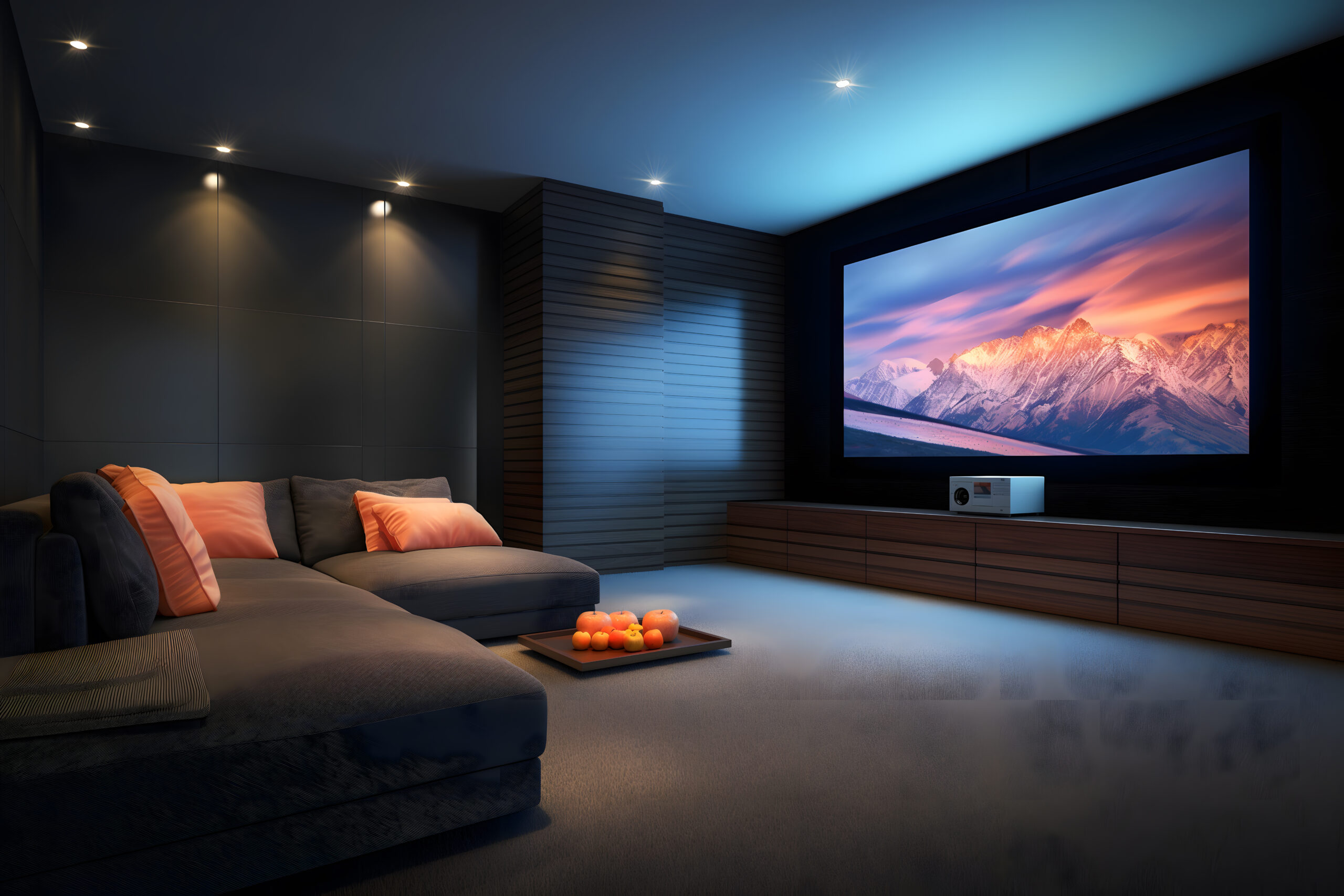
Budget-Friendly Lighting Updates
Great lighting doesn’t require rewiring or expensive fixtures:
- Replace lampshades for instant updates (white or cream lining reflects more light)
- Add battery-operated picture lights to highlight artwork
- Use plug-in pendant lights for rental-friendly ceiling fixtures
- Install dimmer switches (easier than you think)
- Add LED strips under shelves or behind furniture for an ambient glow
With your lighting plan in place, your room can transition from bright and energising during the day to warm and intimate at night. This flexibility is what makes a living room truly livable. Next, we’ll add the finishing touches that make your well-lit room feel complete and personally yours.
Step 7: Add Window Treatments
Window treatments do triple duty in your living room—they control light, provide privacy, and contribute significantly to your design aesthetic. Yet they’re often an afterthought, purchased in a rush when you realise neighbours can see straight in. When learning how to decorate a living room step by step, planning window treatments early ensures they enhance rather than detract from your overall design.
Function First
Before falling for beautiful fabrics, determine what you actually need from your window treatments:
Privacy Requirements: Street-level windows facing neighbours need different solutions than second-story windows overlooking trees. Consider when you need privacy—just at night, or during the day too?
Light Control: Do you get harsh afternoon sun that makes TV watching impossible? Morning light that wakes you too early if you’re near the living room? Or do you have precious little natural light you want to maximise?
Insulation: Windows are major sources of heat loss in winter and heat gain in summer. The right treatments can significantly impact your comfort and energy bills.
Sound Dampening: If you live on a busy street, heavy curtains can help muffle outside noise.
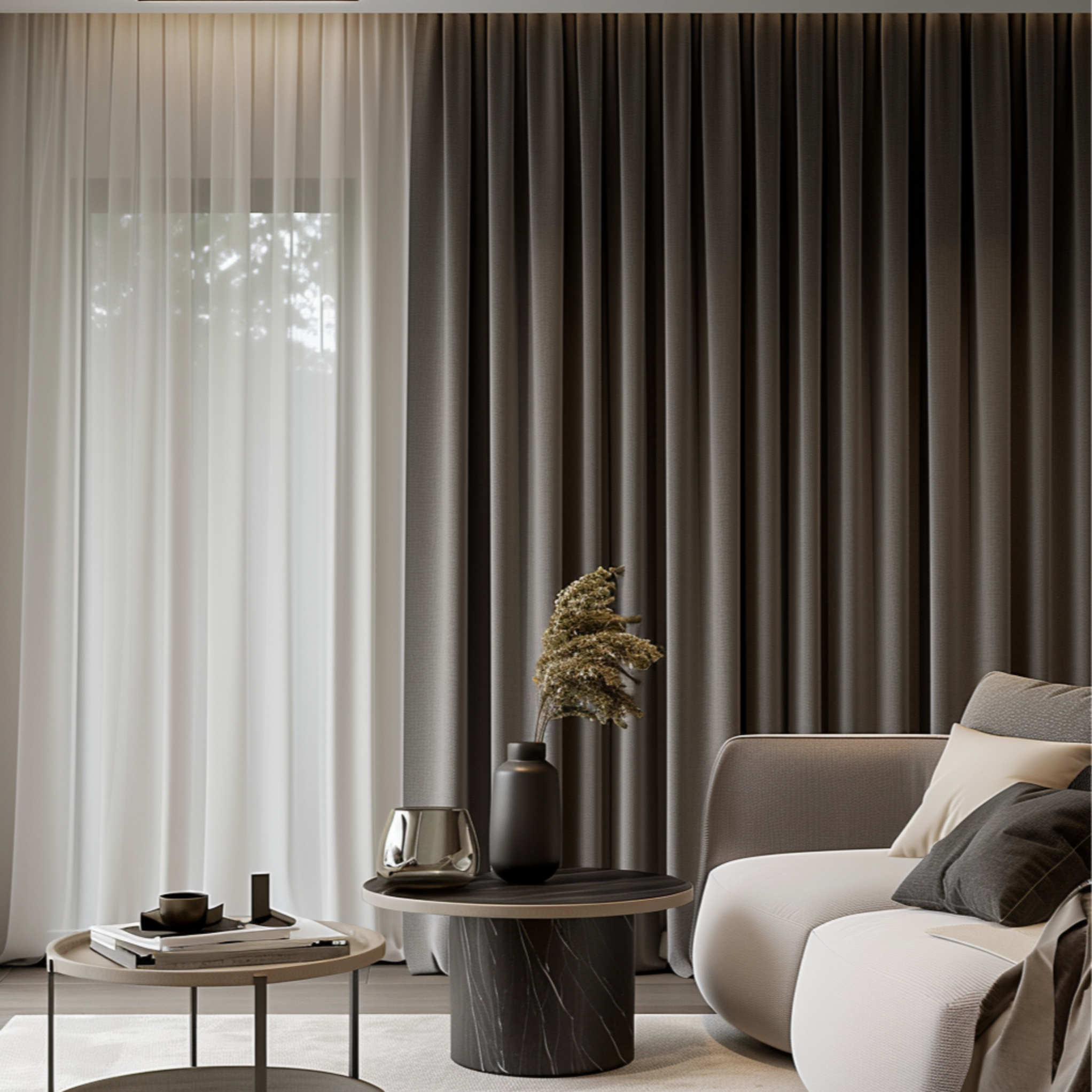
Choosing Your Style
Once you understand your functional needs, select treatments that align with your design aesthetic:
Curtains/Drapes: Soft and traditional, they add texture and can make windows appear larger when mounted high and wide. Full-length panels create elegance, while cafe curtains offer charm. Choose lined curtains for better light control and a more polished appearance from the outside.
Roman Shades: Tailored and classic, they provide a clean look when raised and good coverage when lowered. Available in countless fabrics to coordinate with any design style. Inside mount for a built-in look, outside mount to make windows appear larger.
Roller/Solar Shades: Modern and minimal, perfect for contemporary spaces. Solar shades filter light while maintaining views. Blackout options are available for media rooms. Motorised versions offer ultimate convenience.
Blinds: Wood blinds add warmth and work with many design styles. Faux wood offers durability and moisture resistance. Avoid aluminium mini-blinds—they rarely look high-end.
Layering: Combine treatments for maximum flexibility. Sheers for daytime privacy with curtains for nighttime. Blinds for light control with decorative panels for softness.
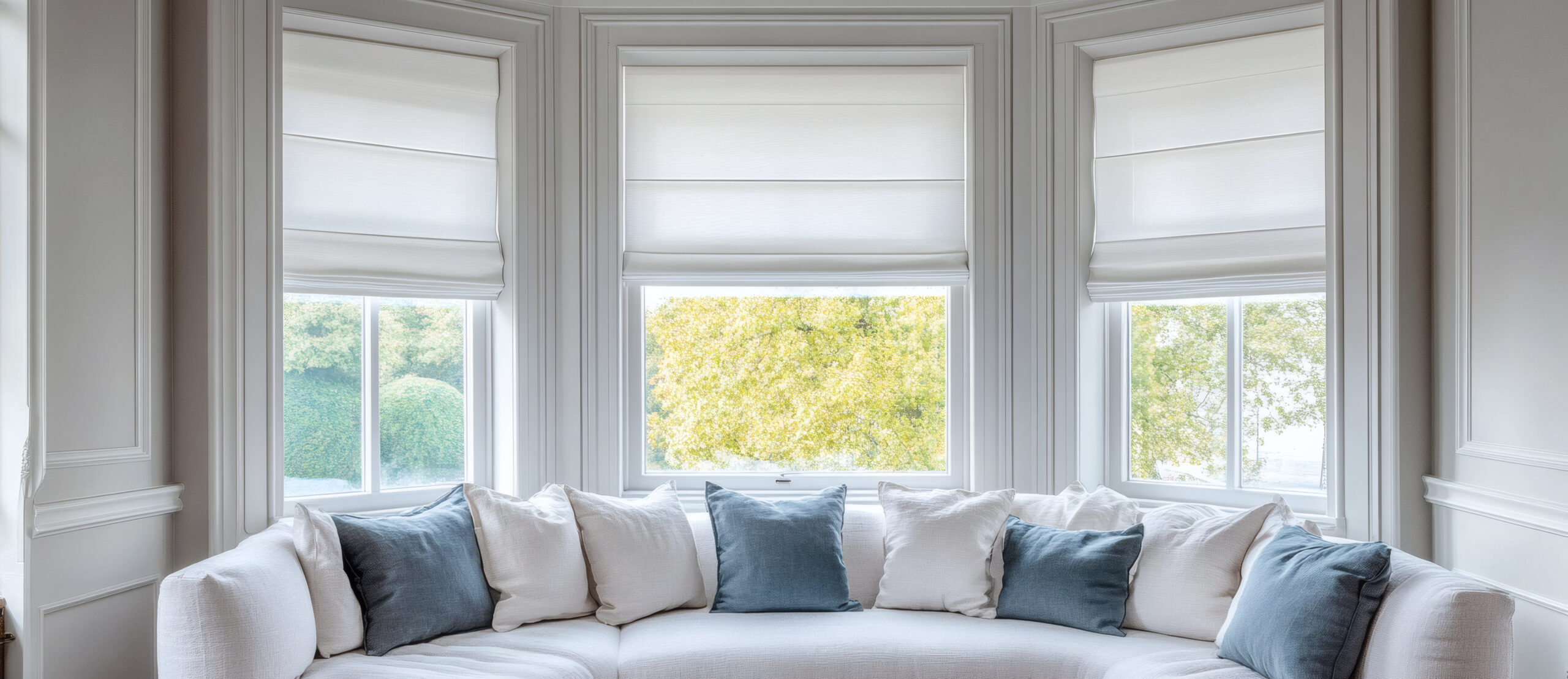
Getting Measurements Right
Incorrect measurements are the fastest way to make expensive window treatments look cheap. Here’s how to measure for professional results:
For Curtains:
- Mount brackets 4-6 inches above the window frame (or halfway between the window and the ceiling for drama)
- Extend the rod 8-12 inches beyond the frame on each side
- For length, choose kissing the floor (1/2 inch above), breaking slightly (1-2 inch puddle), or floating (ending at the sill or apron)
- Order panels that are 2- 2.5x your window width for proper fullness
For Shades and Blinds:
- Inside mount: Measure width at the top, middle, and bottom—use the narrowest measurement
- Outside mount: Add 2-3 inches on each side for light blockage
- Consider obstacles like window cranks or locks
Never assume windows are the same size—measure each one individually.
Material Considerations
Fabric choice impacts both function and appearance:
Linen: Casual elegance, filters light beautifully, wrinkles naturally
Cotton: Versatile, easy to clean, good for any style
Velvet: Luxurious, excellent insulation, blocks light well
Silk: Formal and elegant, but fades in direct sun (consider faux silk)
Polyester Blends: Durable, fade-resistant, often budget-friendly
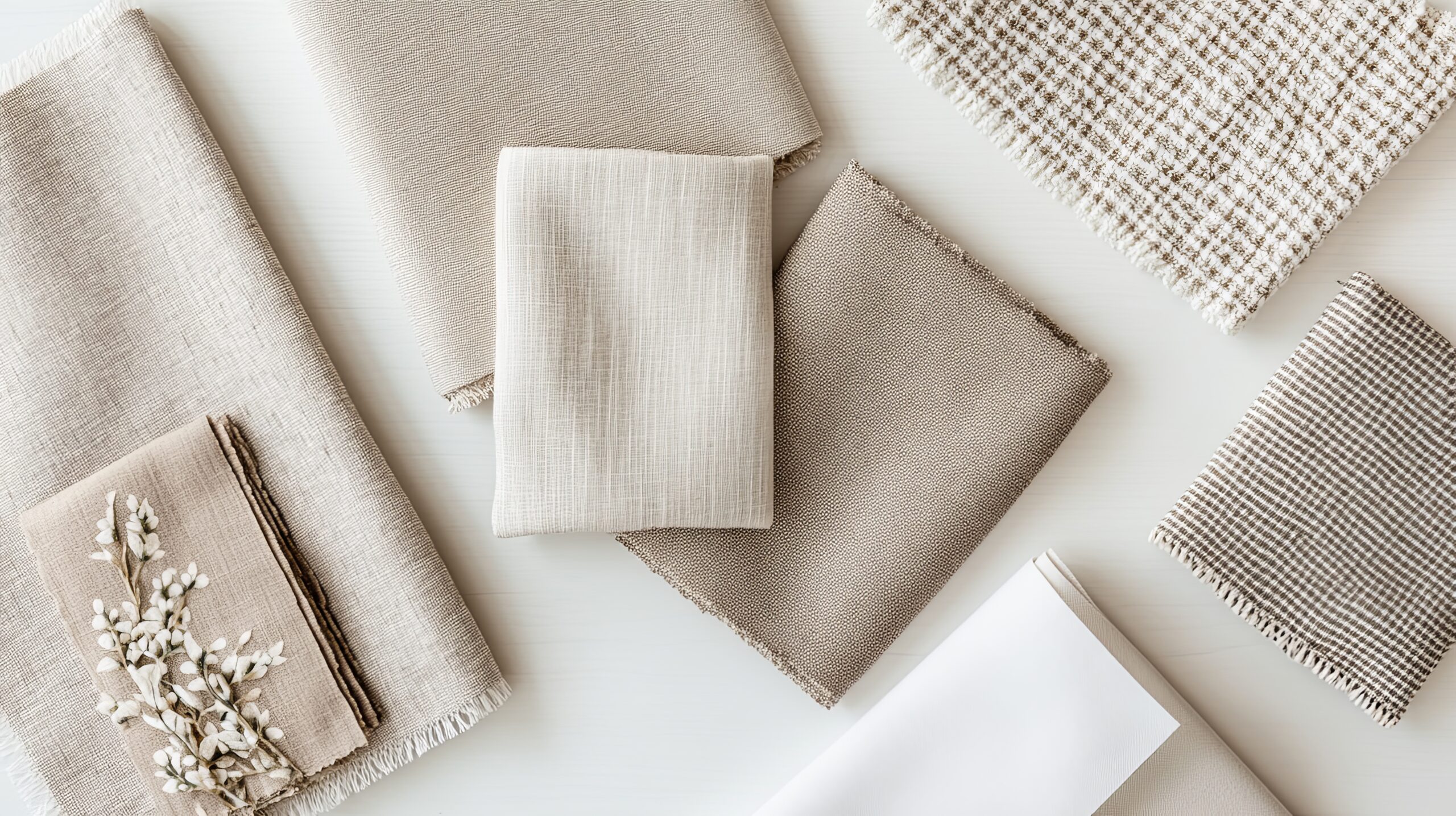
Colour and Pattern Strategy
Your window treatments should enhance your colour scheme, not fight with it:
- Matching walls: Makes windows recede and rooms feel larger
- Contrasting colour: Creates focal points and adds drama
- Patterns: Use solid treatments if you have patterned furniture, or vice versa
- Texture: Even solid colours can add interest through texture
Remember to order fabric samples and view them in your actual room light before committing to expensive treatments.
Professional Touches
Details separate custom-looking treatments from obviously store-bought:
Proper Hanging: Iron or steam before hanging. Curtains should hang straight, not bunch at the bottom.
Quality Hardware: Rods and brackets should complement your room’s metal finishes. The diameter should relate to fabric weight—heavier fabrics need substantial rods.
Finishing Details: Curtain rings make panels easy to open and close. Tiebacks or holdbacks keep panels neat when open. Valances can hide mechanics but are used sparingly—they can date a room.
Common Window Treatment Mistakes
Hanging too low: Mounting right at the window frame makes the ceiling feel lower
Skimpy panels: Narrow curtains that barely cover windows when closed look cheap
Wrong length: Too-short curtains are the equivalent of flood pants
Ignoring the view from outside: Mismatched treatments look chaotic from the street
Over-accessorising: Skip the swags, jabots, and excessive layers
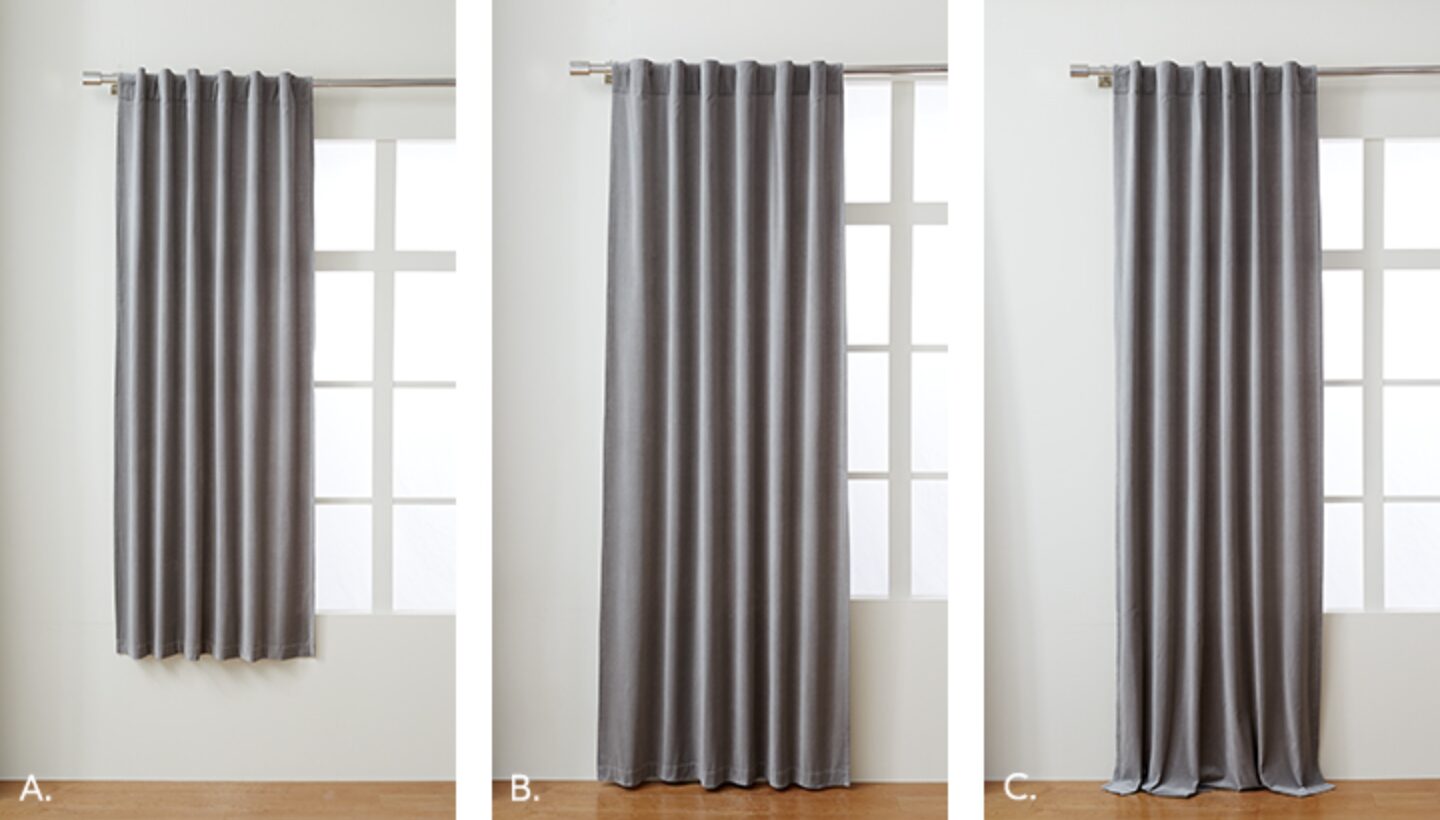
Budget-Friendly Options
Great window treatments don’t require custom pricing:
- Buy longer, inexpensive panels and hem them for the perfect length
- Use electrical conduit or plumbing pipes for industrial-style curtain rods
- Layer inexpensive sheers with ready-made panels for a custom look
- Paint or stain wooden blinds to coordinate with your colour scheme
- Buy basic roman shades and add trim for personality
Timing and Installation
Order window treatments early in your decorating process, custom options can take 6-8 weeks. Install them before arranging furniture to avoid disrupting your layout. If drilling into walls makes you nervous, many handypeople can install treatments quickly and ensure they’re level.
With window treatments in place, your room’s envelope is complete. Natural light is controlled, privacy is ensured, and your windows enhance rather than detract from your design. Now comes the fun part—adding the art, accessories, and personal touches that transform a well-designed room into your unique living space.
Step 8: Incorporate Art and Accessories
This is where your living room transforms from a furniture showroom into a home with personality. Accessories and art are what tell your story, but they’re also where many people freeze up or go overboard. The key to mastering how to decorate a living room step by step is approaching accessories with the same intentionality you brought to furniture selection.
Starting with Art
Art doesn’t have to mean expensive gallery pieces. What matters is choosing pieces that resonate with you and displaying them thoughtfully:
Scale Matters: The most common mistake is hanging art that’s too small. Above a sofa, artwork should be 2/3 to 3/4 of the sofa’s width. Over a console, leave 4-8 inches of space on each side. When in doubt, go larger or create a grouping.
Hanging Height: The centre of the artwork should hit at eye level—typically 57-60 inches from the floor. In living rooms where people are usually seated, you might hang slightly lower. Above furniture, leave 6-8 inches between the piece’s top and the art’s bottom.
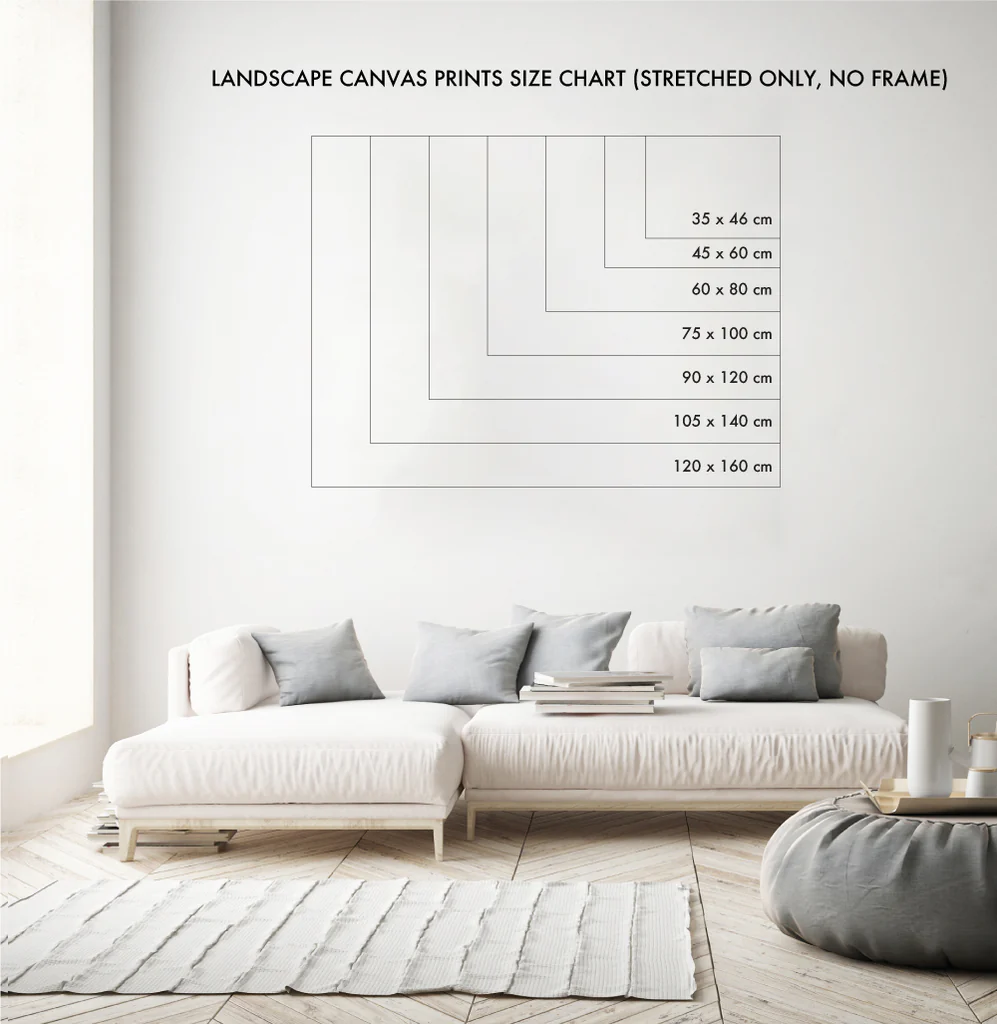
Creating Gallery Walls: These add major personality but require planning:
- Cut paper templates of your frames and tape them to the wall first
- Keep 2-3 inches between pieces for breathing room
- Mix sizes but maintain visual balance
- Include non-art elements like mirrors or dimensional objects
- Stick to a consistent frame colour or style for cohesion
Beyond Framed Art: Think creatively:
- Textile art or vintage rugs as wall hangings
- Floating shelves with rotating displays
- Large-scale photography or maps
- Sculptural pieces on pedestals
- Oversized mirrors that act as art
Styling Surfaces
Every flat surface in your living room is a styling opportunity, but restraint prevents clutter:
Coffee Table Styling:
- Start with a tray to corral smaller items
- Layer heights: books stacked horizontally, a small object on top, something tall like flowers
- Include something living (a plant or flowers)
- Leave 2/3 of the surface clear for function
- Mix materials: wood, metal, glass, ceramic
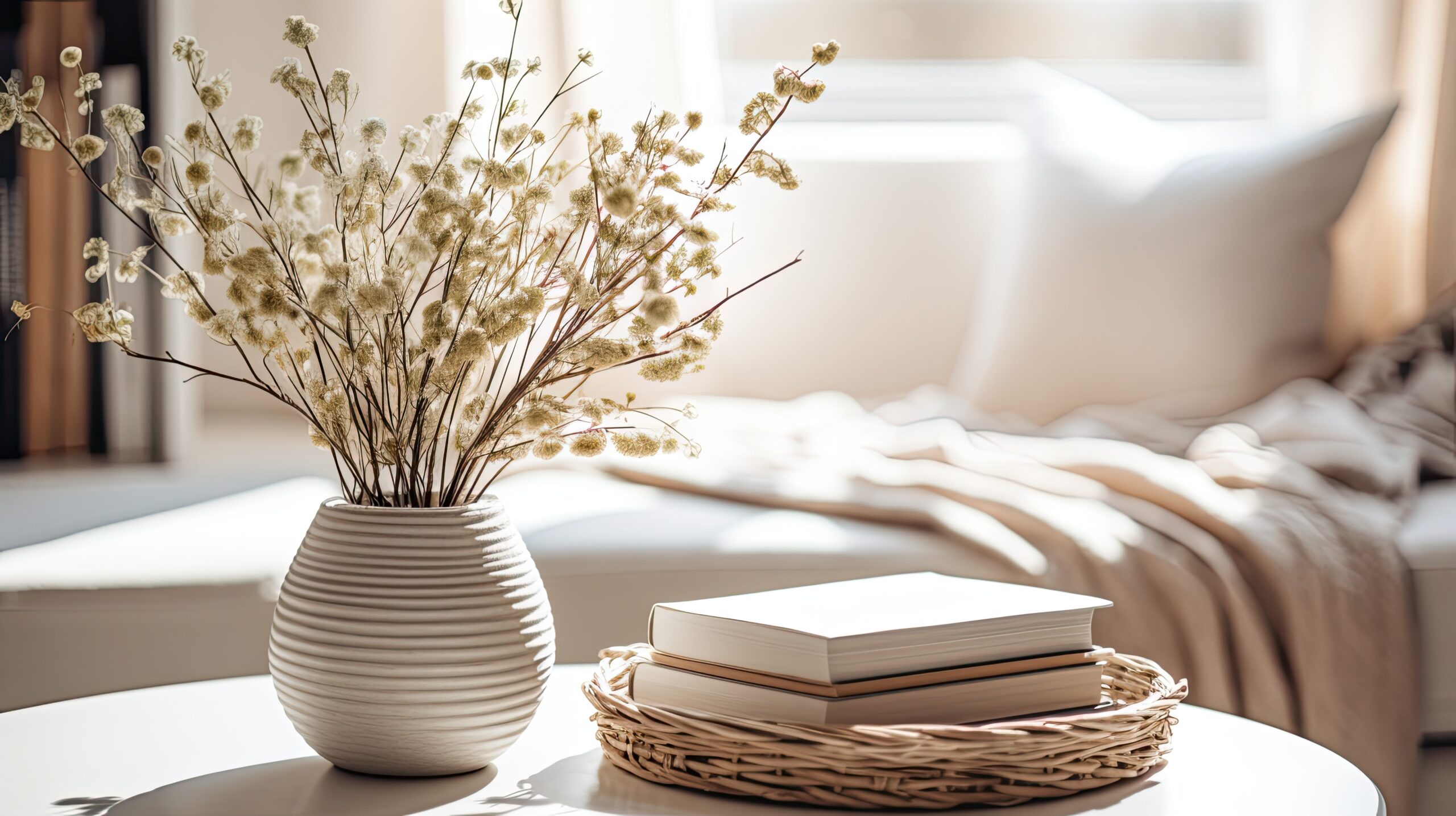
Console and Side Tables:
- Create triangular compositions with varying heights
- Anchor with a lamp or a tall object
- Add medium-height items like picture frames or small plants
- Include low elements like decorative boxes or stacked books
- Keep the scale proportional to the furniture
Bookshelf Styling:
- Mix vertical and horizontal book placement
- Break up books with decorative objects
- Leave some breathing room—don’t pack every inch
- Group books by colour for impact or mix for a casual feel
- Hide clutter in attractive boxes or baskets
The Power of Plants
Nothing brings life to a room quite like actual living things. Plants add colour, texture, and improve air quality:
Choosing the Right Plants:
- Consider light levels: snake plants and pothos tolerate low light, while fiddle leaf figs need bright conditions
- Match plant size to space: a single large floor plant makes more impact than scattered small ones
- Mix heights and leaf shapes for interest
- Use consistent planters that coordinate with your colour scheme
Placement Strategy:
- Fill empty corners with tall floor plants
- Add height to console displays with medium plants
- Cluster small plants on shelves or window sills
- Hang plants in corners to draw the eye up
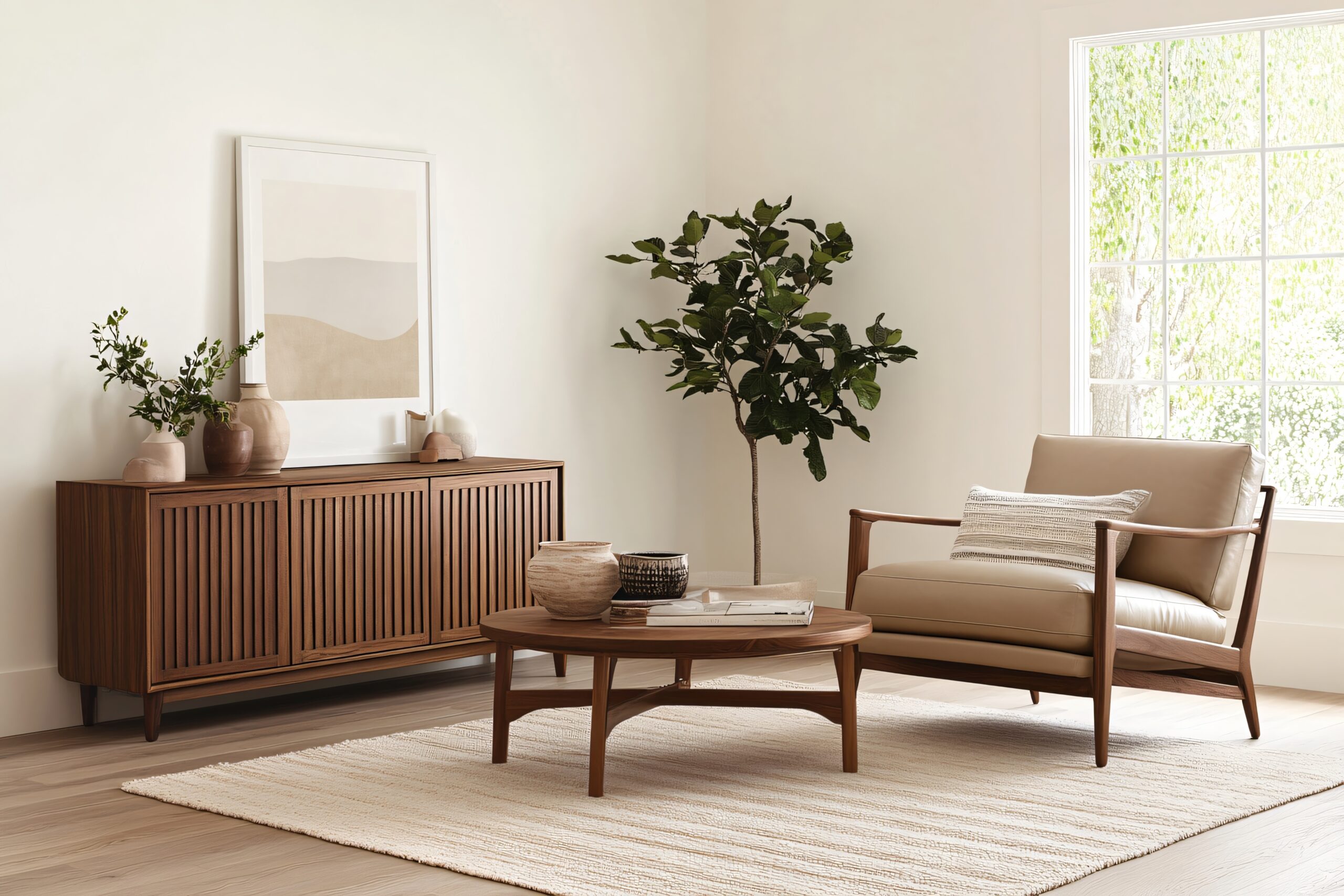
Incorporating Personal Items
The difference between a styled space and a home is personal meaning. Include items that tell your story:
Displaying Collections: Whether it’s pottery, vintage cameras, or seashells, group collections for impact rather than scattering them. Odd numbers feel more natural. Display on shelves, in shadow boxes, or on dedicated surfaces.
Family Photos: Mix frame styles within the same colour family. Create gallery walls mixing sizes, or display a collection on a console. Avoid cluttering every surface with photos—choose key locations for maximum impact.
Travel Souvenirs: Display thoughtfully rather than creating a cluttered “museum.” Group items by colour, material, or region. Rotate displays seasonally to enjoy everything without overwhelming the space.
Textile Layers
Soft accessories add comfort and tie colour schemes together:
Throw Pillows:
- Use odd numbers for casual appeal (3 or 5 per sofa)
- Mix patterns by varying scale: one large pattern, one medium, one small or solid
- Include different textures: smooth cotton, nubby linen, plush velvet
- Don’t match your sofa exactly—coordinate instead
- Invest in quality inserts, change covers seasonally
Throws:
- Drape casually over sofa backs or arms
- Fold neatly and place over the ottoman corners
- Choose materials that invite touching
- Keep one easily accessible for actual use
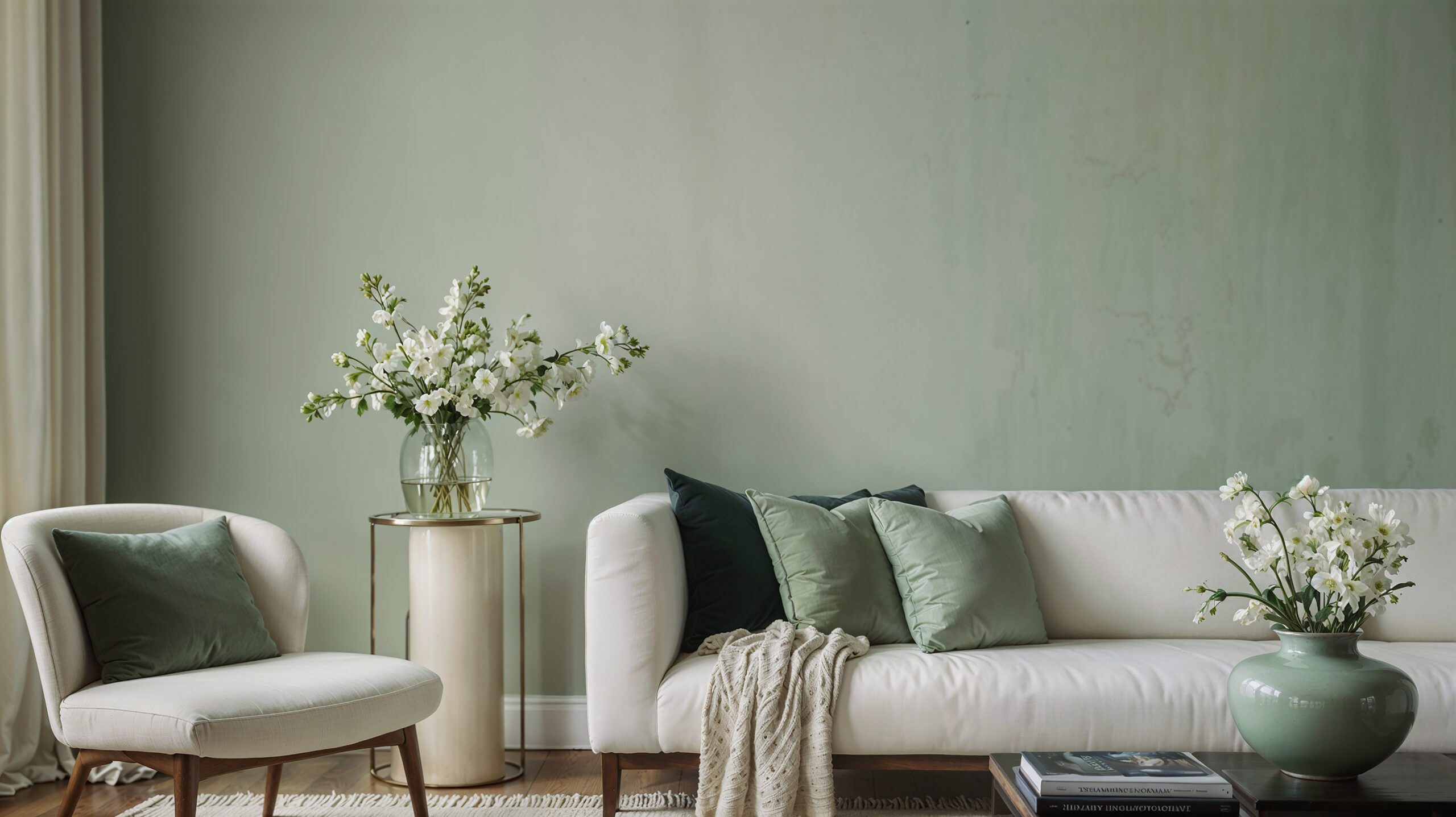
Editing and Restraint
The secret to professional-looking accessorising? Knowing when to stop:
The Rule of Three: Group accessories in odd numbers, typically three. Three different heights, three complementary colours, and three varying textures.
Negative Space: What you don’t fill is as important as what you do. Every surface doesn’t need styling. Not every wall doesn’t needs art. Let your room breathe.
Rotation Strategy: Own more accessories than you display. Rotate seasonally or when you need a refresh. This prevents accumulation and keeps your room feeling fresh.
Common Accessory Mistakes
- Pushing everything against the walls instead of layering depths
- Hanging art too high (remember, eye level!)
- Using accessories that are too small for the space
- Matching everything too perfectly (looks catalogue-stiff)
- Ignoring the view from your room’s entrance
Pulling It All Together
Step back and evaluate your accessorised room:
- Does it feel balanced from different viewpoints?
- Are your colours distributed throughout, not clustered in one area?
- Is there a mix of heights, textures, and materials?
- Can you still use the surfaces functionally?
- Does it feel like you, not a showroom?
With art and accessories in place, your living room should feel complete but not cluttered, styled but still functional. The final steps will ensure your beautifully designed room stays that way while serving your daily life.
Step 9: Final Styling and Bringing It All Together
You’ve selected furniture, layered lighting, hung window treatments, and added art. Now comes the crucial final phase—the styling details that elevate your living room from “nicely decorated” to magazine-worthy. This is where learning how to decorate a living room step by step really pays off, as you fine-tune each element to work in harmony.
The Final Layer: Sensory Details
Great rooms engage all the senses, not just sight. These finishing touches make spaces feel truly lived-in:
Scent: A subtle room fragrance creates an immediate impression. Skip overwhelming air fresheners for:
- Quality candles in complementary vessels
- Fresh flowers or eucalyptus stems
- Reed diffusers tucked discreetly on shelves
- Cedar blocks in baskets for natural freshness
Sound: Consider your room’s acoustics. Hard surfaces echo; soft furnishings absorb sound. If your room feels echo-y, add:
- Thick curtains
- Upholstered furniture
- Area rugs
- Wall tapestries or fabric art
Touch: Vary textures throughout the room to create interest and comfort:
- Smooth leather next to nubby linen
- Soft velvet against rough jute
- Cool metal with warm wood
- Plush areas balanced with sleek surfaces
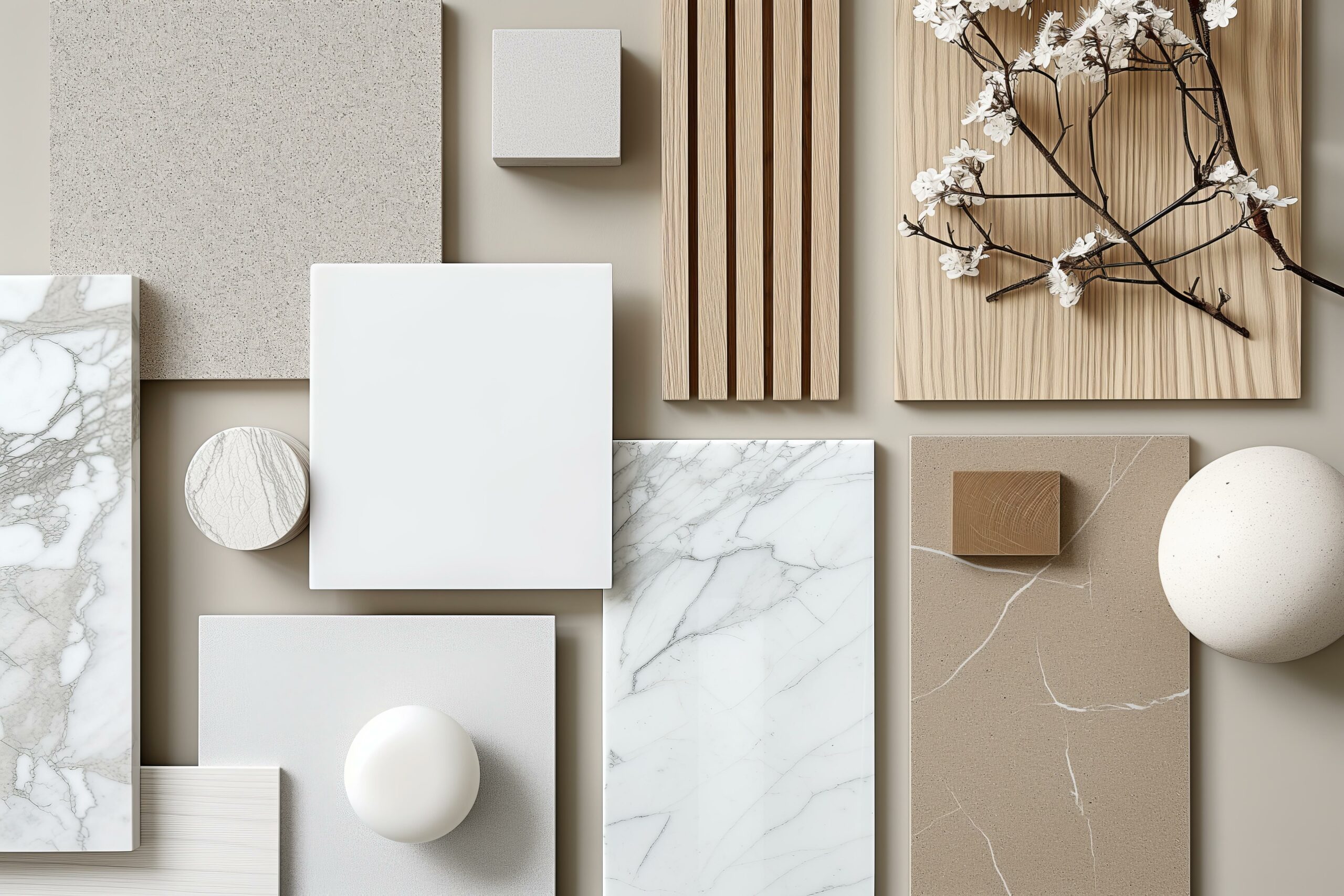
Creating Cohesion
With all elements in place, ensure everything feels intentional and connected:
Colour Threading: Your accent colour should appear at least three times around the room at different heights. If you have navy pillows, perhaps add a navy lampshade and navy binding on your curtains. This creates visual flow.
Metal Consistency: Limit yourself to two metal finishes maximum. If your lighting is brass and chrome, ensure all visible metals fall into these categories. Mixed metals work when intentional, and look sloppy when random.
Style Consistency: Every piece doesn’t need to match your dominant style perfectly, but outliers should feel intentional. That antique chest works in your modern room if other elements bridge the gap, perhaps through colour or material.
Styling for Real Life
The best-designed living rooms work for everyday life, not just photo shoots:
Functional Beauty:
- Keep attractive baskets near seating for quick toy cleanup
- Use beautiful boxes on consoles to hide remotes
- Choose coffee table books you actually want to read
- Place coasters within reach of every seat
Easy Maintenance:
- Washable pillow covers for easy refreshing
- Scotch-guard treatment on susceptible fabrics
- Furniture pads under all legs to protect the floors
- Storage solutions that make tidying natural
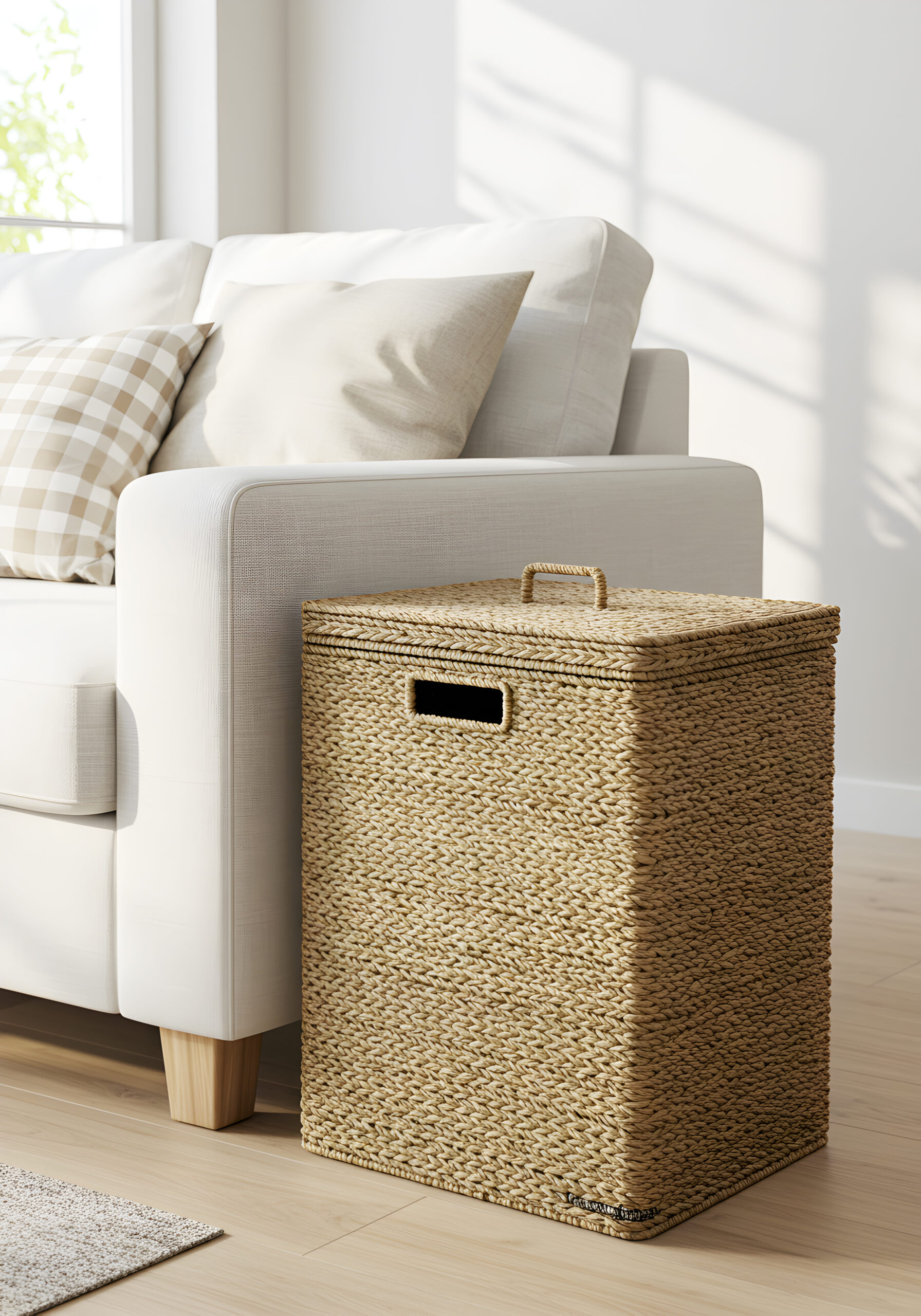
The Photography Test
Step outside and re-enter your room with fresh eyes. Then take photos from multiple angles—cameras reveal what our eyes overlook:
- Is there visual balance from the entrance?
- Do sight lines feel clear or cluttered?
- Are there any “dead zones” that need attention?
- Does the lighting photograph well?
Photos also help you remember what works when you need to reassemble after cleaning or rearranging.
Seasonal Adjustments
A well-designed room can transition through seasons with minimal changes:
Summer: Lighten throw pillows, swap heavy throws for linen, add fresh flowers, maximise natural light
Fall: Introduce warmer textures, layer cosy throws, add amber lighting, and display seasonal branches
Winter: Maximum cosiness with faux fur, rich textures, candlelight, darker accent colours
Spring: Fresh colours in accessories, lighter curtains if layered, bright flowers, simplified surfaces
These changes keep your room feeling fresh without major overhauls or expenses.
Living In Your Design
The first few weeks in your newly decorated room are crucial. Pay attention to:
What’s Working:
- Which seats get used the most?
- Is task lighting adequate?
- Can you reach surfaces easily?
- Does traffic flow feel natural?
What Needs Adjusting:
- Lamps that need relocating for better function
- Art that needs raising or lowering
- Furniture that blocks pathways
- Accessories that create clutter
Don’t be afraid to make adjustments. How to decorate a living room step by step includes refining based on real use.
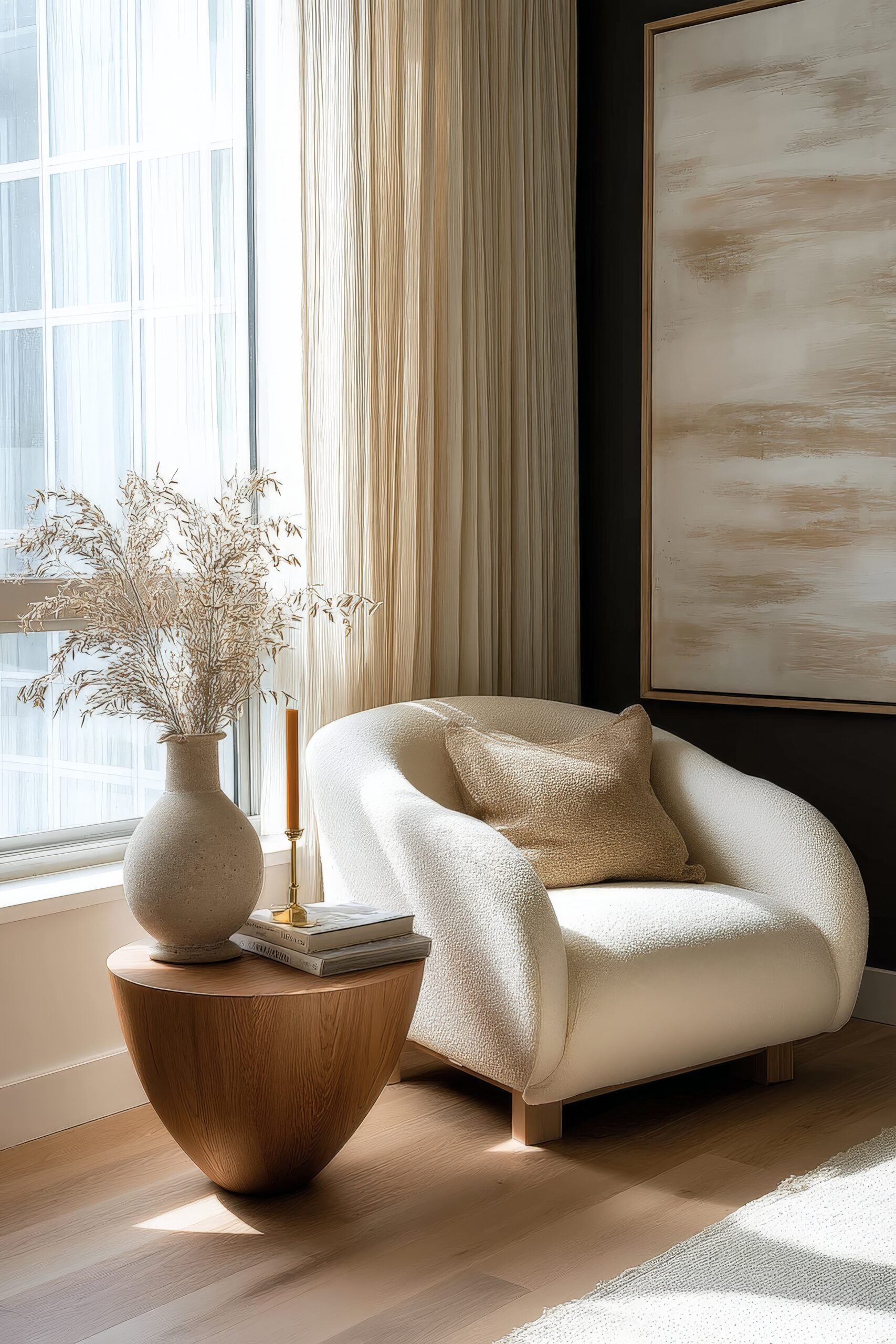
Maintaining Your Design
A beautiful room stays that way with simple routines:
Daily (5 minutes):
- Fluff and arrange pillows
- Fold and place the throws
- Clear surfaces of daily clutter
- Quick straightening of accessories
Weekly (20 minutes):
- Dust surfaces and vacuum
- Water plants
- Refresh flowers if needed
- Wipe down the coffee table and side tables
Monthly:
- Vacuum under furniture
- Clean lampshades
- Dust art and high shelves
- Rearrange accessories slightly for freshness
Seasonally:
- Deep clean upholstery
- Wash pillow covers and throws
- Edit accessories
- Update seasonal elements
When to Call in Help
Sometimes professional help makes sense:
- Mounting heavy art or mirrors safely
- Custom window treatment installation
- Electrical work for new outlets or fixtures
- Upholstery cleaning for investment pieces
The cost often prevents bigger mistakes or damage.
Embracing Evolution
Your living room should grow with you. The beauty of following a thoughtful process is that you can:
- Swap accessories as your taste evolves
- Update paint colours without starting over
- Change one major piece while maintaining cohesion
- Add new finds that complement your foundation
Your Living Room Transformation
Congratulations—you’ve learned how to decorate a living room step by step and created a space that’s both beautiful and functional. From that initial assessment through final styling, each phase is built upon the last to create a cohesive, personal space.
Remember:
- Good design takes time—don’t rush the process
- Function always trumps form—beauty that doesn’t work isn’t beautiful
- Your room should reflect your life, not magazine perfection
- Small adjustments can make big differences
- Living rooms are for living—enjoy yours!
The best part? You now have the knowledge and confidence to tackle any room in your home. The principles you’ve learned—assessing needs, defining style, planning layouts, layering elements, and styling with purpose—apply everywhere. Your living room was just the beginning.
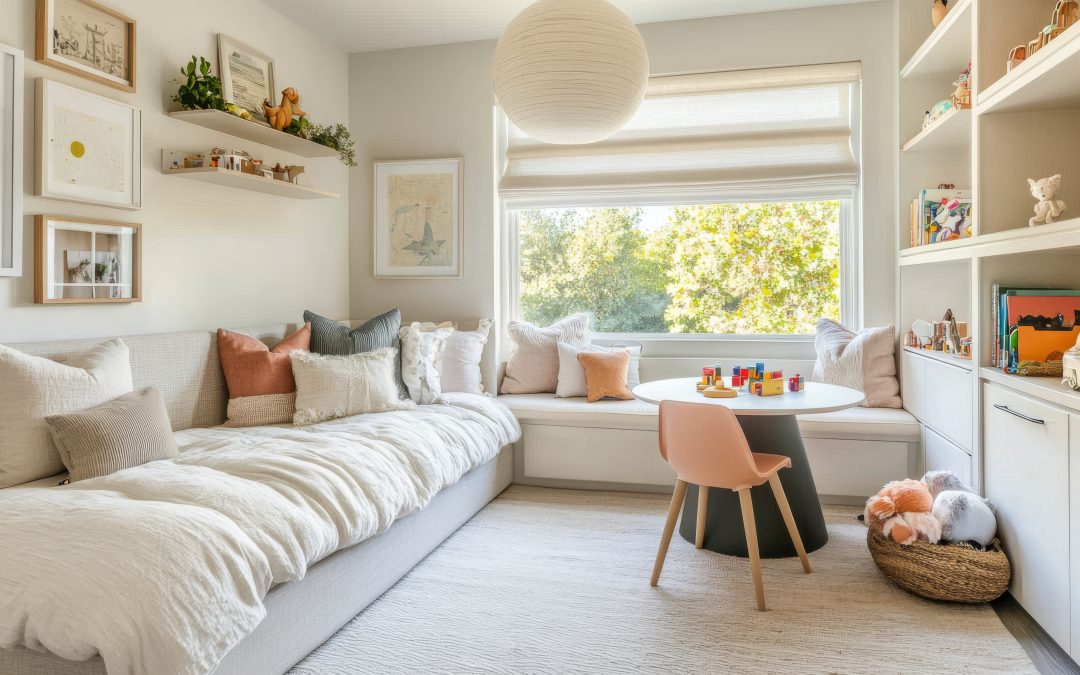
by Kesaa Interiors | DECOR & DIY, Furniture & Layout Guides, Lighting & Accessories, ROOMS, Small Space Hacks
Looking for the best tips and tricks to decorate a small bedroom for a girl? You are in the right place!
There’s something uniquely satisfying about transforming a small bedroom into a space that feels both functional and magical. When figuring out how to decorate a small bedroom for a girl, the challenge isn’t just about making things fit—it’s about creating a room that reflects her personality while maximising every square inch.
After years of designing children’s spaces, I’ve learned that small bedrooms often become the most creative and cherished rooms in a home. The constraints push us to think more intentionally about each element we include. Whether you’re working with a tiny box room or just trying to make better use of limited space, the strategies in this guide will help you create a bedroom that grows with your daughter and makes the most of what you have.
We’ll cover everything from smart furniture choices to visual tricks that make rooms feel larger, plus organisation systems that actually work in real life. Let’s dive into the practical solutions that make small bedroom design achievable and enjoyable.
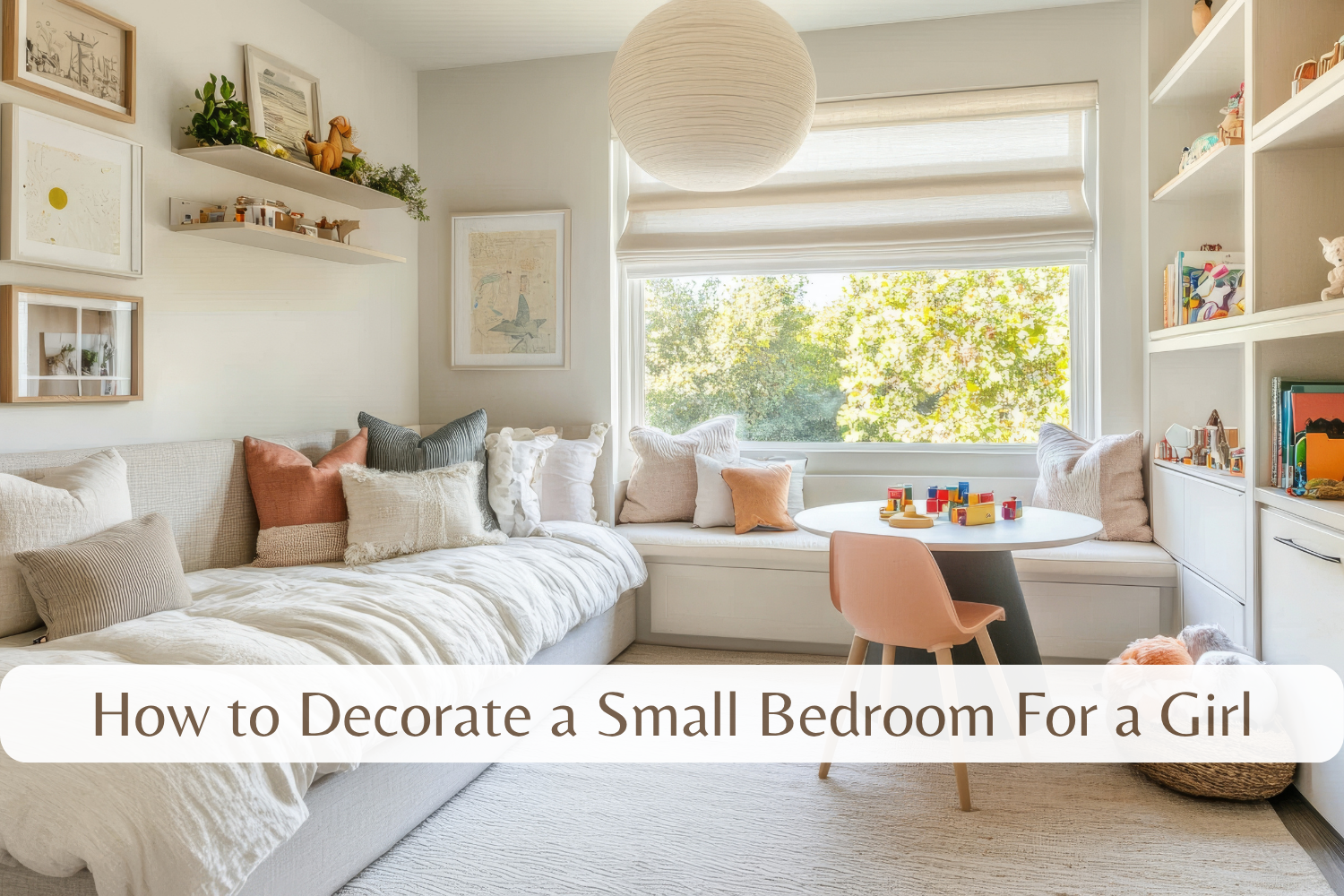
The Best Ways To Decorate a Small Bedroom For a Girl!
Understanding the Space
Before you buy a single piece of furniture or choose a paint colour, taking the time to understand your space truly will save you from costly mistakes and frustration down the road. This foundational step makes all the difference when learning how to decorate a small bedroom for a girl effectively.
Measuring and Planning
Start by grabbing a tape measure and recording every dimension—not just the floor space, but also ceiling height, window placement, and door swing. These numbers become your roadmap. I always create a simple floor plan on graph paper (or use a free online tool if you prefer digital). Mark where electrical outlets and light switches are located, as these will influence furniture placement more than you might think.
Pay special attention to any architectural quirks like sloped ceilings, alcoves, or built-in features. What might seem like an obstacle often becomes an opportunity for creative storage or a cosy reading nook. Natural light sources deserve extra consideration too—you’ll want to avoid blocking windows with tall furniture, and positioning the bed to catch morning light can make wake-ups easier.

Age-Appropriate Considerations
Here’s where things get interesting. A bedroom for a six-year-old has vastly different needs than one for a teenager, yet in small spaces, we need designs that can evolve. Think about your daughter’s current stage and what’s coming next.
For younger girls (ages 4-8), floor space for play remains crucial. They need accessible storage they can manage independently—think low shelves and bins they can reach without climbing. Their clothing storage needs are relatively simple, but toy storage can quickly become overwhelming without good systems in place.
Tweens (ages 9-12) start needing more sophisticated storage for hobbies, collections, and an expanding wardrobe. Homework becomes a bigger part of life, so a proper study area moves up the priority list. They’re also developing stronger opinions about style, so flexibility in decor becomes important.
Teenagers require maximum privacy and personal expression. Storage needs shift toward clothing, accessories, and tech gadgets. Study space becomes non-negotiable, and they’ll likely want areas for socialising with friends. The key is creating a design foundation that can adapt as these needs change without requiring a complete overhaul every few years.
Consider what can stay constant (like quality furniture pieces in neutral finishes) and what can easily change (like bedding, wall art, and accessories). This approach not only saves money but also teaches valuable lessons about working within constraints—something we all face regardless of room size.
Essential Space-Saving Furniture Solutions
When square footage is limited, every furniture choice matters. The secret to mastering how to decorate a small bedroom for a girl lies in selecting pieces that work twice as hard without overwhelming the space. Let’s explore the options that deliver the most impact.
Multi-Functional Beds
The bed typically dominates any bedroom, and in small spaces, it needs to earn its footprint. Loft beds remain one of my go-to recommendations because they essentially double your usable space. The area underneath becomes prime real estate for a study zone, reading corner, or additional storage. Modern loft designs have come a long way from the basic metal frames—you’ll find options with built-in desks, shelving units, and even small wardrobes integrated into the structure.
Captain’s beds offer another smart solution, especially for younger girls who might not be ready for the height of a loft. These beds incorporate drawers directly into the base, eliminating the need for a separate dresser. The deeper drawers work perfectly for bulky items like sweaters and jeans, while smaller compartments handle socks, underwear, and accessories.
For rooms that occasionally need to accommodate sleepovers, trundle beds provide sleeping space for a guest without a permanent floor space commitment. The lower bed tucks away completely when not in use. Some trundle designs even feature drawers instead of a second mattress, giving you storage flexibility.
Wall-mounted Murphy beds might sound extreme, but in truly tiny rooms, they’re game-changers. During the day, the entire bed folds up against the wall, freeing the floor for play, study, or exercise. Modern Murphy beds often include shelving or desk surfaces that remain accessible when the bed is stored.
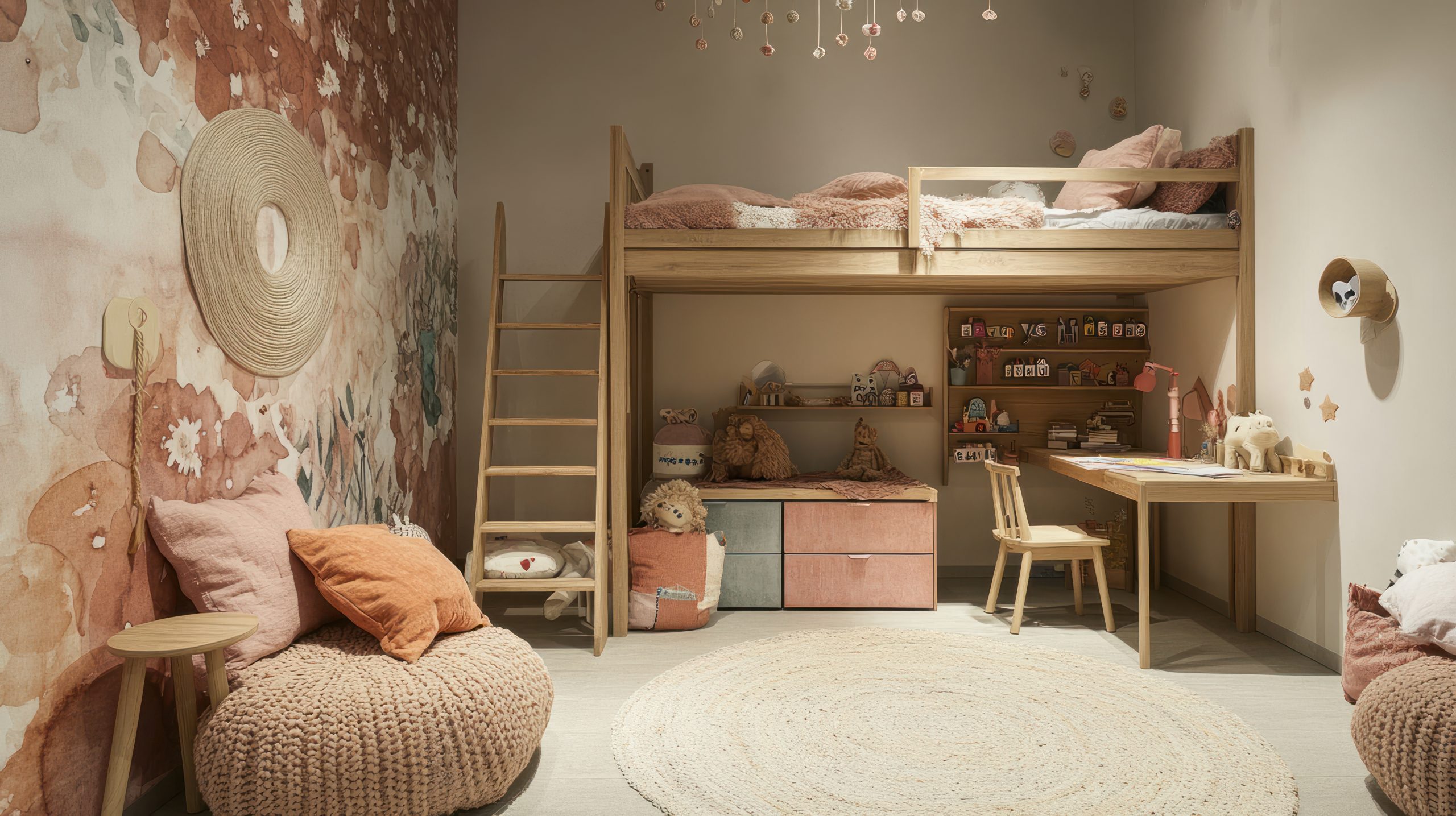
Smart Storage Solutions
Vertical space is your best friend in small bedrooms. Floor-to-ceiling shelving units maximise storage without eating up precious floor area. Open shelving works well for books and displaying items, while incorporating some bins or baskets on the shelves helps hide clutter. The key is maintaining a visual breathing room—not every inch needs to be packed.
Under-bed storage often goes underutilised. If you’re not using a captain’s bed, slide-out boxes or bins on wheels make this space easily accessible. Clear containers let you see contents at a glance, while fabric boxes maintain a softer aesthetic. Vacuum storage bags work wonders for out-of-season clothing or extra bedding.
Over-door organisers have evolved beyond basic shoe holders. You’ll find options designed for everything from hair accessories to school supplies. The back of the bedroom door can hold an incredible amount without taking up any space. Just ensure the organiser doesn’t interfere with the door closing properly.
When it comes to closets, built-in systems typically offer more efficient use of space than freestanding wardrobes. However, if you’re renting or can’t modify the existing closet, modular closet organisers can transform even the smallest closet into a storage powerhouse. Double hanging rods instantly double hanging space for shorter items like shirts and skirts.
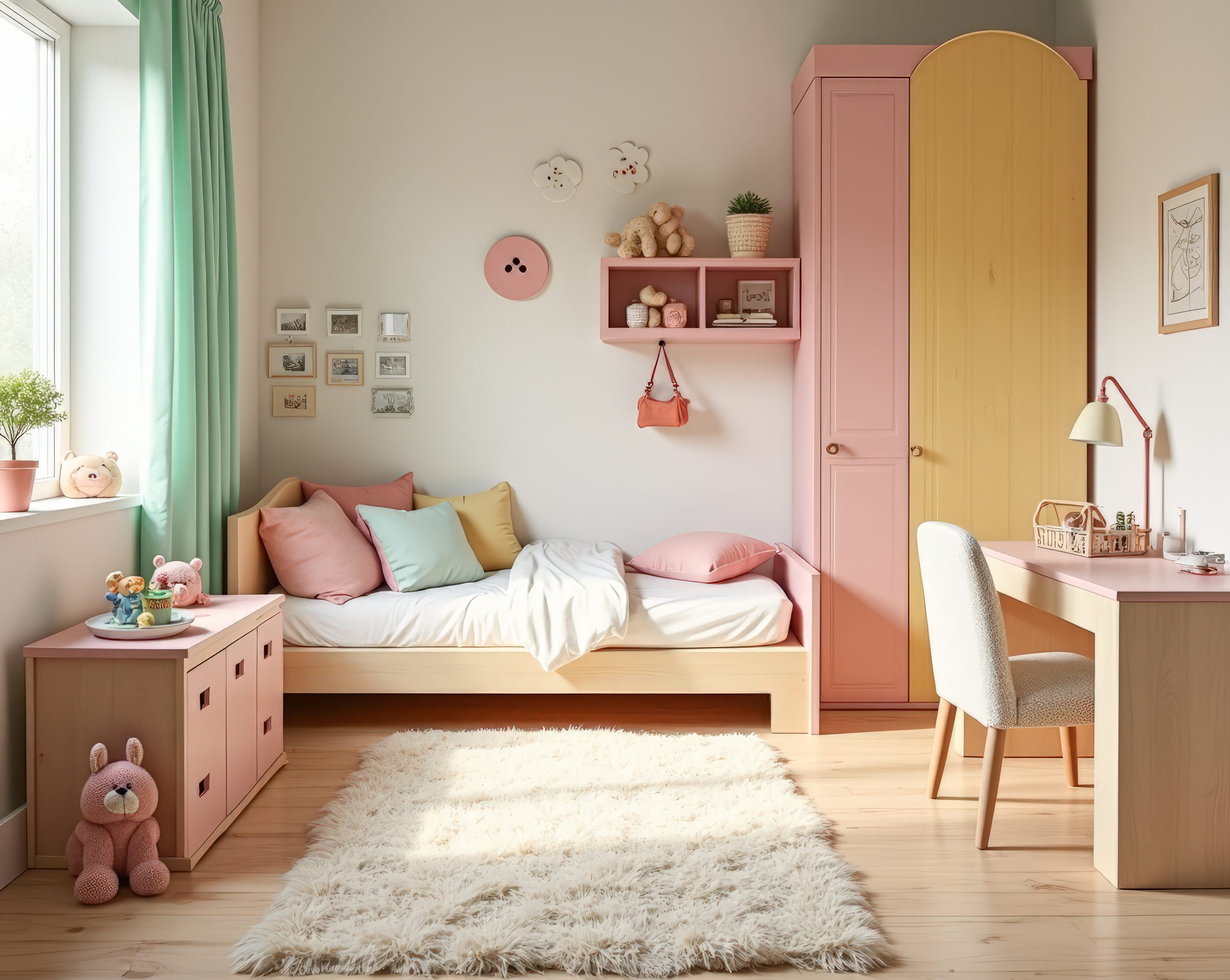
Compact Study Areas
Every girl needs a dedicated space for homework, crafts, or hobbies, regardless of room size. Wall-mounted desks provide a work surface without legs that clutter the floor. These can be as simple as a shelf with brackets or as sophisticated as fold-down units with integrated storage.
Corner spaces often go unused but make perfect study spots. L-shaped desks designed for corners maximise surface area while maintaining good traffic flow through the room. Pair with a compact, ergonomic chair that can slide completely under the desk when not in use.
For the ultimate in flexibility, consider fold-down desk options. These mount to the wall and fold flat when not needed. Some designs include small shelves or corkboards on the underside, turning the closed desk into a display area. This works particularly well in rooms where the study area needs to do double duty as a vanity or craft station.
Floating shelves above the desk area keep supplies within reach without cluttering the work surface. Install them at heights appropriate for your daughter’s reach, and consider adding small containers or desktop organisers to maintain order. Good task lighting is crucial—wall-mounted swing-arm lamps save desk space while providing adjustable illumination.
The beauty of these solutions is their adaptability. As homework needs increase through the school years, the study area can evolve without requiring major furniture changes. Start with the basics and add organisational elements as needed.
Colour Schemes and Visual Tricks
The right colour choices and visual strategies can make a small bedroom feel significantly larger and more inviting. While personal preference plays a role, understanding how colours and patterns affect our perception of space helps you make informed decisions when figuring out how to decorate a small bedroom for a girl.
Colour Psychology for Small Spaces
Light, neutral base colours remain the gold standard for small rooms—and for good reason. Whites, soft greys, and pale beiges reflect light and create an airy feeling. But this doesn’t mean the room needs to feel bland or impersonal. The trick is using these neutrals as your canvas and adding personality through accents.
If your daughter has her heart set on pink, purple, or any bold colour, there are smart ways to incorporate them without overwhelming the space. Consider painting just one accent wall in her favourite shade, or better yet, use that colour in bedding, curtains, and accessories that can easily change as her tastes evolve. Another approach is choosing muted versions of preferred colours—dusty rose instead of hot pink, or sage green rather than bright lime.
The ceiling often gets forgotten, but in small rooms, it matters. Painting it the same colour as the walls (or just slightly lighter) eliminates the visual break and makes the room feel taller. If you’re feeling adventurous, a very pale blue or lavender on the ceiling can create a dreamy, expansive effect.
Creating Visual Space
Mirrors work like magic in small bedrooms. A large mirror on one wall instantly doubles the visual space and bounces light around the room, creating a sense of depth and dimension. Position mirrors to reflect windows or attractive focal points rather than clutter. Full-length mirrors serve double duty for outfit checks while making the room feel larger.
Vertical elements draw the eye upward and emphasise height over limited floor space. This could mean floor-to-ceiling curtains (hung close to the ceiling, not just above the window), vertical striped wallpaper on an accent wall, or tall, narrow furniture pieces. The goal is to create visual lines that stretch the perception of space.
Maintaining colour flow throughout the room prevents the choppy feeling that makes spaces feel smaller. This doesn’t mean everything must match—rather, colours should relate to each other harmoniously. If the bedding features navy and coral, echo those colours in artwork, storage bins, or desk accessories.
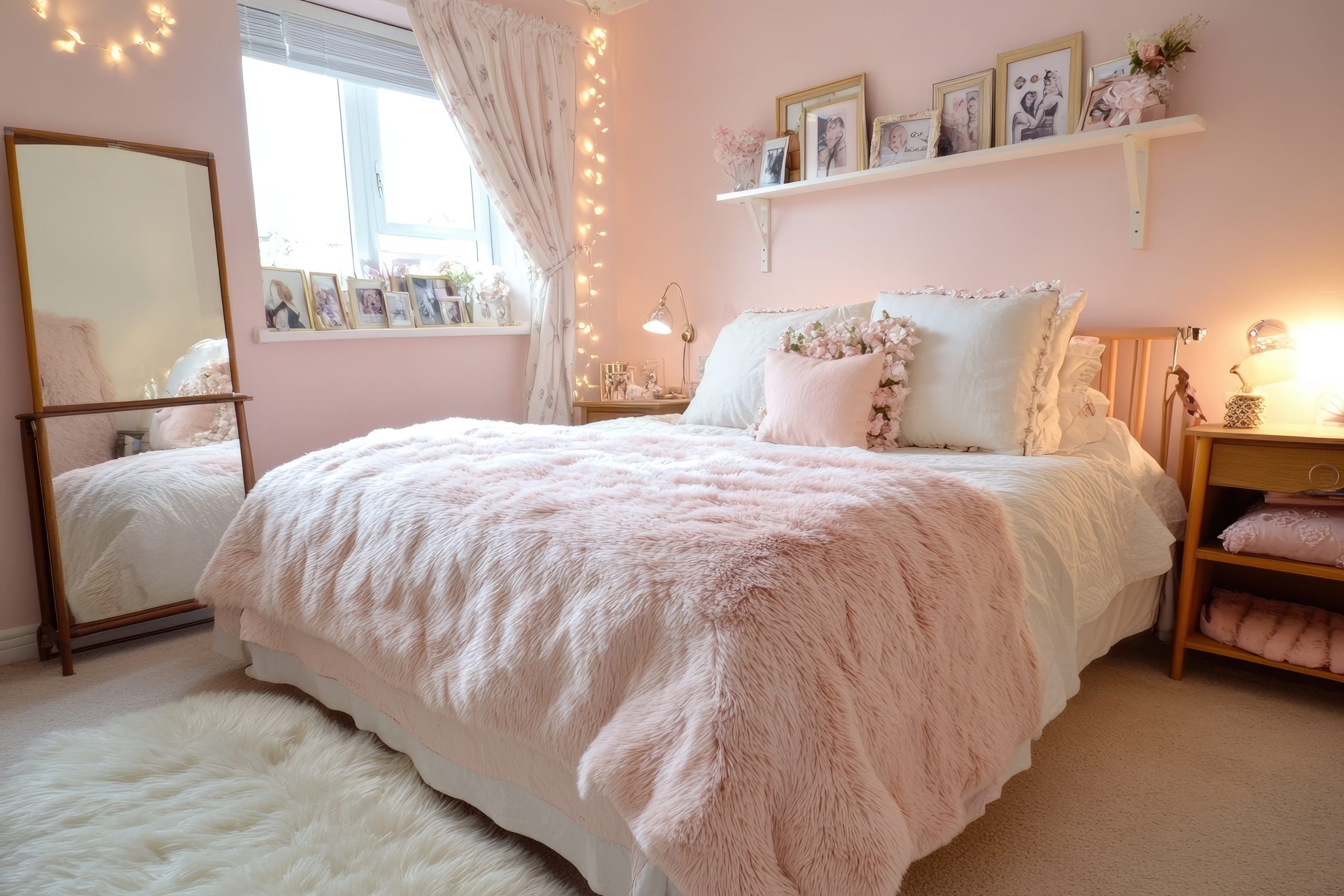
Lighting Design
Good lighting can transform a small bedroom from cramped to cosy. The layered approach works best: ambient lighting for general illumination, task lighting for specific activities, and accent lighting for the atmosphere. In small spaces, each fixture needs to multitask.
Wall sconces free up bedside table space while providing a reading light. Swing-arm styles offer adjustability without bulk. For younger girls, fun-shaped sconces (like flowers or stars) add personality without cluttering surfaces. Install them with independent switches for easy control.
String lights aren’t just for holidays—they create a magical ambience with minimal space impact. LED strips under floating shelves provide both accent lighting and subtle task lighting. Battery-operated options eliminate cord clutter and can go anywhere. Just avoid overdoing it—too many light sources can feel chaotic in small spaces.
Natural light deserves special attention. Keep window treatments simple and functional. Light-filtering cellular shades provide privacy while maximising daylight. If using curtains, mount the rod close to the ceiling and extend it beyond the window frame—this makes windows appear larger and allows maximum light when curtains are open.
Practical Decorating Strategies
Now that we’ve covered the foundational elements, let’s dive into decorating strategies that bring personality and function together. These approaches help you create a room that feels complete and intentional, not cluttered or overwhelming.
Wall Utilisation
In small bedrooms, walls become valuable real estate for both storage and self-expression. Floating shelves offer display space without the visual weight of bookcases. Arrange them asymmetrically for visual interest, mixing books with small plants, photos, and treasures. The key is leaving breathing room—aim to fill shelves only 60-70% for an organised, intentional look.
Pegboards have shed their garage workshop image and become stylish organisation solutions. Paint them to match the wall for a subtle look, or in an accent colour for pop. The beauty lies in their flexibility—hooks, shelves, and bins can be rearranged as needs change. They work brilliantly above desks for school supplies or near the door for bags and accessories.
Gallery walls let personality shine without taking up any floor space. Mix frames of different sizes, but stick to a cohesive colour scheme for the frames themselves. Include a combination of photos, artwork, quotes, and even small mirrors. The trick for small rooms is keeping the overall shape contained—a rectangular or square grouping feels more organised than pieces scattered across the wall.
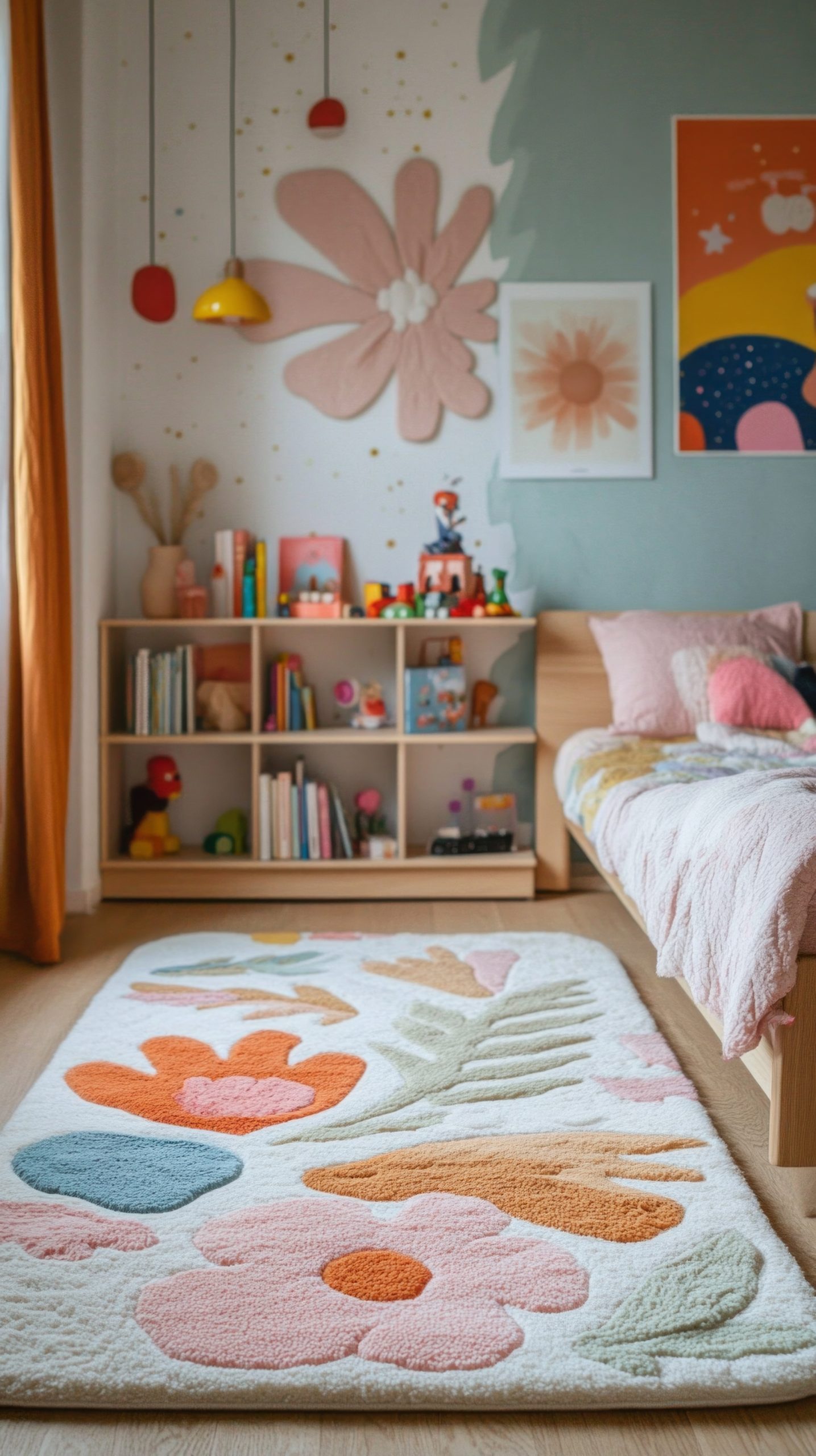
Textile Choices
Textiles offer the easiest way to update a room’s look without major investment or space commitment. In small bedrooms, they need to work harder by adding style while maintaining practicality.
Bedding sets the tone of the room, so choose wisely. Avoid overly busy patterns that can make small spaces feel chaotic. Instead, opt for simple patterns or solids with interesting textures. Layering different textures—a smooth duvet, chunky knit throw, and velvet pillows—adds visual interest without overwhelming patterns.
Window treatments affect both the room’s appearance and functionality. In small rooms, simplicity wins. Roman shades or roller blinds take up minimal space when raised. If using curtains, choose lightweight fabrics that don’t add bulk. Hanging them high and wide makes windows appear larger and maximises natural light.
Area rugs help define zones in multi-purpose rooms. In a small bedroom, one rug partially under the bed unifies the sleeping area. If space allows, a small rug in a contrasting texture can define a reading corner or play area. Just ensure rugs are properly sized—too small looks awkward, while too large can make the room feel cramped.
Personal Touches
The magic of learning how to decorate a small bedroom for a girl comes alive when you add those personal elements that make the space uniquely hers. The challenge is incorporating personality without creating clutter—every item should feel intentional and special.
Displaying collections requires creative thinking in small spaces. Instead of spreading items across multiple surfaces, create one impactful display area. Shadow boxes work wonderfully for small treasures like shells, pins, or tiny figurines. Floating shelves with picture ledges let her rotate artwork and photos without committing to nail holes. For larger collections, consider displaying only favourites and storing the rest in pretty boxes that can be switched out seasonally.
Rotating displays keep the room fresh without accumulating clutter. Create a simple system—perhaps a clipboard wall where new artwork can easily replace old, or a wire grid with clips for photos and mementos. This approach lets her room evolve with her interests without requiring major changes or additional storage.
DIY projects add personality without overwhelming small spaces. Focus on projects that enhance existing elements: decorating plain storage boxes, creating custom drawer pulls, or painting a design on the back of a bookshelf. These touches feel special without adding bulk to the room.
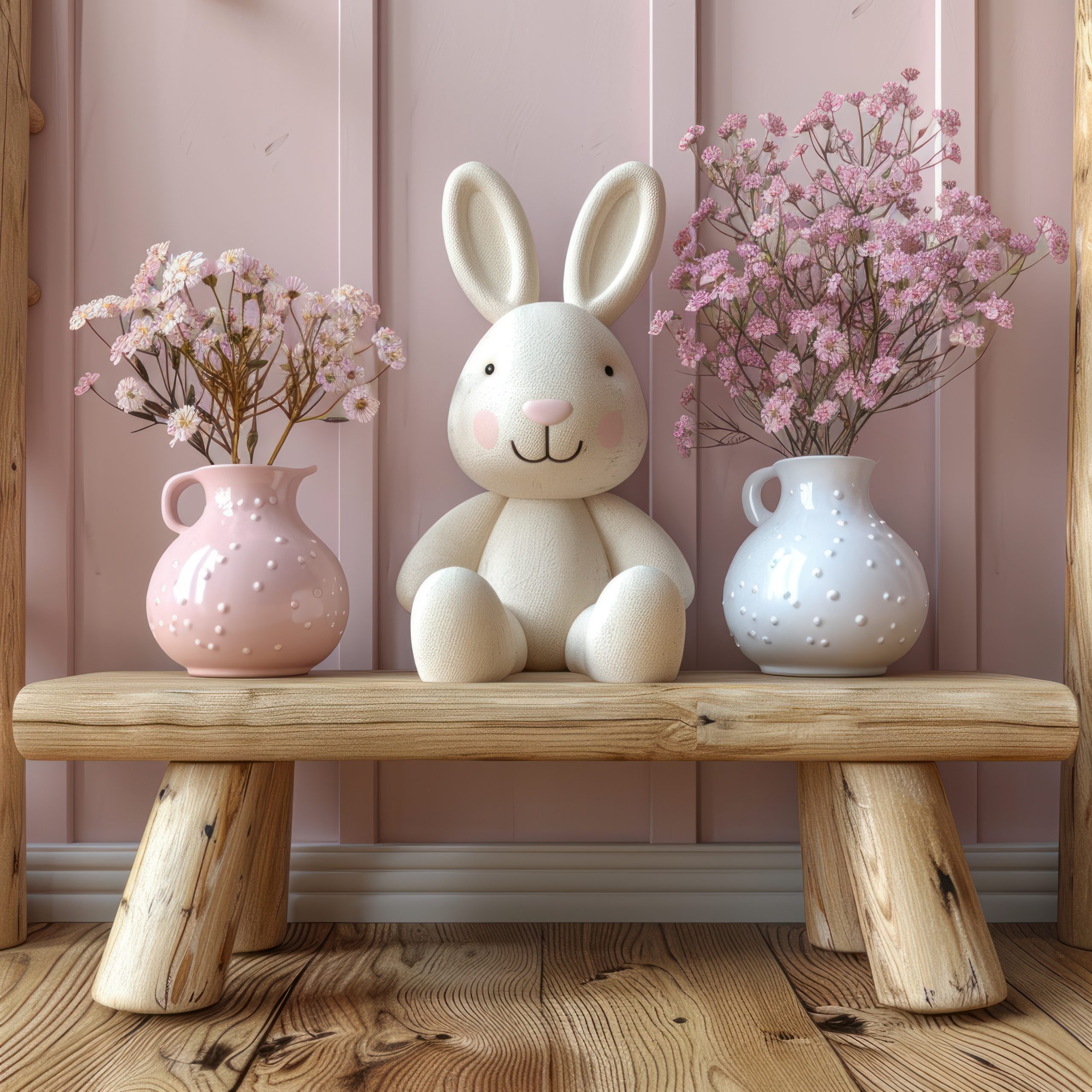
Organisation Systems That Work
Even the best design falls apart without solid organisation. In small bedrooms, systems need to be simple enough for daily use yet flexible enough to grow with changing needs.
Closet Maximisation
Most small bedrooms come with equally small closets, but smart organisation can triple their capacity. Start by installing double hanging rods—one high, one low. This immediately doubles hanging space for shorter items like shirts, skirts, and folded pants. Use the floor space for a small shoe rack or storage boxes.
Closet organiser systems don’t require major renovation. Affordable options include hanging shelves, over-the-rod baskets, and cascading hangers. The key is creating designated spots for different categories: school clothes, weekend wear, and special occasions. This makes morning routines smoother and helps maintain order.
Seasonal rotation keeps closets manageable. Store out-of-season clothing in vacuum bags under the bed or on high closet shelves. This practice not only frees up prime closet real estate but also teaches valuable lessons about living with less and caring for belongings.
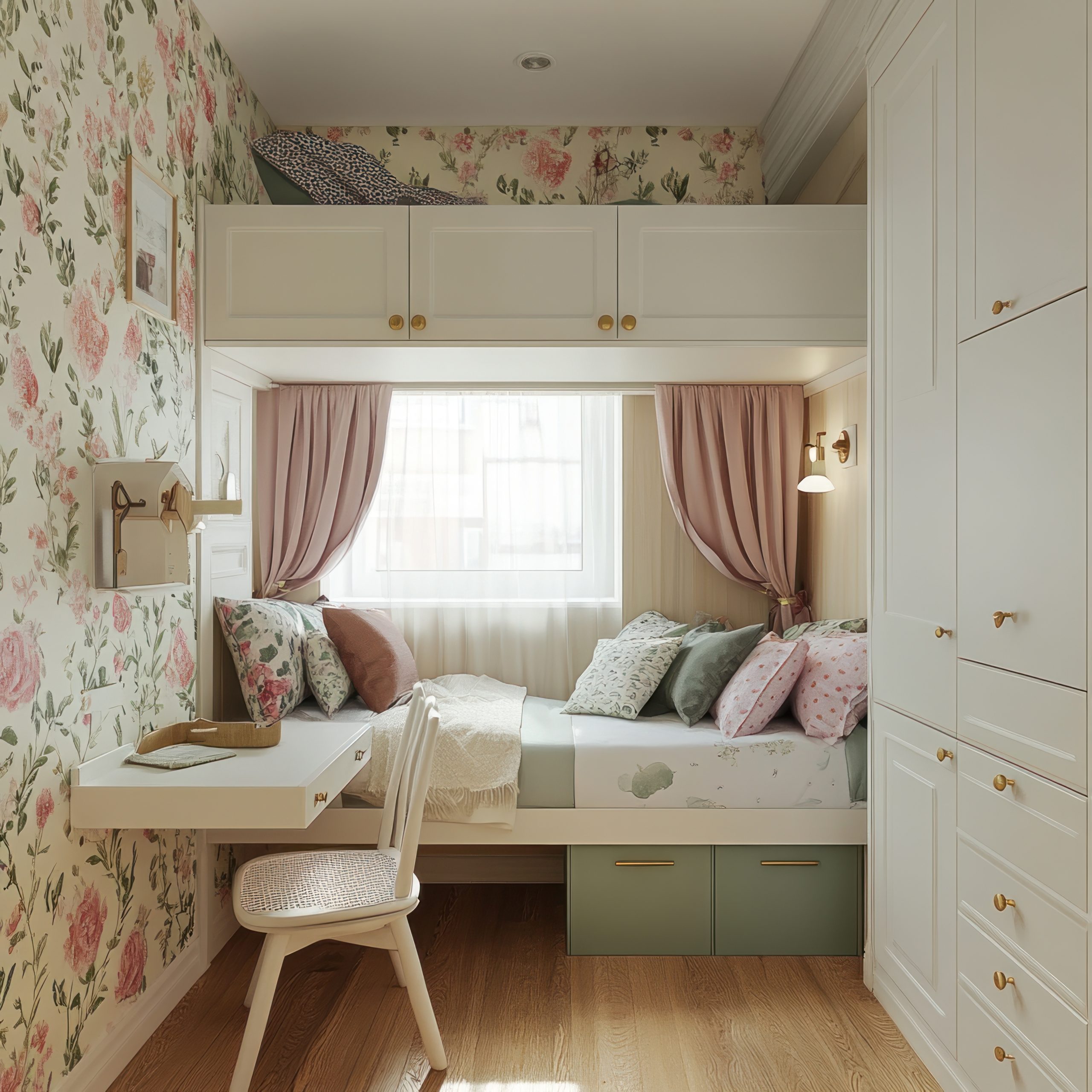
Daily Organisation
The difference between a room that stays tidy and one that constantly feels chaotic often comes down to simple daily systems. Every item needs a home, and that home needs to make sense for how the item gets used.
Create drop zones for everyday items. Hooks near the door for backpacks and jackets prevent pile-ups on the floor. A small tray on the desk corrals hair ties, lip balm, and other pocket items. These designated spots should require minimal effort—if it’s complicated, it won’t stick.
Homework stations need clear organisation to support good study habits. Desktop organisers keep pens and pencils accessible but contained. Magazine files work perfectly for organising papers by subject. A simple inbox/outbox system helps track assignments and prevent important papers from getting lost in the shuffle.
Morning routines run smoother with planning. Consider setting up a small station with outfit planning in mind—hooks for tomorrow’s clothes, a basket for accessories, a mirror for final checks. This reduces morning stress and keeps the rest of the room tidier.
Maintaining Order
The best organisational system fails without buy-in from its users. Age-appropriate methods make maintenance more likely. Younger girls respond well to picture labels and colour coding. Tweens might prefer prettier labels or chalkboard tags that they can update. Teenagers usually want systems that look more sophisticated—think minimalist labels or no labels at all if categories are clear.
Weekly resets prevent small messes from becoming overwhelming. Pick a consistent time—Sunday evenings work well—for a quick tidy session. This isn’t deep cleaning, just returning items to their homes and doing a quick declutter. Making it routine removes the drama and keeps the room functional.
Involve her in creating and maintaining systems. When she helps decide where things go, she’s more likely to keep them there. This also provides natural opportunities to reassess what’s working and what needs adjustment as her needs change.
Budget-Friendly Implementation
Creating an amazing small bedroom doesn’t require an unlimited budget. Smart planning and strategic choices can deliver high impact without breaking the bank.
Priority Investment Pieces
When budgets are tight, knowing where to splurge versus save makes all the difference. Quality matters most for items that see daily heavy use: the bed frame, mattress, and desk chair. These pieces should last through years of growth and use. A solid wood bed frame might cost more initially, but it will outlast several board versions.
Save money on elements that can easily change: bedding, curtains, wall art, and decorative accessories. These items let you update the room’s look as tastes change without major expense. Storage bins, picture frames, and desk accessories from budget retailers work just as well as expensive versions.
Consider the long view when making purchases. That trendy-shaped bookshelf might seem perfect now, but will it still work in three years? Neutral, classic pieces in quality materials provide better value over time.
DIY Solutions
Some of the best small bedroom solutions come from creative DIY projects. Repurposing existing furniture saves money and often yields more personalised results. An old dresser can become a desk by adding a wood top. Basic bookshelves transform into built-in-looking storage with crown moulding and paint.
Simple projects can have a major impact. Paint one wall with chalkboard paint to create an ever-changing art display. Use washi tape to create removable wall designs. Build simple floating shelves from boards and brackets. These projects let her participate in creating her space while keeping costs down.
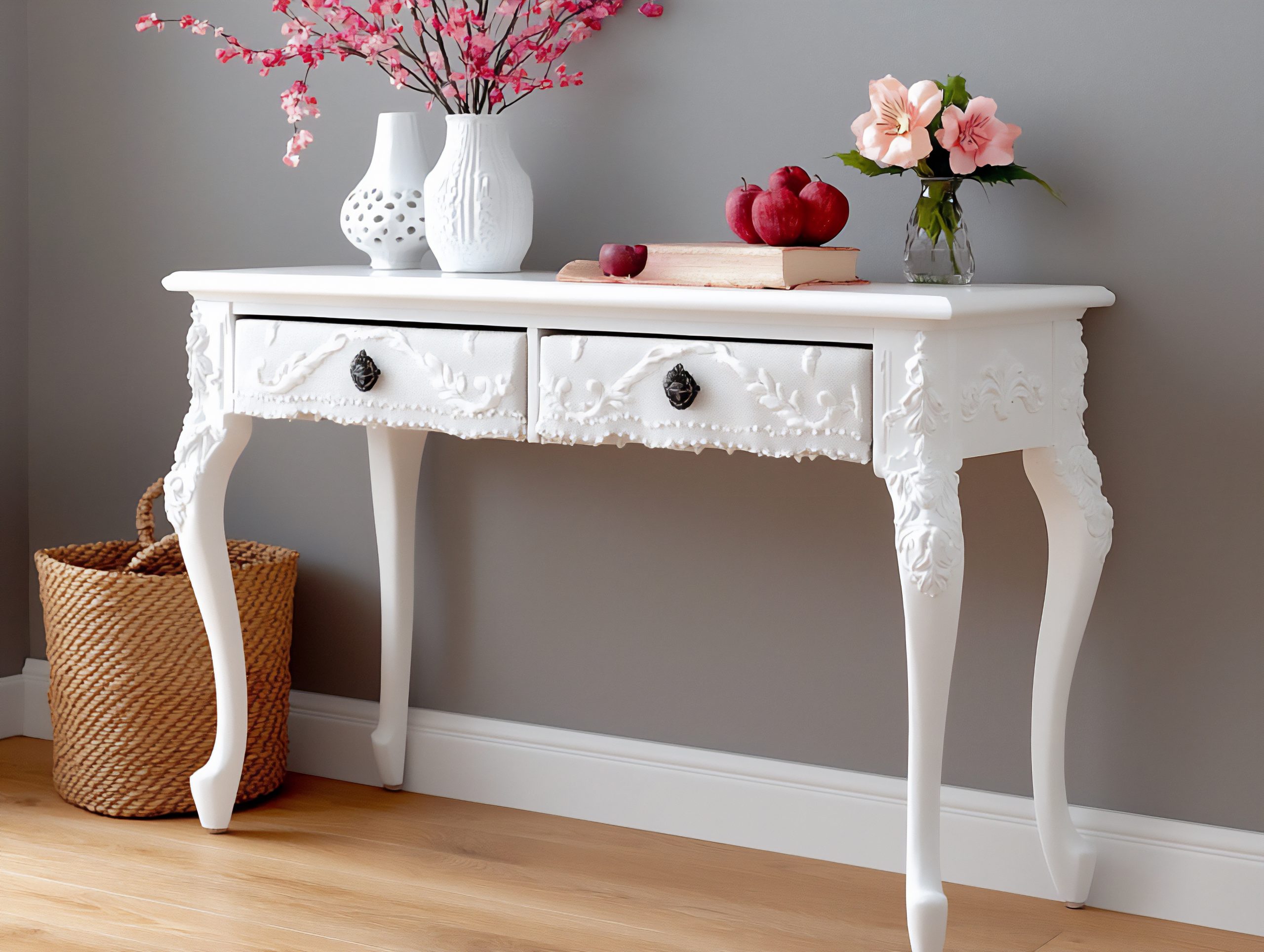
Shopping Smart
Timing purchases strategically can yield significant savings. Back-to-school sales offer great deals on desk accessories and organisation supplies. End-of-season clearances provide opportunities to stock up on bedding and decor. Black Friday, Boxing Day and End of Year sales typically offer the best prices on bedroom furniture.
Measure everything twice before purchasing. Nothing wastes money faster than furniture that doesn’t fit or function as expected in the actual space. Keep measurements on your phone for unexpected shopping opportunities.
Consider alternative sources: online marketplaces for gently used furniture, wholesale clubs for storage solutions, and craft stores for DIY supplies. Sometimes the perfect piece comes from unexpected places.
Room Layout Examples
Seeing how these principles apply to specific room configurations helps visualise possibilities for your own space. Let’s look at common small bedroom layouts and how to maximise each one.
The 8×10 Bedroom Layout
This classic small bedroom size presents clear challenges but also opportunities. The key lies in choosing appropriately scaled furniture and arranging it to maintain flow. Place the bed along the longest wall, ideally opposite the door, for the best sight lines. A twin or small full bed leaves room for other essentials.
In this layout, a corner desk maximises floor space while providing an adequate work surface. Wall-mounted shelves above the desk keep supplies handy without cluttering. A tall, narrow dresser fits better than a wide one, and over-door hooks handle daily-use items like robes and bags.
Traffic flow matters intensely in tight spaces. Ensure there’s a clear path from the door to the bed and desk. At least 24 inches of walkway prevents that cramped feeling and makes cleaning easier.
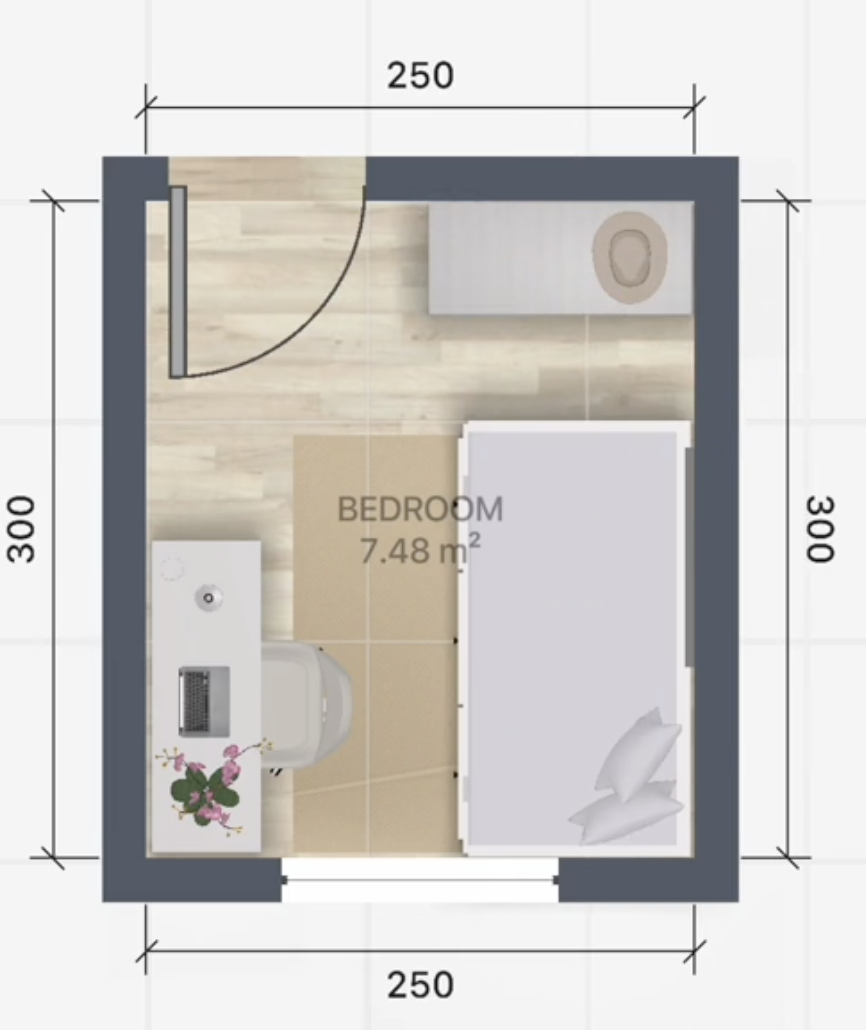
The Long Narrow Room
Narrow rooms require different strategies than square ones. Avoid lining all furniture along the walls like a bowling alley—this emphasises the tunnel effect. Instead, create zones that break up the length.
Place the bed at one end, perhaps with a low bookshelf at its foot to create separation. Use the middle section for a study area or reading nook. The far end might hold a dresser or play area. This arrangement creates distinct spaces within the room.
Horizontal elements help counteract the narrow feeling. A horizontal stripe on one wall, curtains hung wider than the window, or a row of pictures at eye level all help the room feel less corridor-like.
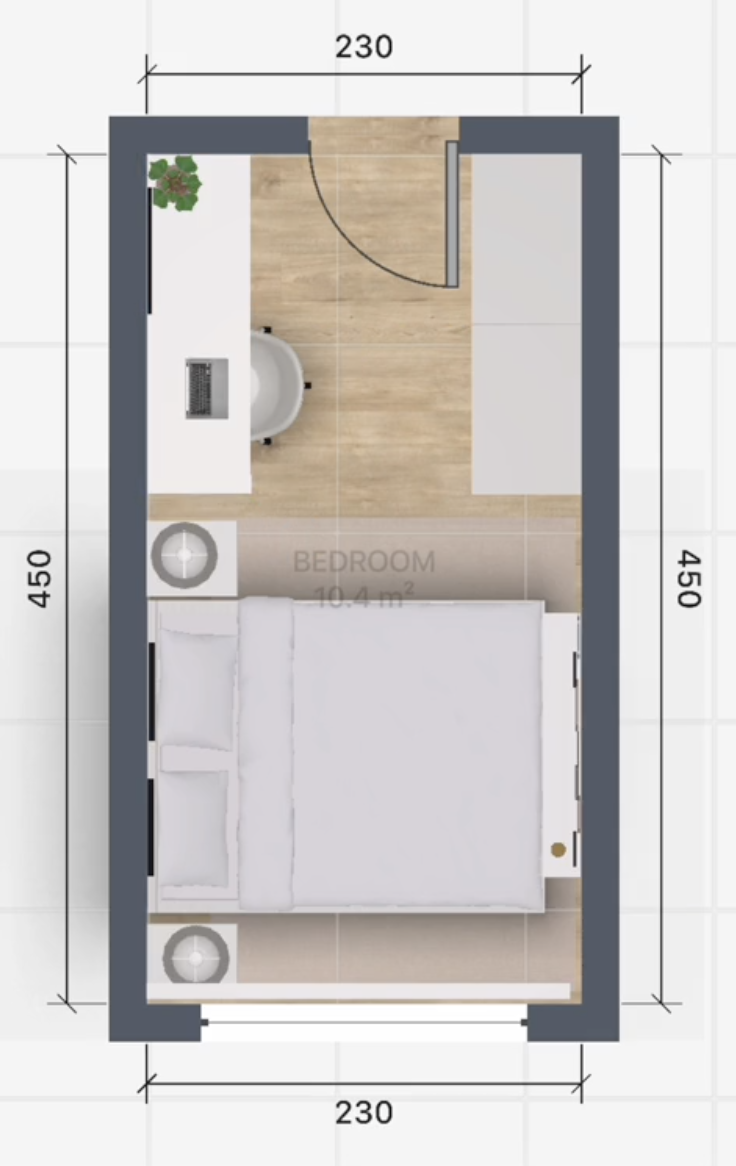
Rooms with Sloped Ceilings
Attic bedrooms and rooms with sloped ceilings require working with, not against, the architecture. Place the bed where the ceiling height is lowest—you don’t need full height for sleeping. This leaves higher areas for activities requiring standing room.
Built-in storage along knee walls maximises otherwise awkward spaces. Custom solutions aren’t always necessary—low bookshelves or storage cubes often fit perfectly. Use the highest part of the room for a desk or dresser where standing access matters.
These rooms often feel cozy rather than cramped when decorated thoughtfully. Embrace the unique architecture with strategic lighting that highlights interesting angles. Paint sloped ceilings the same colour as walls to minimise choppy feelings.
Creating a beautiful, functional small bedroom for a girl isn’t about having more space—it’s about using existing space intelligently. Throughout this guide, we’ve explored how to decorate a small bedroom for a girl using practical strategies that work in real life, not just in magazines.




